The 8-Step Tourism Marketing Strategy (Free Template)
By Kyla Steeves
Share this article:
- Facebook icon
- LinkedIn icon
- Twitter icon

You should never leave your marketing up to chance.
Sure, it’s important to be nimble to changing conditions, such as tourism marketing trends , algorithm updates, employee churn, and evolving technology. But if you’re always throwing tactics at the wall to see what sticks, you’ll likely waste resources, fall behind your competitors, and miss out on future opportunities.
Instead, it’s far better to have a well-thought-out marketing strategy in place.
Trial and error can come afterwards.

What is a tourism marketing strategy?
A tourism marketing strategy is a structured document that outlines your current position in the marketplace, what you hope to achieve going forward, and how you’re going to make that happen.
In other words, it provides a framework, so you’re not floundering around, wondering what to do next. All while giving you a way to track your progress so that you can be confident you’re heading in the right direction. And if things change drastically, as we witnessed in 2020, you’ll always have a foundation to build off and make adjustments.
So, are you ready to come up with a master plan? We’ll cover what goes into marketing strategies for travel and tourism, which includes a:
- SWOT Analysis
- Value Proposition
- Guest Personas
- Competitor Profiles
- Marketing Mix
- Budget & Resources
- Goals, Metrics & Activities
- Marketing Roadmap
Follow along by downloading our free 8-Step Marketing Strategy Workbook.
How to write a tourism marketing plan, 1. run a swot analysis.
A SWOT analysis is a fun exercise that identifies your company’s S trengths, W eaknesses, O pportunities, and T hreats.
Strengths and Weaknesses are internal factors that you can control, like your team, resources, and location. In contrast, Opportunities and Threats are external factors that come and go randomly, leaving you with no other choice but to react and adapt — such as travel trends, economic downturns, and your competitor landscape.
To help you with this step, it’s a good idea to round up key members of your team across departments. Why? Because each representative will bring a unique perspective, allowing you to get outside of your business owner bubble. For instance, your tour guides know your guests the best and can offer insight into what they’re thinking and feeling.
Once you have everyone together — in the same room or Zoom meeting — you can start the process. First, answer a few questions that relate to each element.
Like for Strengths, you can ask, “what does our tour company do well?” and “what do guests like about our experiences?” Weaknesses, “what areas of the business need improvement?” and “what do our competitors do better?” As for Opportunities, “is there an underserved market we can tap into?” and Threats, “ are there new regulations that impact our business?”
Try to answer at least five questions each, and then summarize what you come up with in a 2×2 SWOT grid for a visual overview.
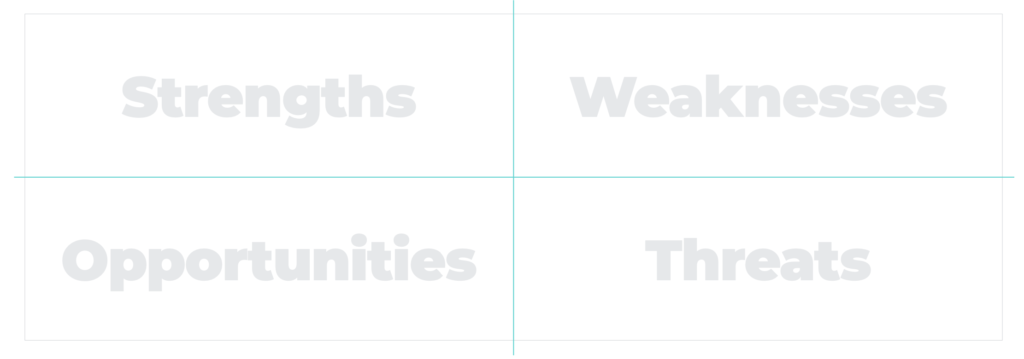
2. Identify your value proposition
After doing your SWOT Analysis, you should have a general idea of your value proposition — which is a simple statement that answers why someone should book with you instead of your competitors. Essentially, it’s what sets your travel business apart based on the desirable attributes you bring to the experience.
Your value prop is the most important piece in your marketing strategy, as it dictates your messaging and ultimately serves as the first thing guests look at when evaluating your brand with the “what’s in it for me?” mindset. That’s why it should be front and center on your homepage.
But it can be difficult narrowing down all of your unique qualities into one or two sentences. So, your best bet is to compile a list of features and benefits, along with the emotional value for each, and see if there are any obvious patterns.

Looking at the example above, you can see there’s a trend towards a local experience, so the value proposition for this company could be something along the lines of: Experience Hanalei Bay the local way with a paddleboard that looks nothing like a rental.
3. Create a guest persona
If you try to appeal to everyone, you’ll wind up appealing to no one. That’s probably one of the biggest tourism branding mistakes.
Instead, go after 20-35% of people most likely to enjoy your experiences. That way, you can be more effective with your targeting because you’ll understand what makes them tick, or better yet, what makes them book.
How do you go about doing that? Create a guest persona!
What’s a guest persona?
A guest persona is a detailed description of a fictional character that represents your ideal guest. It answers who they are, where they’re from, what matters to them, and where they hang out online.
Thinking of them as a real person before check-in will make it so much easier to craft personalized marketing messages they won’t be able to resist. Plus, you’ll know the best way to reach them. No more unanswered ads!
To create a guest persona:
- Start by combing through your booking data for common demographics like age, gender, geolocation, and language
- Refer to Facebook Audience Insights for psychographics, such as interests and hobbies, lifestyle, and online spending behaviour
- Send out a guest survey to get more details
Then, compile all of your information into a guest persona template with a stock image to put a face to the data. As well as a fun and fictional name — like Solo Travel Sarah , Corporate Catrina , or Vacation Dad Victor .

Now, you might only require one guest persona, but if you offer multiple experiences that appeal to different types of people, like tourism products for senior citizens , it’s best to segment your guests into a few personas seeing as your marketing tactics will change accordingly.
4. Create a competitor profile
The travel industry is tight-knit, so much so that you can even turn your competitors into partners. But that doesn’t mean you can’t still keep tabs on them.
Knowing what your rivals are doing is the best way to gain a competitive edge. Not only does it give you valuable insight into their strengths and weaknesses so that you can see how you stack up, but it also helps you stay one step ahead since you can spot potential threats and opportunities before they happen.
Similar to a guest persona, you can create a profile for your top three competitors, which should include the following marketing information:
- Their value proposition
- The experiences they offer and what they charge
- Who their target audience appears to be
- Unique features and benefits they highlight
- Overall rating on review sites, along with what their guests say about them
- The social media channels they dominate and the type of content they post
- What distribution channels they rely on
- Their domain authority score and top ranking keywords (use a tool like Moz Keyword Explorer to get this information)

It doesn’t stop there. After you’ve built your competitor profiles, you can monitor what they get up to in real-time by:
- Setting up Google Alerts to track mentions of them online
- Following their social media accounts
- And subscribing to their newsletter if they have one
You can always use a fake email address or Instagram account (AKA a Finsta) if you don’t want them to know you’re spying.
5. Develop a tourism marketing mix
A tourism marketing mix is a combination of factors you can control to influence a guest’s decision to book with you. Think of it as a broad guideline for how to market travel and tours so that everything works together seamlessly.
Historically, there are 7ps of tourism marketing, but since tourism operators are unique in the products and services they provide, we’ve stretched it to include eight.
What is a tourism marketing mix?
The experiences you offer and what’s included. Take note of everything that would go into the product description, such as duration, itinerary, special features, and other important details.
Where people can book your experiences. Traditionally, that would be your ticket office or travel agents, but there are now countless ways people can book — OTAs, email, chatbots, Facebook, your website. Figure out the number one place you want to direct prospects.
The price guests will pay based on the perceived value. Factor in what your competitors charge, how much it costs you to provide the experience, your revenue target, and where the market is heading.
4. Promotion
How you’re going to get the word out. Look at what has worked well in the past, where you already have some traction, new social media opportunities, and the best content format for your target audience.
The people who facilitate the experience. What are the standout qualities your staff has that align with your brand? What skills do your guides have that make the experience memorable, entertaining, and informative?
6. Planning
The measures you take to keep guests in the loop. How do you ensure they show up prepared? How do you tell them about your flexible cancellation policy? Are there any tactics you use to prevent refunds? What if you have to make unwanted changes?
7. Processes
The processes you have in place to guarantee guests get the experience they expect. Everything should run smoothly from the get-go. Consider ways to shorten check-in, stay on schedule, and make them feel valued.
The physical evidence that proves your guests had the best time. This could be in the form of professional photos or merchandise. But it can also be online reviews you encourage them to write on popular platforms.
6. Factor in budget and resources
Everyone wishes they could have marketing clout like the big-name online travel agencies. But the reality is you might never have the same budget and resources to run global campaigns. And that’s okay.
You don’t need deep pockets to make an impact. Thanks to the internet, you can use plenty of cheap marketing ideas to generate buzz around your brand. You just have to channel your creativity.
That said, be sensible with what you take on. For example, if you want to start a blog but don’t have time to commit to a regular publishing schedule, see whether someone on your team has the skills and bandwidth. If not, it isn’t in the cards for you right now.
So, check in with your budget for how much you can reasonably put towards various marketing activities while keeping in mind the software tools and staff you’ll need to execute successfully.
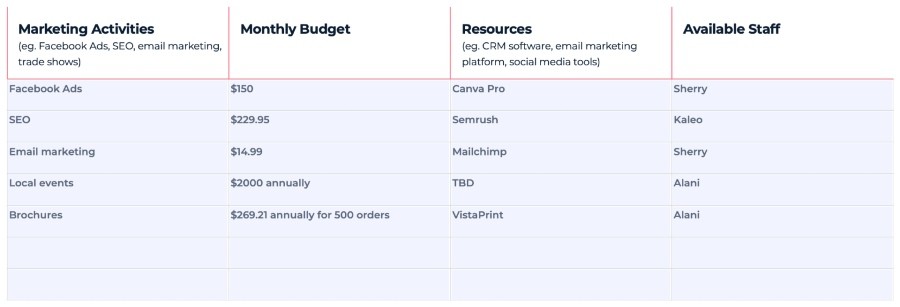
7. Pinpoint goals, metrics, and activities
Now that you know all that you know, give yourself something to work towards by determining what you want to achieve this year and how you’re going to make it happen. We suggest starting with the arbitrary number of four goals and key activities. Why?
Because if you chase too many rabbits at once, you won’t get the results you want. Instead, it’s better to prioritize goals that make sense for your business right now. That way, you can focus on doing a few things well, rather than lots of things badly that’ll only hurt your brand in the long run, which you’ll end up having to fix later anyway.
When it comes to setting marketing goals , it’s important to be SMART . Don’t just put your finger to the wind and say, “I think we should go this way.” Your goals should be:
- S pecific: clearly explains what you want to achieve
- M easurable: has a metric you can objectively measure
- A ttainable: something you have to stretch for, but still within your reach
- R ealistic: relevant to your business and where you want to go
- T ime-bound: when you want to accomplish the goal by
Here’s an example using the SMART method:
Increase organic website traffic 40% by the end of 2021 from getting 1000 visitors per month from Google.
How are you going to track your progress? As you can see in the above example, the number of website visitors is the primary metric. Now, many people will tell you to steer clear of vanity metrics — like traffic, followers, and shares — because they don’t directly impact your bottom line.
We couldn’t agree less. Marketing is about the long-game. While those metrics don’t always translate into transactions, they do strengthen brand equity, which in turn drives bookings over time because guests gravitate towards operators with extra oomph online.
The Content Marketing Institute puts it best : think of vanity metrics as optimization metrics. Instead of tying them to ROI, consider their overall value for better understanding your audience on specific channels.
For instance, if a particular social media post generates way more likes than average, it indicates something about that content resonates with your audience. You can pinpoint what that may be and replicate it in future posts or use it as a blueprint for creating effective Facebook ads .
For each goal you set, figure out one key activity that’ll help you hit it. Don’t be afraid to think big here. By that, I mean, come up with a significant marketing project that you and your team can chip away at — more on that in the next step.
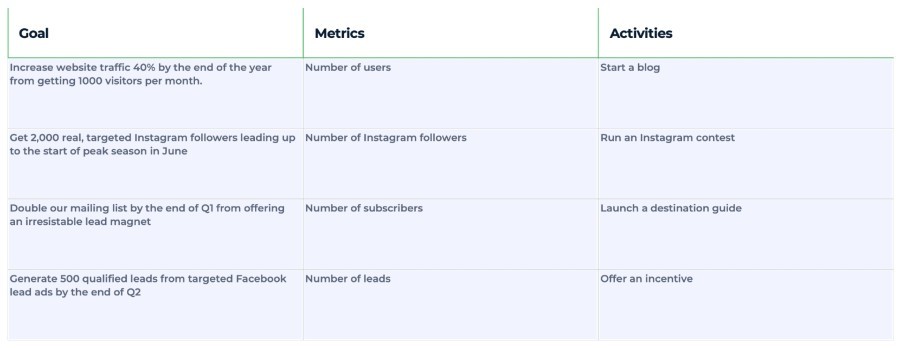
8. Plan your marketing roadmap
After you’ve assigned an activity per goal, break each one down into smaller, manageable tasks to complete from quarter to quarter. Using the example above, let’s say you decide to start a blog as your key activity.
In Q1, you’d get the ball rolling with a few foundation tasks. So, for building a blog, you might start with the following:
- Set up the blog on your website
- Develop a content strategy
- Research topic and keyword opportunities
- Create an editorial calendar
Then, you’d build from there for Q2 and so on.

Try starting with four tasks per activity. Unless you have a marketing team, it’s best not to bog yourself down with a marketing plan that will either a) pull your team away from other responsibilities or b) feel so overwhelming that you abandon it altogether.
With a list of tasks, you can then organize everything onto a visual roadmap however you see fit — just so long as it includes a way to assign staff and track work progress. For instance, you can create a makeshift roadmap if you’re savvy with Google Sheets or use a project management tool like Trello and set-up a kanban board workflow.
Where to go from here?
It’s time to go after it, of course! Just remember that your marketing strategy isn’t set in stone since anything can happen to derail your plans — as we learned the hard way in 2020. So check in with your marketing strategy workbook from time to time to make any necessary adjustments.
Ready to write down your marketing strategy and make it real?

Download the 8-Step Marketing Strategy Workbook
And take command of your brand with a well-thought-out marketing strategy that’s bound to get you results.
Related Articles

How to write ATV tour descriptions that drive bookings (with examples)
Learn how to write ATV rental descriptions with SEO-ready language that help you sell more bookings
- Marketing Strategies

Easy & effective pricing tactics for activity and rental operators
Ever wondered why at the movie theatre you’re likely to opt for a Large Popcorn instead of a Small or…
Search Blog
Subscribe to our newsletter.
Get tips and strategies to grow your business and impress your guests.
Blog Categories
- Booking Management
- Business Tips
- Guest Experience
- Operator Highlights
Tourism Marketing Strategies for 2021 and Beyond
Table of Content
What’s a marketing strategy, 14 tourism marketing strategies to help you succeed in 2021 and beyond.
We currently live in an experience economy and travel is the ultimate experience, wouldn’t you agree? That’s why the travel and tourism industry is set to be one of the biggest and most lucrative industries, globally.
According to the World Travel and Tourism Council (WTTC), travel and tourism grew by 3.9 percent in 2018; generates $8.8 trillion in revenue; and created 319 million jobs.
Those are some pretty big stats.
In order to compete in such a growing and lucrative industry, you need a rockstar marketing strategy. A strategy to get more eyes on your brand, and consequently, more customers.
That’s what we want to share with you in this article: the most up-to-date marketing strategies for tour and activity providers.
Before we begin, it’s important to make a distinction between a marketing strategy and a marketing tactic. (As we will strictly be covering marketing strategies in this article.)
A marketing strategy is essentially an overarching plan to achieve one’s marketing goals and objectives. In plain terms, it is a plan which guarantees that your marketing tactics are constantly contributing to your business goals.
Tactics, on the other hand, consist of highly practical marketing activities that you do every day. For example, posting to social media, writing blog posts, sending emails, etc.
That distinction is quite important. In this article, we will cover the top tourism marketing strategies for tour and activity providers.
1. Understand Your Customers
The first thing you need to do is to understand your ideal customers.
You need to know their demographic information; as well as what drives them to book and how they prefer to book. Questions to ask yourself during this brainstorming session are: What motivates them [your ideal customer] to travel? Where do they find information about their destination? How do they prefer to book? What annoys them about the research and booking process?
You can build at least 3 customer personas from your answers to those questions. You can then develop your branding, website and marketing strategy around the personas.
Keep your unique selling point and what drives you as a business in mind. You’ll need to convey that in an appealing way to reach your customers on a more personal level.
2. Optimize Your Website
Your website is the foundation for all your internet marketing efforts. As such, you should optimize it frequently to improve user experience and boost your conversion rates.
If your site performs poorly on mobile, is cluttered, too slow, or just too old, you definitely need to optimize it. You can test your site performance and speed with SEO Grader tool .

Perhaps you already do all that and your site is well-designed and well-functioning. But is it optimized for clicks and conversions? In that case, it may be a good idea to call in an expert (with industry knowledge) to help you make the right optimizations.
3. Focus on Mobile
According to Think with Google , 48 percent of US smartphone users are comfortable researching, planning and booking their entire trip on their mobile devices. The stats are similar in Europe: 45 percent of UK travelers and 44 percent of French travelers are comfortable planning and booking their entire trip on their mobile devices.
What does this tell us?
That the mobile experience should be as good as the website experience, if not better. Users need to be able to perform the same tasks, as comfortably, on their mobile devices as they can on the desktop version of your website.
To highlight the importance of the mobile experience, the same Think with Google study found that 33 percent of mobile users have a negative perception of a brand if their mobile experience is slow.
That says a lot.
4. Be Social
Social media is one of the most effective marketing channels for the tourism industry. That’s if you choose the right platform (where your customers are) and set up a strategy for each platform.
Facebook is perhaps the best social media platform for tour and activity providers, in terms of driving traffic to a website. It’s a crowded social network but you can find your tribe by using specific targeting and advertising. Here’s a detailed guide to rocking it on Facebook .
Instagram has one billion monthly active users . That’s a lot of people to get your brand in front of. Additionally, Instagram is a purely visual platform which makes it the perfect medium to market a destination.
Instagram launched IGTV in 2018 to host vertical long-term video content on mobile devices. The platform has experienced tremendous growth since its launch, as marketers and brands have become increasingly reliant on mobile video content to boost engagement metrics and conversion rates.
5. Live Video Marketing
Video marketing is king right now, especially for brands in the tourism sector. Travelers are frequently searching for videos of destinations they want to travel to. The problem is that they no longer want just pre-recorded videos.
Live streaming videos are getting more and more popular. Your potential customers probably love watching them (research shows that 82 percent of people prefer to watch live videos over social media posts ); while you get to lower your video production costs and show your authenticity as a brand.
Let’s take a look at a brand that gets live video streaming right: Hotel del Coronado in San Diego. They have a 24/7 live beachcam to show customers the beach fun they’re missing out on. They simply set up a camera and put on a live feed.
6. Send Those Emails
Your email list is the only (and most valuable) marketing asset you own. It is more powerful than other marketing strategies: It converts better than both social and search .
So if you don’t have an active email list, you need to start building one. You should ideally have a subscription form on your website to invite website visitors into your inner online community. From there, you can connect with them again and convert them into paying customers.
Here are the ins and outs of email marketing for tour and activity providers.
7. Accept Online Bookings
According to Zion Market Research , the online travel booking market was worth 765 billion USD in 2017 and is expected to generate 1,955 billion USD by 2026. In addition to that, over 57 percent of all travel reservations (including accommodation, tours and activities, flights, etc.) are made online.
Travelers have a lot of online resources and tools at hand to research, review deals, and choose the best travel deals for them. If you want yours to be one of the travel deals they book, you need to meet them where they are: they’re booking travel deals online so you need to facilitate online bookings on your website.
To start getting bookings online, you’ll need a booking system embedded to your website. Try Regiondo – it’s the most popular booking system in Europe that lets you grow your revenue and automate everyday reservation tasks. Book a demo and our experts will guide you through the platform and answer all your questions.

8. Tap into The Power of Reviews
Review sites like Yelp, TripAdvisor, and Google Local are perfect for building up an online presence and reputation.
Consider getting on one, or a couple of notable ones. Make sure to respond to all reviews – both negative and positive – to acknowledge that you’re listening and hearing every single feedback.
Reviews not only increase consumer confidence in your brand and products, but user-generated content, in general, can help boost your website ranking and conversion rates.
9. Blog, Consistently
Your customers want to hear from you . They want knowledge and insights from you, i.e. a blog. Blogging is a good way to tell stories, share unique insights about the destination, share travel tips, etc.
It’s also a good way to reel in your audience and advertise your expertise in the field. If you do not currently have a blog, create one and blog on a consistent schedule.
10. Get SEO Right
SEO is more important today for tour and activity providers than ever before.
A typical traveler’s journey today starts with Google. Tourists use search engines to research destinations, accommodation, transport, activities and tours, etc. If your offerings are not on the first page of search results, you don’t exist to a potential customer.
In fact, people joke that the best place to hide corpses is on the second page of Google search results because no one ever goes there.
So it’s important to show up in the top search results pertaining to your brand and offerings.
However, competition is high.
It’s not easy to rank on the first page of search engine results for many popular travel keywords. However, the effort is worth it because ranking high in Google search results for a specific keyword is better than running a Facebook ad or a TV commercial.
That is because people don’t use Facebook to buy products or services. However, when they search for specific products and services on Google, they often have an intent to purchase that product or service.
So, if they search for tours and activities in a destination you’re in, they are highly likely to book from you if you show up in the top results. You can check your SEO performance and keywords you are ranking for with our free SEO grader tool.
Cosmos , a tour operation company in Italy does SEO really well. They even show up in the top search results for the “tours in Italy” keyword on Google.
11. Set Up or Optimize Your “Google My Business” Listing
Speaking of SEO, Google My Business is a good place to start your SEO efforts, particularly local SEO.
For those unfamiliar with Google My Business (GMB), it is a free tool that enables you to control how your business shows up on Google Search and Google Maps . It specifically enables you to add your business name, contact details, location, hours, photos, etc. You can also monitor and respond to customer reviews, and see where and how people are searching for you.
And when people search for tours and activities near them, they’re usually ready to book the tour on that same day . Therefore, it’s important to create and optimize your GMB listing.
12. Focus on Experience
As mentioned earlier, we live in an experience economy and thus, in an era of experiential marketing. Experiential marketing is basically marketing that allows customers to experience your brand as opposed to you marketing your tours and offerings to a broad audience.
It’s also known as engagement marketing and it enables people to interact with brands one-on-one. Brands use physical branded materials to show customers what they offer and what they are all about on a more personal level.
You guessed it, it’s millennials that brought about experiential marketing; and at this rate, it’s only growing bigger. And it’s not only millennials that respond well to experiential marketing, older consumers do too.
Let’s take a look at an example of good experiential marketing: Travel Wisconsin . Travel Wisconsin ran a campaign to help potential tourists to imagine themselves doing various activities around Wisconsin. They used a funhouse mirror with local activities like tubing, and placed the activity in areas where people would be waiting, e.g. bus stops.
As you can see, experiential marketing is very different from traditional marketing strategies. Instead of spreading your message through traditional marketing tactics like print ads or commercials – messages that people don’t want to see or hear – you’re allowing people to interact with your brand in a fun way.
And guess what? Those are experiences people don’t want to miss out on.
13. Engage Micro-Influencers
Micro-Influencer marketing really came to the forefront last year and is still rising today. An increasing number of brands are relying on influencers with smaller and more targeted audiences (versus influencers with larger and broader audiences) to market their products or services.
Micro-influencers usually have 1,000-1,000,000 followers and specialize in a specific niche within their industry. As such, they often have higher engagement, more loyal followers, and better conversions on their social channels. Plus, they are cheaper than the big influencers.
14. Set Goals, Monitor and Optimize
When you begin executing some of these marketing strategies, you may notice sudden changes in your business. Those changes are a result of you getting to know your audience better and knowing which marketing strategies work best for you.
For example, you’ll know the types of blog posts your ideal customers like, whether they are responding well to your social strategy, and how they feel about your tour offerings and brand (via reviews).
You need to assess and analyze that data/feedback, and then make the appropriate changes to your marketing strategy.
For example, if a certain type of blog post is doing far better than other post types, consistently , then you should probably publish that type of post every week. Or perhaps you have many followers on Facebook but few on Twitter…you should review your social media strategy and make optimizations.
Those are the top tourism marketing strategies to consider implementing this year and beyond.
If the strategies in this post are executed correctly, you’ll get considerable results in terms of overall sales.
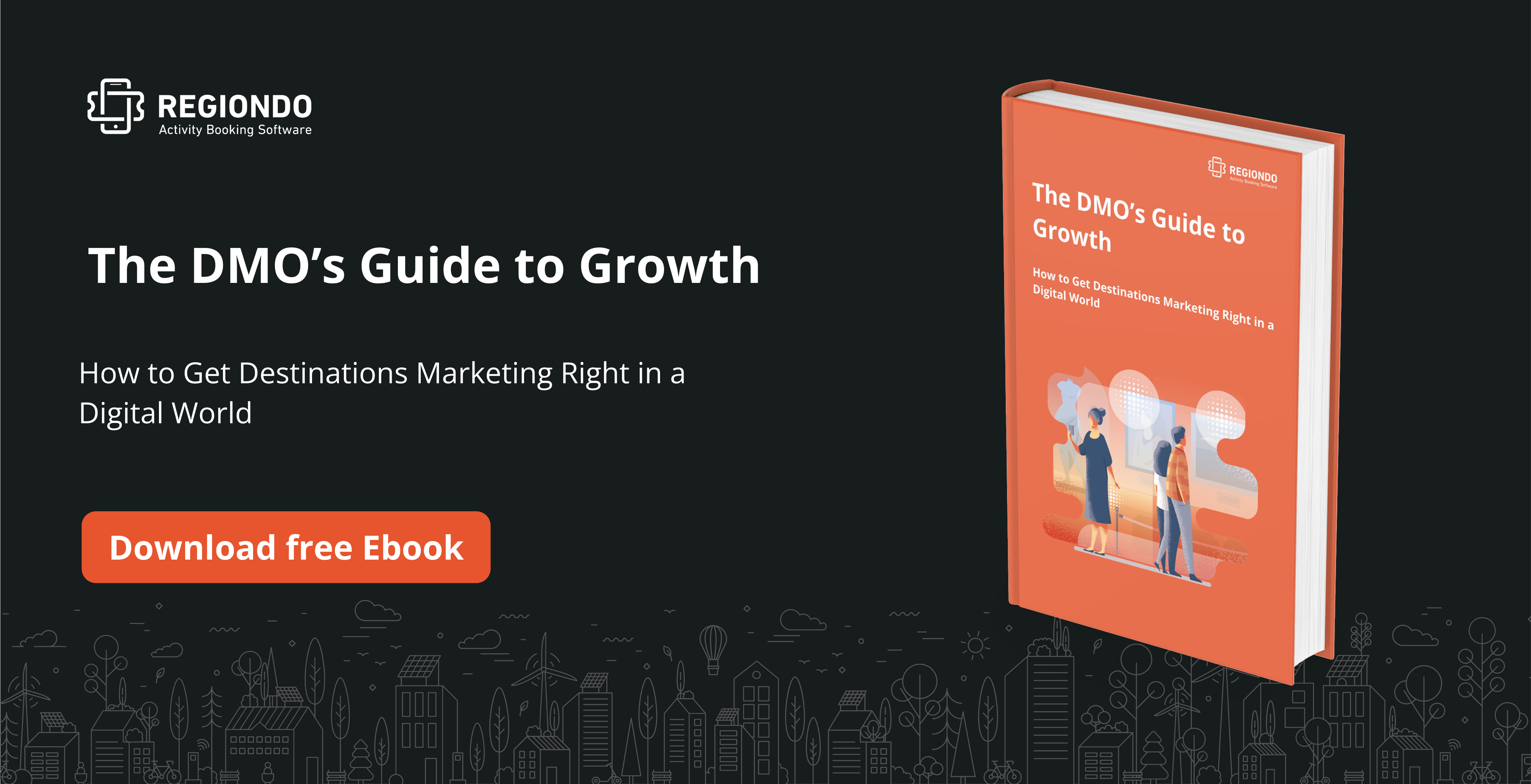
- Tips & tricks
Stay updated with Regiondo by signing up for our Newsletter

Get a personalized demo or create your free account now
Take your business to the next level with Regiondo - it's free to get started and you don't need a credit card.
- >
- Digital Marketing
Top 15 Tourism Marketing Strategies for 2024

As the travel industry undergoes rapid changes, it’s time to explore innovative strategies that will redefine your approach. From crafting personalized experiences to unlocking digital opportunities, join us on a journey to discover the keys to success in the dynamic world of tourism marketing.
In this article, we’ll unveil the top strategies that will not only keep you ahead of the curve but also elevate your business to new heights.
What is Tourism Marketing?
Tourism marketing involves promoting destinations, attractions, and travel services to potential customers. Effective tourism marketing doesn’t just showcase a place; it crafts an experience that beckons travelers and creates lasting memories.

What is a Tourism Marketing Strategy?
A tourism marketing strategy is a well-thought-out plan that outlines how a business in the travel sector will reach and engage its target audience. It encompasses a myriad of activities, from understanding your audience to embracing the latest technological advancements. In the following sections, we unravel the best tourism marketing strategies that will redefine your approach to attracting and retaining customers.
1. Understand Your Audience and Personalize Content
Before creating a thorough tourism marketing plan, dedicate time to understanding who you need to reach. Understanding your audience helps you shape strategies that match their likes, making sure your marketing not only gets noticed but also connects with potential customers.
Understanding your audience in the tourism industry involves thorough research and data analysis. Begin by creating detailed customer personas , considering factors such as demographics, interests, and travel preferences. Reach your audience on social media, conduct surveys, and analyze website analytics to refine your understanding of their evolving needs and preferences continuously.
Once you understand your audiences, you can craft unique and tailored experiences for them using the power of personalized marketing. This means curating marketing messages and offers that truly speak to people’s desires and attract your ideal customers.
2. Create a Content Marketing Strategy
A strong content plan is crucial for reaching potential travelers and leaving a lasting impression. Customize your content to match what your audience likes and needs. Consider crafting engaging blog posts that delve into the heart of your destination, offering immersive storytelling that goes beyond the typical travelogue.
Highlight local experiences, insider tips, and lesser-known gems, providing a glimpse into the authentic and captivating aspects of your locale. Additionally, practical guides, travel itineraries, and themed content, such as “Foodie Adventures” or “Off-the-Beaten-Path Escapes,” can serve as valuable resources, catering to diverse traveler interests.
3. Optimize Your Website For Search Engines
Mastering SEO in the tourism industry requires attention to key aspects that enhance online visibility and drive organic traffic.
- Keyword Research: Identify and target relevant keywords that align with travel trends and user search intent. Incorporate these keywords strategically into website content, meta tags, and headings.
- Optimized Website: Ensure your website is mobile-friendly for a seamless user experience across devices. Prioritize fast loading times to enhance user satisfaction and improve search engine rankings.
- Content Quality: Regularly update your website with fresh, high-quality content that reflects current trends and addresses user queries. Craft informative content that resonates with travelers.
- User Experience: Enhance the overall user experience by optimizing website navigation and layout. Implement clear calls to action to guide visitors through the booking or exploration process.
- Backlink Building: Cultivate reputable backlinks from authoritative sources in the travel industry. Focus on quality over quantity, aiming for links that enhance your website’s credibility.
In the end, keep up with SEO trends and algorithm updates to adapt your strategy accordingly. Use tools and analytics to check how well your website is doing and see if your SEO strategies are working.
A holistic approach to SEO will not only boost your website’s visibility but also contribute to a strong and sustainable online presence in the competitive landscape of tourism marketing.
4. Live Video Marketing
Live video marketing in tourism means using live videos to show off travel destinations and experiences as they happen. It’s like taking people on a virtual tour in real time . For example, hotels can give live looks at their rooms, or tour guides can show popular attractions as if viewers are there.
It’s more engaging and authentic, letting people ask questions and get immediate responses. This way, viewers can get a better feel for a place and what it offers, making them more excited and confident about choosing it for their travels.
5. Create Effective Social Media Strategies
Crafting an effective social media strategy involves more than just posting regular updates; it requires creativity, engagement, and a deep understanding of your audience. Let’s go over some tips and examples to help you make the most of social media marketing in the tourism industry.
- Platform Selection: First, you need to choose effective marketing channels. That means choosing the social platform where your target audience spends a lot of time. Instagram and Pinterest are visual platforms great for showcasing stunning destinations, while Twitter and Facebook can be used for sharing news updates and engaging with your audience.
- Consistent Branding: Use cohesive visuals, including logos, color schemes, and fonts, to create a unified and recognizable brand identity.
- Engaging Content Calendar: Develop a content calendar that includes a mix of content types. Share breathtaking photos, travel tips, and behind-the-scenes glimpses. Keep your audience engaged with a variety of content that reflects the diversity of your destination.
- User-Generated Content (UGC): Encourage your audience to talk about their experiences with your products or services. Reposting UGC not only showcases authentic interactions with your brand but also turns your customers into brand ambassadors.
Here are some examples of social media content you can use:
- Instagram Stories: Use Instagram Stories to provide real-time updates, share behind-the-scenes content, and conduct polls or Q&A sessions. For instance, take your audience on a virtual tour of your property, showcase local attractions, or share stories from satisfied customers.
- Facebook Live Events : Host live events on Facebook, such as virtual tours, interviews with locals, or live Q&A sessions. This provides an interactive experience for your audience and allows them to participate in real time.
- Interactive Contests: Run contests that encourage user participation. For example, ask followers to share their favorite travel memories, use a specific hashtag, and offer a prize for the best entry. This not only boosts engagement but also expands your brand reach.
- Travel Tips and Guides: Create and share informative content, such as travel guides, packing tips, or destination highlights. Position yourself as a valuable resource for your audience, providing information that goes beyond self-promotion.
- Visual Content on Pinterest: Utilize Pinterest to create visually appealing boards that showcase different aspects of your destination. Pin not only your content but also collaborate with influencers and pin user-generated content that aligns with your brand.
Try different types of content, see what your audience likes, and adjust your strategy to make the most impact on social media in the tourism industry. By diversifying your social media content and engaging with your audience authentically, you can turn your social media platforms into dynamic channels that not only attract potential travelers but also foster a community around your brand.
6. Accept Online Bookings
In the fast-paced world of travel, convenience is king. Accepting online bookings is not just a modern trend; it’s a fundamental aspect of successful tourism marketing. Streamlining the booking process and providing potential visitors with a user-friendly experience can significantly impact their decision-making and ultimately boost your business.
Why Accepting Online Bookings Matters
In a world where information is at our fingertips, modern customers seek instant gratification. Allowing them to book online provides immediate confirmation, meeting their desire for quick and efficient transactions.
Online bookings also break down geographical barriers. Potential visitors from around the world can explore your offerings and secure their reservations at any time, opening up your business to a global audience.
In the end, businesses that embrace online booking systems gain a competitive edge. Customers are more likely to choose a destination or service that offers the convenience of online reservations over those with a more complicated booking process.
Here’s how to implement online bookings:
- User-Friendly Website: Ensure your website is user-friendly, with a clear and intuitive layout. The booking process should be straightforward, with minimal steps required for customers to complete their reservations.
- Mobile Optimization: A significant portion of travelers use mobile devices to research and book their trips. Optimize your website for mobile users, providing a seamless experience across various devices.
- Secure Payment Options: Build consumer trust by offering secure online payment options. Clearly communicate the security measures in place to protect their sensitive information.
- Real-Time Availability: Implement a system that reflects real-time availability. This prevents overbooking and provides accurate information to potential customers, reducing the likelihood of dissatisfaction.
- Promotional Packages: Encourage online bookings by offering exclusive promotions or packages available only to those who book through your website. This not only incentivizes direct bookings but also adds value for your customers.
7. Email Marketing
Establishing and nurturing an email list is a foundational step, accomplished by strategically integrating sign-up forms on your website , during the booking process, and across various touchpoints. Offering incentives, such as exclusive discounts or travel guides, can entice visitors to subscribe, ensuring a growing pool of engaged potential customers.
Crafting an effective marketing list involves:
- Segmentation: Divide your email list based on factors like travel preferences, location, or past interactions. This segmentation allows for personalized and targeted customer communication, enhancing the relevance of your messages.
- Personalization: Leverage collected data to personalize your emails. Address recipients by their name and tailor content based on their interests or previous interactions with your brand, creating a more intimate and engaging connection.
Here are the types of emails you can use to elevate your tourism marketing efforts:
- Special Offers and Promotions: Share exclusive deals, limited-time discounts, or early access promotions to spark excitement and drive immediate bookings.
- Travel Tips and Guides: Provide valuable information about destinations, travel tips, and insider guides. Position your brand as an authority, offering insights that enhance the overall travel experience.
- Event Updates: Keep subscribers informed about upcoming events, festivals, or activities in your destination. This not only fosters anticipation but also positions your business as a source of comprehensive local knowledge.
- Personalized Recommendations: Analyze customer preferences and behaviors to offer personalized travel recommendations, showcasing your commitment to meeting individual needs.
- Post-Visit Follow-Ups: After a customer’s visit, send a follow-up email expressing gratitude, seeking feedback, and encouraging the sharing of their experience on review platforms. This not only strengthens customer relationships but also contributes to your online reputation.
In the bustling tourism industry, a well-crafted email campaign serves as a direct line to your audience, fostering engagement and loyalty. Tailor your emails to provide value, evoke excitement, and showcase the unique experiences your destination or service offers, ensuring that each communication contributes to a journey of anticipation and adventure for your subscribers.
8. Make the Most Out of Customer Reviews
In the realm of tourism, online reviews are vital for building trust . Utilize platforms like Yelp, TripAdvisor, and Google Local to establish a positive online presence. Actively encourage users to share their experiences and leave reviews, both positive and negative. Responding promptly to all reviews reinforces your commitment to customer satisfaction.
Additionally, user-generated content not only enhances your website’s ranking but also plays a key role in transforming potential customers into excited travelers. Make leaving reviews a seamless and encouraged part of your customer experience, fostering a community of engaged and satisfied visitors.
9. Focus on Experience
Embracing the concept of experiential marketing can transform the way your audience perceives your brand. Experiential marketing, also known as engagement marketing, is a strategy that prioritizes creating memorable, immersive, and shareable experiences for consumers.
Instead of merely promoting a product or service, this approach aims to engage the audience on a deeper level, leaving a lasting impression that extends far beyond a transaction.
Here are some ideas for executing experiential marketing in the tourism sector:
- Create Themed Events: Develop events or festivals that align with the unique aspects of your destination. For instance, if your location is known for its historical significance, organize a themed historical reenactment or festival to transport visitors to another era.
- Collaborate with Local Artisans: Showcase the local culture and craftsmanship by collaborating with local artisans. This could involve art exhibitions, workshops, or performances that highlight the authenticity and uniqueness of your destination.
- Interactive Tours: Move beyond conventional tours by introducing interactive experiences. Incorporate elements like treasure hunts, mystery tours, or interactive storytelling that actively involve participants, making their exploration of the destination not just informative but also entertaining.
- Culinary Experiences: Food is a universal language, and culinary experiences can be a powerful way to engage visitors. Offer food tours, cooking classes, or unique dining experiences that showcase the local cuisine, providing a sensory journey for your guests.
Now, here’s an example to inspire you in this ambitious but worthy endeavor. Airbnb’s “Night At” campaign allowed guests to book superior experiences, such as spending a night at iconic locations like the Louvre or Dracula’s Castle. This gave guests a unique place to stay and immersed them in an unforgettable experience.
10. Engage Micro-Influencers
Influencer marketing remains a potent tool in tourism marketing. Work with influencers who align with your brand and target audience. These influencers can provide authentic insights, reviews, and captivating content that resonate with their followers.
The key is to identify influencers whose values and interests align with your tourism offerings, ensuring a seamless integration that feels genuine to their audience. In particular, micro-influencers wield significant influence in niche markets. The genuine connections they have with their followers can amplify your reach and credibility within your niche.
11. Utilize Augmented Reality Technology
Augmented Reality (AR) technology presents a unique opportunity to engage and captivate your audience. Consider implementing virtual reality tours that allow potential visitors to explore your destination from the comfort of their homes. Provide interactive and immersive experiences that go beyond traditional brochures, giving travelers a taste of what awaits them.
12. Embrace the Power of Artificial Intelligence
As technology continues to evolve, Artificial Intelligence (AI) is becoming increasingly integral to effective marketing strategies. Incorporating live chatbots for customer service on your website can enhance customer experience, providing instant responses to queries and guiding potential visitors through the booking process.
The convenience and efficiency of AI-driven solutions contribute to an enhanced customer experience, setting your tourism business apart in a competitive market.
13. Customer Safety and Communication
Clearly communicate your commitment to safety through all marketing channels, outlining the specific measures in place to ensure a secure and enjoyable experience. Regularly update your audience on any changes, reassuring them that their well-being is paramount.
Transparency in communication about safety protocols not only fosters confidence but also establishes your brand as one that prioritizes the welfare of its customers. Consistently highlight this dedication at every interaction to leave a lasting positive impression on potential travelers.
14. Monitor Travel Trends
Keep a keen eye on evolving tourism marketing trends and consumer behaviors. The travel industry is dynamic, with preferences and interests changing rapidly . By staying informed and adapting your marketing strategies to align with current trends, you position your business as forward-thinking and in tune with the needs of modern travelers.
15. Set Goals, Monitor, and Optimize
Set clear business goals for your tourism marketing strategy, whether focusing on increasing online bookings, boosting social media engagement, or enhancing customer experiences. These goals serve as your guiding principles. To measure success, keep an eye on key performance indicators (KPIs) for real-time insights.
Regularly analyze data to identify trends and areas for improvement. Optimization is an ongoing process, ensuring your strategy remains flexible in the dynamic tourism industry.
Use tools like Google Analytics for detailed insights into website performance, user behavior, and campaign effectiveness. Also, social media analytics platforms like Hootsuite or Buffer help you monitor engagement, audience demographics, and content effectiveness across various channels.

Navigating the Future of Tourism Marketing: Final Words
Use the strategies outlined in this guide as a compass for success. From the foundational principles of understanding your audience to embracing cutting-edge technologies like AR and AI, each strategy contributes to a comprehensive and effective digital marketing strategy.

In tourism marketing, success comes from being adaptable and innovative. So, stay informed, use technology, and create meaningful experiences to position your tourism business for success in 2024 and beyond.
If you find yourself seeking expert guidance or assistance in elevating your tourism marketing efforts, don’t hesitate to reach out to Play Media. Our dedicated team is here to help you unlock the full potential of your brand in the dynamic world of travel and tourism.
Related Posts

- Chill Out the Competition: 6 HVAC Marketing Strategies That Drive Results
Want to see your HVAC business flourish, but you’re still not using digital marketing? Well, what are you waiting for? While traditional marketing is still effective, the power of digital is endless. And best of…

- Innovate Faster: Top 7 Brainstorming Tools to Use in 2024
If you've ever sat down with your team for a brainstorming session, you know how important this practice can be for brewing up brilliant ideas. Now, imagine taking that brainstorming game to the next level…

- Top 14 Mobile App Marketing Strategies for 2024
In the world of mobile apps, creating an exceptional product is only half the battle. The other half revolves around mastering the art of app marketing to ensure your creation reaches its full potential. After…

- The Ultimate Guide to User Acquisition: What It Is & How It Works
Growth is essential for businesses as it ensures their long-term viability and competitiveness in the market. It expands revenue, opens new opportunities, and allows for increased innovation and adaptability. But in today's competitive business environment,…
Latest Posts
- 18 Different Types of Influencers Based on Follower Count And Niche
The magazine of Glion Institute of Higher Education
- Master tourism marketing: strategies for a thriving business
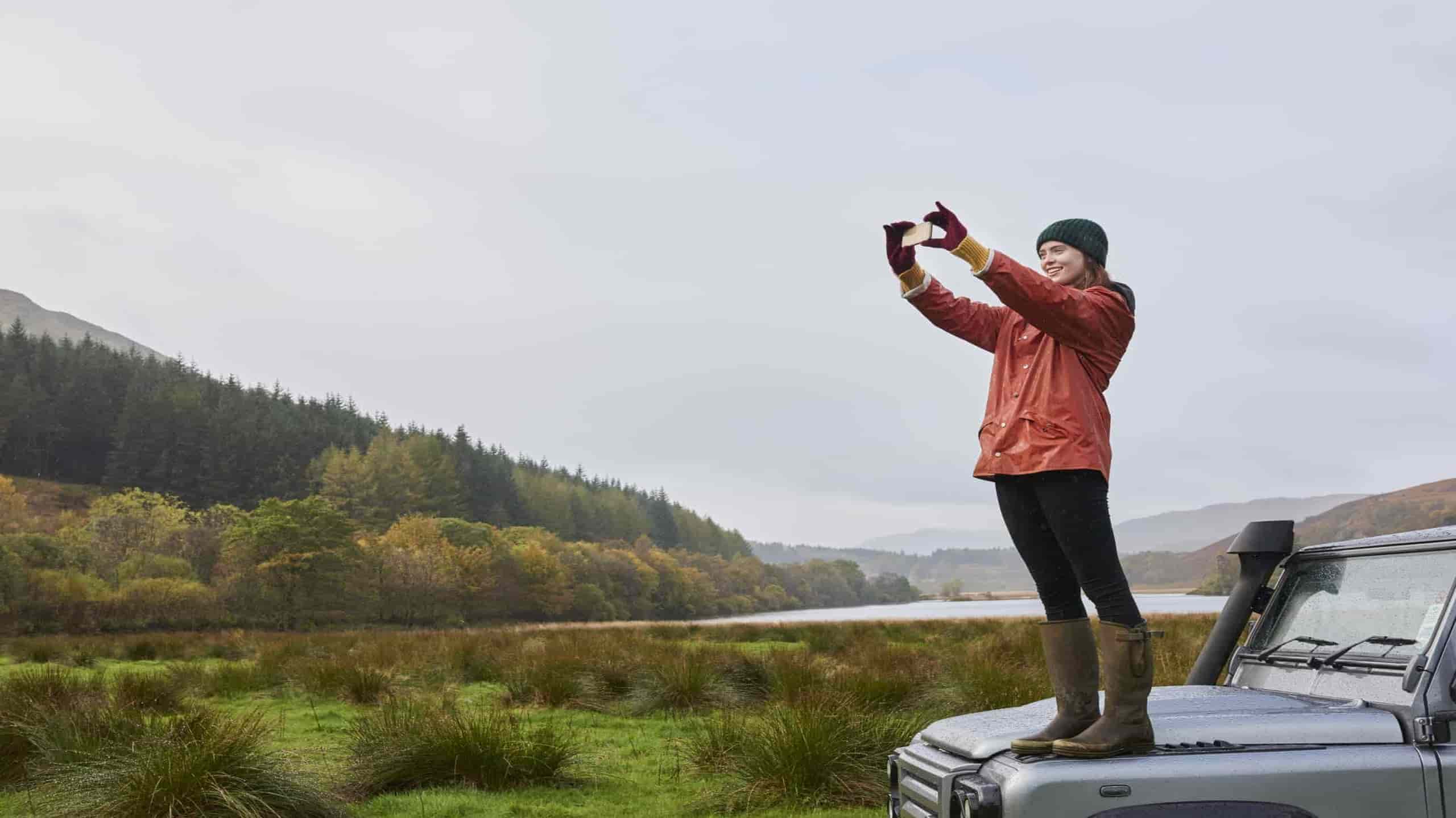
In an age where the tourism industry is constantly evolving, staying ahead of the competition and effectively marketing your tourism business has never been more crucial. Whether you’re a seasoned professional or just starting out in the field, this comprehensive guide is your passport to success. We’ll look at innovative marketing strategies tailored specifically for the tourism and hospitality industry , equipping you with the knowledge and tools to thrive in this dynamic and competitive field.
Introduction to tourism marketing strategies
Tourism marketing is aimed at potential customers from all over the world. To stand out in a crowded market, innovative strategies are crucial. Here’s what comprises effective tourism marketing:
- Understanding your audience : Tailor your approach to a range of demographics, connecting with them personally based on their preferences and interests.
- Developing a unique brand identity: Create a distinctive visual and narrative identity that encapsulates your organization’s values and essence.
- Creating engaging content: Go beyond static images, embracing blog posts, real-time social media updates, and vlogs to captivate prospects and entice them to visit.
Learn marketing with the best
Study with professionals at the top of their game who can share their expertise and provide the ideal start for a career that makes an impact in tourism.

Understanding your target audience
Effective tourism marketing begins with a deep understanding of your target audience. To attract and engage potential visitors, it’s vital to recognize their preferences and interests. Some are attracted to cultural heritage, while others seek vibrant nightlife or culinary experiences.
To understand a range of demographics, conduct thorough consumer research to identify patterns among prospective travelers, using data from customer surveys, travel agents, and online feedback. Build detailed personas to profile typical tourists who visit or may use your travel business. These personas become the foundation for shaping campaigns.
Key considerations:
- Focus on what tourists find attractive, not what you think they find attractive
- Rely on market research and verifiable data sources for insights
- Knowing customers’ wants and needs is vital for effectively tailored campaigns
- Stay adaptable to evolving visitor behavior and trends for sustainable growth
Understanding your audience and staying attuned to changing preferences are central to destination marketing, ensuring your efforts generate maximum impact.
Developing a unique brand identity

Oscar Wong/Moment Getty Images
Developing a distinctive brand identity is vital. As you deepen your understanding of what marketing is in tourism, you will realize how important it is for your destination or attraction to have its own niche.
Uniqueness: make your destination stand out
Think about the irresistible attractions your destination offers. Perhaps it’s culturally rich heritage steeped in history or maybe it’s rainforest and its wildlife. When you’re embarking on promoting travel to your location, make sure these distinguishing features are highlighted by using them as hooks in your tourism marketing strategies. The idea is to conjure up an image so potent that travelers instantly recognize it.
Relevance: aligning factors that attract tourists
One area where many falter is not aligning their offerings with market demands. Even if you can offer Northern Lights viewing spots in Norway, this won’t resonate with tourists if it doesn’t address their specific needs and interests. This is where consumer research in tourism comes in handy.
Consistency: keeping the promise
Once you’ve developed your unique brand identity and aligned it with what attracts tourists, make sure all marketing touchpoints — digital or offline — feature consistent messaging. Of course, varying content types necessitate a tweak in style, but the core substance should remain stable across all platforms.
Leveraging local listings
Local listings, like Google My Business and Tripadvisor, are vital for tourism marketing. They provide essential information and reviews to travelers. To maximize their potential:
- Claim your business listing on popular platforms
- Ensure consistent data across all platforms
- Encourage customer reviews and respond promptly
- Continuously analyze visitor feedback for optimization
Utilizing these platforms builds legitimacy and trust, as online reviews can play a significant role in travelers’ decision-making.
Creating compelling content
Engaging content is a powerful strategy in tourism marketing. It resonates with emotions, tells captivating stories, and showcases your destination creatively. Here are three ways engaging content can enhance your strategies:
- Storytelling: Share local legends and anecdotes to add depth to your destination’s persona, appealing to tourists’ emotions and curiosity.
- Visual content: Use high-quality images and enticing descriptions to showcase your destination’s attractions, and stimulate the interest of potential tourists.
- Interactive content: Offer virtual tours or quizzes to engage audiences at an experiential level, increasing their curiosity and perception of your destination.
Authenticity is essential in content creation, as it builds credibility in tourism marketing.
Engaging with social media platforms
In today’s digital world, social media is essential in tourism marketing. Different platforms cater to various demographics and interests, so you need to carefully tailor your social media posts to your target markets on each channel. Here are some key points to consider:
- Tailored content: Create content suitable for each platform, such as stunning images on Instagram and engaging travel stories on X (Twitter).
- Two-way interaction: Respond promptly to reviews and comments on social media, building loyalty among customers. You can also encourage user-generated content about your business, nearby tourist attractions, or about the customer service they experienced.
- Influencer collaboration: Partner with social media influencers to promote your destination to their followers.
- Hashtag movements and contests : Participate in trending hashtag movements and initiate contests or games related to destinations to boost visibility and generate positive publicity.
By understanding the unique features and demographics of each social media platform, you can meet travelers where they spend time and enhance your tourism marketing strategies.
Paid social media advertising
Paid social media advertisements are also important for any modern tourism company. They can be targeted to deliver messages to specific demographics. To make the most of social media advertising, here are a few key considerations:
- Identify your key demographics – know who you want to reach.
- Set clear objectives – understand what return on investment looks like.
- Develop engaging ad creatives – images or videos that represent what is being marketed.
- Monitor results frequently – adjust where necessary.
Sending email newsletters
Among the various tourism marketing strategies, email has emerged as an enduring tactic. Don’t underestimate the efficacy of a well-crafted email newsletter, as it stands at the intersection of providing information and subtle promotion.
Here’s a peek into how you can engage prospective travelers through strategic email newsletters.
- Schedule regularly : Choose a frequency – weekly, bi-weekly, or monthly – that aligns with your offerings and can be consistent. This gives subscribers something to look forward to while keeping your brand on their minds.
- Personalize communications : To make each subscriber feel acknowledged, use advanced CRM tools for personalization and tailored offerings based on previous interactions or noted preferences.
- Showcase compelling stories : Emotionally charged narratives about real guest experiences can stir interest and spark the imagination.
- Promote upcoming attractions : Give dormant clients reasons to reactivate by featuring must-see events or unbeatable seasonal deals.
- Incorporate reviews and testimonials : Customer reviews paint a convincing picture of what awaits future tourists. Their first-hand accounts — featuring praise or constructive feedback — can often build trust more effectively than promotional text.
Displaying online banners
An effective strategy in mastering tourism marketing involves harnessing the power of online banners. Banner advertising, a form of digital outreach, helps create awareness about your destination and may catch a potential tourist’s eye.
Here’s how best to take advantage of this potent bit of marketing strategy in tourism:
- Design with purpose : Creating compelling banner designs requires an understanding of what attracts tourists. Your banners must effectively communicate the unique appeal of the location you’re promoting. Does it offer historical and cultural significance? Is its natural scenery superb, or does it provide high-end luxury experiences?
- Location, location, location : Destination tourism is all about presenting prospective visitors with an irresistible locale they’d love to explore. Online banners should be strategically displayed on websites that your target audience visits, such as travel blogs or holiday booking sites.
- Clear call-to-action (CTA) : The most successful online banners have a clear CTA that prompts visitors to learn more or make bookings. This simple yet assertive instruction can enhance user engagement and increase bookings substantially.
- Mobile-friendly designs : Given our world has become increasingly mobile-centric, ensuring your online banners are optimized for mobile viewing is non-negotiable. This will also help make sure your mobile websites or advertisements are seen in search engines.
Offline promotional activities
Online marketing is powerful, but don’t overlook offline strategies. Traditional tourism marketing methods remain effective for personal connections with your audience.
Explore event sponsorships and collaborations at local events to showcase your brand. Print materials like brochures and flyers provide valuable tourism information and visibility in target areas. Roadshows educate potential customers in various locations, stirring interest. Utilize television and radio ads for wide-reaching awareness.
Tailor these techniques to your unique business needs while maintaining consistency across online and offline platforms.
Contextual advertising and SEO
Contextual advertising leverages relevance to attract tourists effectively. By placing your ads within content that aligns with travelers’ interests, you capture their attention when their tourism curiosity is at its peak. This targeted approach can lead you to your ideal customer base.
Search engine optimization (SEO) helps people find you in a sea of competitors when they go searching for what you offer online. Honing your site’s SEO capabilities can increase the likelihood of appearing in search results, so potential tourists can move toward becoming actual visitors.
Using promotional videos
In the quest to implement effective tourism marketing strategies, don’t overlook promotional videos. This type of content can effectively portray what attracts tourists to a particular location, destination, or service.
The power of promoting travel through video
Visual storytelling is compelling and engaging by nature. It can transport viewers directly into your destination’s most appealing spots. When considering marketing attractions or marketing a destination, creating videos that convey what is unique about your tourist spot can significantly boost your campaign.
How videos enhance tourism marketing strategies
- Showcase scenic views: Highlight the incredible views from the highest peak or show underwater adventures featuring vibrant marine life. Let viewers feel as if they’re already on an extraordinary journey.
- Provide local insight: Film a local tour guide telling stories about a historic castle or local attraction that you won’t find easily in travel pamphlets.
- Highlight experiences: Use this chance to display exhilarating possibilities like zip lining over lush forests, relaxing at a secluded beach, or sampling delicacies at markets
Try and ensure the video depictions will match expectations when tourists arrive.
Make your mark in luxury marketing for tourism
Combining expert tuition and exclusive internships, this Master’s gives you access to leaders at the pinnacle of their profession with opportunities to network and build your career.

Key considerations
Successful application of promotional videos as part of tourism marketing strategies hinges on factors such as:
- Solid marketing plans
- Quality production
- Meaningful narratives that highlight customer experience
- Resonating with your ideal customers
- Optimization for viewing on different devices
- Keeping up to date with tourism marketing trends
Mastering tourism marketing strategies is instrumental in developing a tourism marketing plan. They are also instrumental for sustaining the growth of a destination tourism business and ensuring success in a tourism or hospitality career .
Social media platforms offer many opportunities for promoting travel adventures and facets of the tourism business, from sharing compelling imagery to sharing delightful experiences, or even connecting personally with potential patrons. Get started on the journey to becoming a tourism marketing professional with a hospitality degree from Glion. Or read more about the tourism and hospitality industry in the new normal .
Photo Credit
Main Image: Plume Creative / DigitalVision via Getty Images

LISTENING TO LEADERS

BUSINESS OF LUXURY

HOSPITALITY UNCOVERED

WELCOME TO GLION.
This site uses cookies. Some are used for statistical purposes and others are set up by third party services. By clicking ‘Accept all’, you accept the use of cookies
Privacy Overview
FREE Q4 2023 CONTENT MARKETING PLANNER

Planning for Success
A successful tourism marketing plan is an essential and powerful business tool.
Not only does it focus on the why, how, when, where, who and what of your marketing, but also outlines the specific, measurable steps you need to take to achieve your goals.
AND, it will give your tourism business the power to:
- Plan for business growth
- Meet and exceed industry benchmarks
- Uncover gaps, opportunities and trends
- Keep your mission at the core of all activities
- Focus your resources and inspire your staff
- Create content and track, test, and tweak the ROI (return on investment)
- Measure the effectiveness of each marketing campaign
- Reach more of your target audience
- Boost your customer base
- And ultimately, increase sales
Marketing and specifically, having a PLAN for your marketing is crucial to the success of your tourism business. Think of it as your roadmap to success.
Sadly, many tourism business owners and operators settle for the less than inspiring goal – “ sell more this year than last year so we don’t go broke”.
The reasoning behind this attitude is most likely because they don’t know where to start with a marketing plan or know how powerful a business tool it really is.
To help your business succeed, we suggest working your way through these ten simple, yet highly effective steps below.
Within a short-time you will have created your 2023 Tourism Marketing Plan.
Step 1 – Reflect on the Previous Year
According to Harvard Business School , reflecting on what we’ve done teaches us to do it more effectively the next time around.
Conduct a marketing review of what worked, what did not, what could be improved and what scope you have for new initiatives. You’ll most likely be amazed at how much you did accomplish in 2022!
Also, use your history to work out your numbers – month on month income, room occupancy, new vs returning – whatever figures are important to your unique tourism business. These figures will become a driving factor in what defines the success of your marketing in 2023.
Use this review to create in-house benchmark figures for crucial elements such as customer attraction, satisfaction and loyalty – whatever results you’d like to exceed.
Step 2 – Research Your Industry
Researching the current market trends and actual figures in tourism helps gauge the climate in which you are doing business.
By reviewing your industry trends, competitor successes and failures you can avoid repeating any mistakes made and capitalise on any successful initiatives.
You can also benchmark your unique tourism offering against industry standards to provide another measurement for success.
TIP: To gain this type of information you may need to undertake the research yourself. However, first stop is your regional Visitor Information Centre, as well as local and state Tourism Industry Associations.
Tourism Industry averages – tourism research
Information supplied by South Australian Regional Tourism Profiles
Step 3 – Analyse Your Competitors
With the advent of technology and the online world, small tourism operators can know more about their competition than ever before.
A competitive analysis covers the strengths and weaknesses of your competition.
By performing a thorough competitor analysis, you will be able to:
- Identify gaps in the market
- Develop new products and services
- Uncover further market trends
- Market and sell more effectively
Keep in mind, there are two types of competitors you may be facing.
- Direct competitors are businesses that offer a product or service that could pass as a similar substitute for yours, and that operate in close proximity.
- Indirect competitors provide products that are not the same as yours, but could satisfy the same customer need or solve the same problem.
TIP: These are some common questions to ask yourself when undertaking a marketing competitor analysis:
- Who are your competitors – direct and indirect?
- What is their product or service offering?
- How much market share do they have?
- What were their past marketing strategies?
- Are they using the same strategies now?
- How aggressive are they on the advertising front?
- How competitive are they?
- Are their strengths and weaknesses the same as yours?
- How big of a threat are they to you?
- How do their strategies affect your business?
Step 4 – Write Your Mission Statement
While so often overlooked, your mission statement is crucial as it shapes the culture of your individual business.
It is what you do/the core of the business and from it comes the goals and finally, what it takes to reach those goals.
It drives the business by conveying your reason for being to your staff, stakeholders and guests.
Every piece of content you create should be rooted in your mission statement, from the tone of voice to the call-to-action.
Mission statement questions look like:
- What do we do?
- Whom do we serve?
- How do we serve them?
Examples from the tourism industry
TripAdvisor “To help people around the world plan and have the perfect trip.”
Virgin Atlantic Airways “To embrace the human spirit and let it fly.”
Tourism Australia “To make Australia the most desirable destination on earth.”
TIP: Your marketing and content strategy should support your business mission statement — think of it as the HOW of what you do.
This helps you stay on track, true to your brand and true to your goals.
Step 5 – Undertake a SWOT Analysis
A SWOT analysis refers to strengths, weaknesses, opportunities and threats and is a simple yet powerful planning tool.
It is one of the easiest ways to learn more about your business and where it sits in the external and internal environment.
SWOT divides an overall environmental analysis into two components: internal issues (strengths and weaknesses) and external issues (opportunities and threats).

FURTHER READING: Tourism SWOT Analysis: A Step-by-Step Guide with Examples
Step 6 – Determine Your Ideal Target Audience
An essential element in your marketing plan is knowing who you want your marketing campaigns to connect with.
You don’t just want anyone and everyone – you want to create a very clear picture of who your ideal customers are.
They’re the ones your marketing messages will hit home with, who love and appreciate what you offer and will happily pay the price you charge.
You may have several audiences, but the clearer you become, the easier it is to:
- Understand their why for choosing your tourism business
- Shape your product and service offering
- Set your price points
- Align the efforts of your management, marketing, sales and customer service teams
- Know what types of marketing campaigns will be most attractive
- Understand and easily hone in on particular benefits and features in your marketing
- Create key messages and content that truly resonates and connects with your ideal audience
TIP: Start by creating an ideal customer avatar for your tourism business offerings. This will enable you to relate on a personal level to your target audience and will set the tone, content and marketing strategies. A great place to start is by using The HubSpot Ideal Customer Avatar (Free Tool).
Step 7 – Define Your 4Ps
Your marketing mix is the combination of factors your small tourism business can control to promote your brand, attract and influence customers to purchase your product.
The 4Ps are a central part of your marketing plan and are made up of:
The easiest way to define your 4P’s is to ask yourself a series of questions relating to each element.
- What does your customer want from your product or service? Does it satisfy a specific need?
- How and where will your customer use your product?
- What features and benefits does your product have?
- How is your product different from the offerings of your competitors?
- What does your product look like in terms of colour, shape and size?
- What is the name of your product?
- How will you brand your product?
- What is the customer’s perceived value of your product?
- Are there established price points for the product or service you offer?
- How will a small increase or decrease in price affect bookings and sales?
- Are your customers price sensitive?
- Can you undercut your competition without hurting your bottom line?
- What discounts can you offer? Can you offer extra value that will allow you to charge more for the product?
- Where do people look for products such as yours?
- Who offers products similar to yours?
- What distribution channels do you need, and how can you access them?
- Do you need a sales force or intermediaries to help you sell?
- Where are your competitors selling their products?
- Can you reach your customers through traditional advertising channels such as TV, radio, press or outdoor advertising?
- How can you promote your business to consumers online & using social media?
- Are there certain times of the year when your customers are more likely to buy?
- How do your competitors promote their products?
- What ideas of your competitors can you use?
- How can you promote your products differently than your competitors?
TIP: You can use the above questions to help you define your 4 P’s. Your answers in turn, will help you determine which direction to take in terms of marketing strategy and tactics.
Step 8 – Set your SMART Goals
Your marketing goals need to be tied into your overall business goals.
Examples might include:
- Increase brand advocacy and awareness – growing the number of people who know about your tourism business.
- Enhance market penetration – selling more to existing customers.
- Increase lead acquisition – capturing details so you can remarket.
- Market development – selling to new target markets.
However, you need to then go one step further and turn them into tourism SMART goals .
S – Specific M – Measurable A – Achievable R – Relevant T – Time-bound
“If it can’t be measured it can’t be managed” – Peter Ducker
By having clear and manageable goals, you can more effectively direct your resources, and most importantly, you can measure the success of your marketing strategy.
TIP: What is so wonderful about the digital age is that your online marketing efforts can now be measured, so it is easy to create SMART goals. Examples include – Increase website traffic by 30% by the end of 30 June 2019. Increase email subscribers each month by 100.
Step 9 – Outline Your Strategies & Tactics
Now that your SMART goals for your tourism business are set, you can then create the strategies and tactics you will use to reach these goals.
Put simply, the strategy is HOW you will achieve your goal, and the tactic is the WHAT.
This forms the actionable steps of your marketing plan and the timing to put them into place.
Your strategies could be achieved by using any or all of the following:
- Printed marketing collateral
- Online & digital marketing
- Social media
- PPC advertising
- Traditional media (press, radio, TV, outdoor)
- Trade shows and events
- Public relations
- Email marketing
- Referral campaigns and word-of-mouth
- Lead generation
You may find it easiest to list your tourism SMART goals and then make bullet points of what strategies can support each goal, as well as what target audience you’ll reach.
From this, you can then expand into each tactic and explain the actions needed – for example, this could include your social media calendar or your content marketing plan.
Let’s take the first SMART goal in Step 8 – to achieve this, you may need to create regular content and post on social media. You may also wish to create a PPC campaign.
TIP: When creating your action plan for executing your strategies and tactics, make sure you include what metrics you will use to measure your success! If you don’t analyse your campaigns, you’re wasting your precious dollars.
Step 10 – Set Your Budget
In your business plan, you detailed the entire financial side of your business.
But in your marketing plan, stay focused strictly on marketing related activities.
How much do you plan to spend on marketing and promotion throughout the next year, and how much will the action items you listed above cost you?
And where will this money come from?
FURTHER READING: Crafting and Effective Tourism Marketing Budget: Tips & Strategies
TIP: Make sure that you are realistic about what tactics you can employ in the coming year – keeping in mind what internal and external resources you have available.
It is one thing to clearly identify your target market, objectives, strategies and action plan – but you need to ensure you can pay for the resources to get it done!
Step 11 – Get to It!
Once you’ve worked your way through these steps, your successful tourism marketing plan will include the following elements:
- Executive Summary (write this last)
- Mission Statement
- Industry & Competitor Review
- SWOT Analysis
- Target Audience
- Marketing Mix
- Objectives & SMART goals
- Strategies & Action Plan
- Evaluation & Measurement
Of course, now you have a marketing plan, don’t let it sit in a draw and gather dust. Put it into action and review it monthly and quarterly.
If a strategy is not working, review and refine it.
Need More Help?
Writing your Tourism Marketing Plan doesn’t need to be overwhelming if you break it down into these steps, but if you need help, please reach out .

Tania Shirgwin
Founder + Head Consultant
Tania is a marketing strategist specialising in tourism, wine and hospitality marketing. As founder of Decant Digital (formerly bizeez communications), Tania’s unique role over the past 14 years has enabled her to follow her passions of travel and her marketing obsessions of strategic marketing planning, consumer-focused web development, search optimisation, and training. With over 80 customised websites built to date, successful event marketing campaigns and new business branding, Tania’s wealth of experience ensures businesses continually increase website traffic, direct bookings, and sales via proven marketing tactics.
You May Also Like

Tourism SWOT Analysis: Step-by-Step Guide with Examples
In the world of tourism, crafting a strategic marketing plan is crucial for the success of your venture. One indispensable tool for such planning is the SWOT analysis. What is a SWOT Analysis? A SWOT analysis is a strategic planning tool that helps tourism...

How ChatGPT can revolutionise your tourism marketing
Artificial intelligence (AI) has become a game-changer for various industries in today's digital age. One remarkable AI tool that has gained significant attention is ChatGPT. This powerful online tool developed by OpenAI has the potential to revolutionise the way...

Tourism Greenwashing: How to Avoid it and Control Your Marketing Message
There has been a growing trend of consumers wanting to live more sustainably and make environmentally friendly choices in recent years. As a result, many tourism businesses have started to promote their products and services as 'sustainable', 'green' or 'eco-friendly'...

Public Relations for Tourism: Crafting Your Unique Strategy
Establishing a good reputation is crucial to running a tourism business, as is generating ongoing positive publicity to maintain your brand’s reputation. Think of it this way, as more people become aware of your tourism business, the potential of turning them into...

Improve Your Tourism Website Search Rankings with these handy Meta Description Tips
The key to attracting more visitors to your tourism website is to make it easily findable on Google and other search engines. Think of it this way, your website has two main, but different goals:1) Rank well on search engines2) Engage and convert your target audience...

24 Time Saving Tourism Marketing Tactics to Implement in 2024
The life of a tourism business owner can be stressful. You undoubtedly wear many hats, including customer service representative, guide, bookkeeper, cleaner, team leader and marketing manager. And the list of roles may go on and on... All the while facing a barrage of...
LET’S CONNECT
Marketing Inspiration for Wine, Tourism + Hospitality
Join a growing number of savvy Wine, Tourism, Hospitality professionals who receive tips direct to their inbox.
Welcome to the Decant Digital marketing family.
Select the option that closely matches your role Select the option that closely matches your role Wine Marketing Tourism Marketing Hospitality Marketing

Level Up Your Content Marketing
Join our email list and gain access to our 2023 Content Marketing Planner for Tourism, Wine & Hospitality . One page per month, choc full of specific Australian wine dates, content ideas and resources.
Optin Offers Content Marketing Planner for Wineries
You have successfully subscribed. Check your inbox for the Planner

How to Build a Tourism Marketing Strategy or Plan in 6 Easy Steps
When it comes to your tourism marketing strategy, it’s important to know exactly where you’re headed. Having a wishy-washy plan of action is where most destination marketing strategies fall a little short.
It’s important that you get very specific and granular about the goals you would like to achieve because this means you’ll be a whole lot closer to actually achieving them. But before we dive into marketing in tourism , let’s find out what destination marketing is in the first place.
What is a Tourism Marketing Plan?

Having a marketing strategy in tourism means having a specific plan that aims at promoting touristic products or services such as tours, accommodation, or concierge services.
A well-executed tourist marketing plan or strategy is ultra important to the success of your business. After all, if you fail to let potential customers know the value that your business can add to their travels, they have no reason to use your business.
6 Step Marketing Strategy for Tourism
If you’re hoping to come up with a travel and tourism marketing plan that will actually generate leads, then follow these steps closely for the best results.
1. Identify Your Target Audience
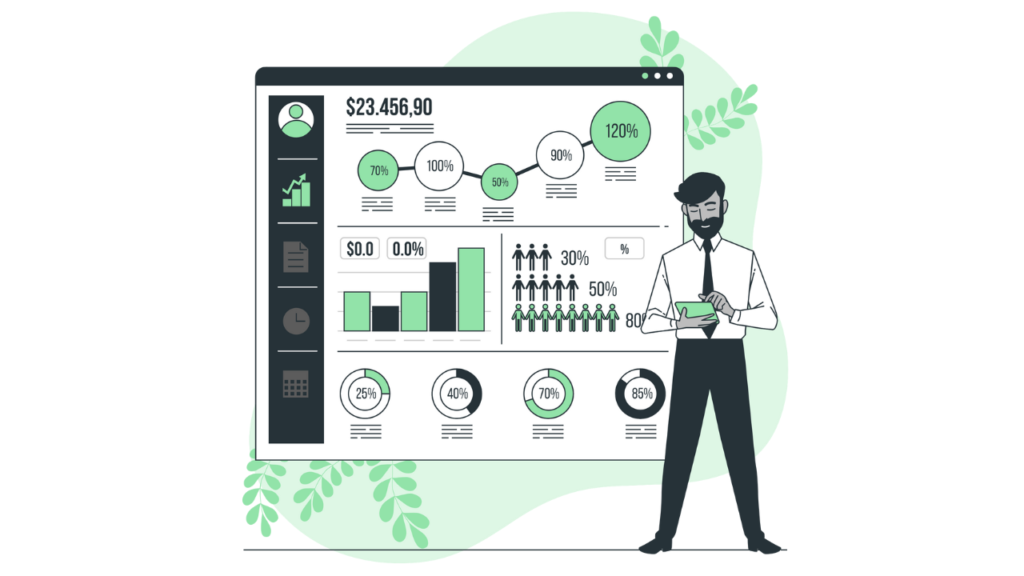
If you are hoping to implement an effective marketing strategy, you need to know exactly who it is that your marketing needs to be geared towards. If you try to market to EVERYONE, very often, it turns out that you’re reaching NO ONE.
You’ll need to come up with a customer persona that represents your ideal audience or customer. While you’ll need to outline their general demographic, you also want to get a little more granular with their description as if they were a real person.
Having this detail will help you to market directly to your ideal audience as well as effectively manage your marketing budget. So you can spend more time focusing on developing customer loyalty.
When creating a buyer persona, include information such as the following:
- Physical location
Creating a buyer persona is often overlooked, but without this step, your marketing strategy could be completely ineffective. You want your message to come through loud and clear to the people whose attention you are trying to grab. So make sure you know exactly who that is.
2. Create Clear Goals

Your marketing strategy should have very clear goals. This way, you’ll be able to measure whether your marketing is effective or whether you need to reassess your strategy to help reach your goals. Each goal that you come up with should be a SMART goal :
If you ensure that each of your marketing objectives is specific, measurable, achievable, relevant, and timely, then you know that you have a list of very strong goals.
3. Analyze Your Competitors

The best way to get ahead in any industry is to learn from other companies’ mistakes so that you don’t have to go out and make them for yourself. The best way to do this is to analyze your competitors to understand their strengths and weaknesses. This allows you to excel where they excel and improve on their weaknesses.
Take at least three of your top competitors, and run them through this analysis to get a better understanding of their marketing strategy:
- What makes them attractive to their customers?
- What experiences do they offer, and at what price?
- Who is their target audience?
- What unique features and benefits do they offer?
- What is their overall rating on review sites?
- What do their guests/customers say about them?
- What type of social media platforms do they use?
- What kind of content are they posting?
- What kind of distribution channels do they rely on?
- Their domain authority score (that can be checked on Moz Keyword Explorer or Ahrefs )
- What keywords do they rank for? (can also be checked on Moz or Ahrefs)
This type of analysis will give you a better idea of where to start and how you can improve on your competitor’s marketing strategies when creating your own.
4. Choose Your Tourism Marketing Platforms

Unless you are a big company that can outsource its marketing efforts, you’ll likely have to refine your marketing to a couple of key platforms. So how do you decide which platforms are worth the ROI?
The best place to start is by looking at which platforms the majority of your competitors are focusing their marketing efforts on. There’s probably a good reason that most of them spend a lot of time on the same platforms. While that’s a good place to start, it may also take a little trial and error until you find the platforms that are converting best for you.
It’s important to remember that tourism is a highly visual niche, so whichever platform you are using to market your products or services, make sure it can support your high-quality content. These are some of the platforms that work well for tourism marketing :
- Pinterest marketing
- SEO (search engine marketing)
- PPC (pay-per-click advertising)
- Content marketing
As you can see, there are many directions you can go in when it comes to tourism marketing. So it’s best to refine the process early on and decide on a couple of main platforms rather than half-heartedly trying to use every single one.
5. Ensure That You Are Selling a Unique Proposition

When creating your marketing content, you want to ensure that what you are selling has a clear message and one that sets you apart from your competitors. Here’s an example of what we are referring to:
- M&M’s – “Melts in your mouth. Not in your hand.” – this slogan tells people exactly what sets M&M apart as a candy.
- Domino’s – “Fresh, hot pizza delivered in 30 minutes or less, guaranteed.” – they are not claiming to have the best pizza; they are claiming to have pizza in your hand quickly.
So what does this look like for a tourism company? Well, that is entirely up to you, but here are some examples of how you could make your offer different from industry competitors:
- Tour company: book your tours last minute, let us handle your entire trip or no person-to-person contact booking.
- Accommodation: last-minute bookings, free cancellation policy, or return visitors get a night free.
There are many different directions you can go with your USP ( unique selling proposition ), and they don’t have to come at a cost to the company. Think about how you want to set your business apart from industry competitors and make sure that message comes across loud and clear in your marketing strategy.
6. Create Tourism Marketing Content

When creating a strategy for each of the platforms you have chosen, you need to make sure that each platform is working together as a cohesive team. For instance, you could run a competition on Instagram or Facebook that aims to collect emails for your email marketing campaign.
You should also ensure that the content being produced is not simply copied from one platform to another. The users of each platform are looking for something slightly different, so you will need to adapt your content to suit the audience of each platform.
Tips for Creating Marketing Content That Converts
Once you have chosen your marketing platforms, it’s important to understand that having a presence on those platforms is simply not enough. You need your copy to really speak to the right audience.
- Speak to your customer persona – You need to speak directly to the audience that you want to sell to, and your customer persona is a great example of your target audience. The voice present in your copy needs to speak to the values and perceptions held by your target audience. After all, if you try to speak to EVERYONE, you end up speaking to NO ONE at all.
- Use benefit-driven copy – when you are trying to entice your audience with an offer, focus on the benefits that you offer rather than just stating facts. If you are trying to sell a destination, focus on the benefits of visiting that location rather than just spewing out facts about the city or town.
- Collect emails ASAP – Having an email list that contains the emails of people interested in visiting your location or staying at your accommodation is one of the most valuable things you have. You can collect emails by having CTAs in your marketing content, offering freebies in return for emails, etc. This is important because you can send emails to people on your list, providing them with valuable content that can eventually lead to a conversion .
Implement Your Tourism Marketing Strategies

Now that you know exactly how to come up with a tourism marketing strategy, it’s time to implement it and get those bookings or sales. The marketing of tourism can seem tricky at first, but if you follow the steps provided above, you’ll be well on your way to running a successful company in the tourism industry.
We have been working with industry leaders for over 5 years. So if you would like to leave your tourism marketing strategy in safe hands, let us handle your marketing content so you can focus on building your business.
More to explorer

SEO Vocabulary | 75+ Words You Should Know

The Importance of Authoritative Content for SEO in 2024
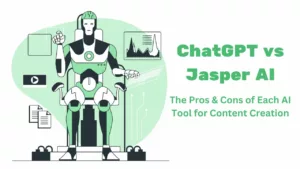
ChatGPT vs Jasper AI | The Pros & Cons of Each AI Writing Tool
Book a call with an digital strategist.
Tourism Insights
- Get Started
How To Create a Tourism Marketing Plan That Works
- December 2021
Brian Nicholson

Step 2: Collect Information
As you collect information, you’re going to come up with several things you want to start doing, stop doing, or keep doing. You could maintain a Start/Stop/Keep list.

Mine Your Data For Insights
See what your data tells you about what’s worked and what hasn’t. An entire series of articles could be dedicated to how to mine your data, but here are a few sample questions to ask:
- Is our website traffic profile healthy? Are we too dependent upon paid traffic? Do we have a good amount of referral traffic that converts at a decent rate?
- Is our website converting at a good rate? Are there opportunities to be aware of on a per-page basis?
- What advertising channels worked and didn’t work? ROAS is a good metric to watch, but sometimes you also need to look at call tracking data, cost per group form submission by advertising campaign, etc. For example, if our client placed a $1000 ad in a print publication, we’ll want to know how many calls came from that ad, and how much revenue came from those calls (both possible with call tracking services). It won’t be a perfect indicator of value, but it will be a useful signal.
- Where are the strong and weak points in our marketing funnel? Are we having difficulty getting people to our site? Getting people to start the booking process? Complete their bookings? Return as a customer?
- What was our churn rate , and how does it compare to previous years?
- What was our cost of acquisition (COA) , and how has it changed?
- What was our average order value (AOV) , and how has it changed?
- What is our lifetime value of a customer (LTV) , and how has it changed? (This significantly impacts what an acceptable COA would be.)
- How did each of our offers do this year? Which ones should we drop, keep, or modify?
- What was our gift card breakage rate , and how might that impact our gift card marketing in the future?

Take Note of What’s New
Ask the following questions to ensure that you’re staying up-to-date.
- Have we seen consumer behavior shift recently? How should we adapt our product or marketing? Example: When consumers are pulling back on spending, a zipline company may need to find a way to make a short version of their tour available at a lower price point.
- Has the competitive landscape changed? Are there new direct or indirect competitors in the market? Has a new opportunity or threat emerged?
Example: Your competitor was more aggressive with discounts last season, and you noticed that when their promotions were running, your ROAS and yield dropped. You’ll need to decide how to respond (and following their lead on discounting may be the wrong answer for your brand).
Take Stock of Your Company and Marketing
Your audience
This is fundamental and should already be well known by you and your entire team, but it’s worth keeping at the forefront of any planning. If you don’t have this documented yet, create a simple audience table, and keep it up-to-date every year. (You can also do this through personas, with much more detail.)
Adventure park example (with just one audience shown):

- Is our visual expression on-brand and compelling? This includes your logo, website, ads, photos, videos, etc.
- Is our verbal expression on-brand and compelling? (Not sure? Shop the competitors like a prospective customer would. See what everyone’s saying about themselves, and ask yourself whether you stand out in the right way.)
Adventure park example:

Your products, services, and pricing
- Is there anything we should drop (based on low margin, low demand, and/or logistical challenges) in order to allow us to focus on more-profitable offerings?
- Is there anything we should add? Do we have any holes to fill in our offerings that might appeal to our target market? Example: An adventure park with a current minimum age of 8 could add experiences that allow families with children as young as 4, instantly increasing their addressable market.
- Should we adjust our pricing? Does the market support price increases? Should we run any pricing tests this year? (Watch conversion rate and yield.)
Your operations
- What operational bottlenecks are blocking our growth? Staffing shortage? Cumbersome check-in process? Walk-in traffic making it difficult to predict staffing needs?
- What opportunities exist based on our operational strengths? (Example: “Jessica has been leading our group experiences, and she’s started structuring some activities to help address the needs of our corporate clients. Maybe it’s time to offer team building.)
- Are there ways to increase profit per employee by streamlining operations?
Your customers’ experience
- Conduct a voice-of-customer analysis to find strong points and weak points. Look at survey results, reviews, complaints, questions, etc.
- Consider customer journey mapping . This takes some time, but can be a powerful tool for identifying any weak points in the customer’s experience that might be causing friction or frustration, leading to a loss of revenue, reputation, or referrals.

Step 3: Create the Plan
You now know what you want to accomplish as a company; you’ve identified what’s been working; and you’ve surfaced several opportunities. Now it’s time to make some decisions and put them into a plan.
Goals → Objectives → Tactics (and KPIs)
This is one of your main brainstorming sessions. For each goal, identify measurable objectives that will support that goal. Then for each objective, create the tactics that will help you achieve that objective. (You can also tally costs for each tactic here, but we’ve removed that column for simplicity.) This example shows the start of the development of a single goal’s plan.
As you get into this process, have your tactical backlog handy. We maintain a backlog (or “opportunities list”) of ideas that we’re constantly adding to. And because our backlogged tactics are already grouped by objectives such as Improve Conversion Rate, it’s very easy to pick from the list without feeling overwhelmed.

As you’re doing this, you’re selecting the key performance indicators you’ll be watching, so you’ll be well-positioned to track your progress during the year (assuming your measurement system already accurately measures those KPIs).
Check The Funnel
During your tactical planning, this funnel grid can be useful to remind you of when and where your marketing can have an impact. This can be done on a per-audience and per-tour/activity basis.
For example, you may find that you’re using ads effectively for driving awareness (discovery campaigns) and staying top-of-mind during the consideration phase (using basic retargeting), but you haven’t yet developed a campaign specifically for those who abandoned their cart. Or you might find that you’ve been addressing families with your social media posts, but not corporate customers. This exercise helps you ensure adequate coverage throughout your funnel.

Build Your Calendar(s)
You’ll want to map out promotions, events, major campaigns, seasonal changeovers (e.g., seasonal outdoor adventure companies should update their website and Google My Business profile), etc.
You may have multiple calendars, depending on your plan. For example, you may have a content calendar for blog posts, social media posts, etc.
The key is that as you build out your calendars—as with every step of this planning process—don’t become untethered from your key goals and objectives. Even your content calendar should have clear connections to your goals and objectives.
Now Execute, Measure, and Win
There’s still a lot to do from this point forward. For example, if you decide to pilot a membership program, someone needs to figure out the pricing, terms, target audience, promotion opportunities, website landing page, etc. And I didn’t get into media planning, which is one of the next logical steps in many plans. But now you have a list of specific things you need to execute in order to reach your business goals, and you can confidently release your team to execute on those tactics. You know what you’re spending time and money on, and why; and you can track whether you’re reaching the targets you set. This clarity, and this level of alignment between marketing and business goals, will keep your marketing on track throughout the next season so that you create the outcomes you’re looking for.
Looking for help growing your tourism company? Contact us at Blend Marketing; we help tour and activity companies with $2-20 million revenue grow their businesses through a strong brand, good data, and smart marketing .
Get Proven Tourism Marketing Tips In Your Inbox
- Phone This field is for validation purposes and should be left unchanged.
About The Author
Brian is a partner at Blend Marketing. He focuses on brand strategy, positioning, and analytics for the tourism industry.
Email Brian
More Articles

Why You Shouldn’t Set an Ad Budget, and What You Should Do Instead

How to Structure Your Key Paid Marketing Funnel [Tourism Marketing Quick Tips – Video Series]

Some of Our Favorite Data Visualizations for Tourism
- Email This field is for validation purposes and should be left unchanged.
Partner With Us
The Ultimate Guide to Creating a Travel & Tourism Marketing Strategy
Creating a marketing strategy for your travel and tourism company can help set you apart from the competition! If you need some guidance on how to begin and where to reach new customers, continue reading!

The COVID-19 pandemic placed an extreme burden on the travel and tourism industry. Between government-mandated shelter-in-place orders and individuals’ reluctance to venture far from home, Forbes estimates that travel and hospitality businesses worldwide lost an estimated $935 billion in 2020. The OECD estimates that international travel revenue decreased 80% . Shoring up travel and tourism is going to take a multi-pronged approach of restoring travelers’ confidence, offering clear information to domestic and international travelers, and building more resilience into your business through diverse offerings and quality services. Another way your hospitality business can build back is through thoughtful marketing.
Preparing to meet the pent-up demand for travel and tourism means being ready with an updated travel and tourism marketing strategy. Why have one? Marketers with a documented marketing strategy are 313% more likely to achieve their business goals. Just as keeping a planner helps individuals stay organized, having a marketing plan maps out the inputs your travel business will need to achieve its goals and how to put them in motion to enjoy the success you dream about.
A marketing plan can also help you remain competitive. It will assist you with identifying target markets and understanding their wants. Marketing plans help you set measurable goals for sales and finances, and map out how you’ll reach customers and prospects with information about your offerings. In short, a travel and tourism marketing plan shows how you’ll tell the world how awesome your properties and services are.
In this guide, we offer a basic flow for developing a marketing plan as well as strategies and tactics to consider. With a little planning and creativity, you can market your travel business like a pro!
Step 1: Conduct Market Research Among Key Stakeholders
Before you can begin creating a marketing strategy, you need to understand the why behind your need for one. You also need to understand where your brand has been… where it currently is… and where you want to take it. To do this, you need to sit with key stakeholders and identify:
- What is your unique value proposition - the thing that truly separates you from your competitors.
- Who are your top competitors?
- If your brand were a person, what five words would you use to describe them?
- What are the top challenges you face when it comes to growing your business?
- Who are the dream clients you aspire to work with?
- Who are your advocates?
- What social media channels do your audiences hang out on? Are you on them?
- What is your goal for a marketing strategy? To grow brand recognition, gain clients, establish thought leadership opportunities for your executive team? All of the above?
You could find answers to these questions through focus groups, phone or online surveys, one-on-one interviews, or a combination of all. It’s best to employ a mix of quantitative and qualitative research when setting a marketing strategy for travel. Quantitative travel research will give you the “what” of your strategy while qualitative travel research will tell you the “why.”
Step 2: Establish Your 4 ‘Ps’ of Marketing
Having a marketing strategy means having plans in place to deal with both expected and unexpected situations. A marketing strategy helps you position your product to the right audience, at the right time for the right price. You should build your marketing strategy around the “Four Ps” of marketing:
- Product: The goods or services you offer.
- Price: The amount of money you charge for your product.
- Placement: Where or how your product is available for purchase.
- Promotion: What you do to communicate your product’s features and benefits to your target audiences.
Many variables affect your business success in the travel and tourism industry: competition, climate, current events. But you can control the four Ps.
Once you have decided on the four Ps for your product, one very important part of a marketing strategy that every business should establish early on are goals and key performance indicators (KPIs). What do you hope to achieve through your offerings? Increased sales? Higher volume? More frequent repeat business? And how will you know you’re getting there? KPIs are any metric that indicates success for your business. Ten businesses could designate 10 different KPIs for measuring their success and they would all be correct.
Spend some time creating meaningful goals and KPIs that will define success for your travel business before you start working on tactics.
Step 3: Know Your Customers
It’s imperative to be close to your data when developing a marketing strategy. In order to do this, you need a customer relationship management system (CRM). A CRM will help you accurately track your company’s interactions with a current or potential customer. Every phone call, email, and website page visit gives you incredible insights into who your customers are and what they are interested in. And with 80% of consumers more likely to purchase from brands that provided personalized experiences, you’re leaving big money on the table by not using a CRM.
What’s more, CRMs allow you to track the entire customer journey. There are five main stages in a typical travel customer’s lifecycle:
- Acquisition
At each stage, a CRM can help you serve the customer through:
- Generating brand awareness
- Acquiring leads
- Converting leads into customers
- Providing superior support
- Driving upsells and referrals
Successfully navigating leads and customers through these stages results in more business and profits for you, and a more customized experience for your customer.
You’ll want to integrate your CRM with your other business tools. Connecting your CRM to your ticketing system helps you track orders and deliver promptly. Integrating your CRM with your content marketing platform helps you see what content is resonating best with your customer base and what knowledge gaps you still need to fill to encourage leads to convert. Joining your CRM with your phone system makes it easy for your call center agents or sales representatives to offer better customer support by having quick access to a customer’s purchase history or a potential customer’s journey through your sales funnel.
Step 4: Break Down Your Strategy Into Execution Channels
Marketing covers a huge span of online and offline channels. And studies show that having a strategy that covers multiple channels greatly impacts the bottom line. The numbers don’t lie:
- Brands experience a 287% higher purchase rate when using three or more channels
- Average SMS ROI of approximately 2755%
- The average order is 13% more per order with an omnichannel approach vs. single channel
- Customer retention rates are 90% higher for omnichannel vs. single channel
A website is a critical component to your business success. It’s the central hub where your guests find information regarding travel packages and services, booking and reservations, travel details, and more. It’s one of the main places where your prospects are going to convert.
Your website is a reflection of your brand, and you want to convey a friendly, no-hassle experience to your travelers in the form of aesthetically pleasing imagery, captivating copy, easy-to-navigate site setup, branding, and phone numbers to direct your customers’ questions to the right place.
Your website’s user experience (UX) must offer information that answers all sorts of questions your guests may have about your services: pricing, amenities, loyalty programs, housekeeping, shuttle service, meeting rooms, excursions, and more. Displaying those details on your website and keeping lines of communication open helps your guests have a better experience with your brand. To make your website stand out and attract customers, you’ll want to consider adding these features to enhance your ability to communicate all this information.
Crystal-Clear Navigation
Travelers don’t have time to dig through the weeds of a complicated website. If they can’t find what they’re looking for in 15 seconds, about half of your visitors have no problem leaving your site and looking on a competitor’s page.
You can make it easy on visitors just by creating easy-navigation menus to create siloed information around specific topics of interest. Some of these topics in your menus might include: destinations, limited-time offers or specials, book or reserve, flight status, help or contact us, travel information, COVID-19, etc.
Top navigation is to help travel brands create a natural flow of progression and a good customer experience. If this is your first experience with building out a custom menu, a good rule of thumb to follow is to stick with a menu no more than two steps deep. If you need more, your setup isn’t offering an ideal customer experience.
Real, Professional Photos
People want to see real, professional images of your product or service. It conveys authenticity and adds value. Your prospects can sniff out a stock photo from a mile away - don’t do it. Give your website visitors a real taste of what they’ll get if they book their stay or travel with you. Invest in a professional photographer to take photos that show off your hospitality and the beauty of your destinations in the best light possible. Update them for the seasons as your business grows. It will be money well spent.
Phone Numbers in Prominent Places
Phone calls are still one of the fastest ways to get specific information. And, it remains the most preferred method of communication . When talking with a live staffer, Newcastle Web Design notes that callers have a better user experience. They’re able to get urgent answers and can ask probing questions in real-time. And, posting a phone number on your website builds trust between you and your prospect.
Easily accessible phone numbers for guests to contact you about sales and support information is essential to a good experience. This is where virtual numbers add value, providing reliability, exceptional call quality, and little to no cost towards the consumer.
- Toll Free Phone Numbers . Guests can dial into your call center from one country for free.
- Vanity Phone Numbers . Similar to a toll free number, vanity virtual numbers can be dialed from one country but use numbers that are easy to remember or spell out a brand name.
- UIFN . A UIFN (universal international freephone number) is a global toll free number that can be dialed from multiple countries.
- Local DID + Caller ID . Establish a local presence and engage more with customers with two-way voice services plus caller ID.
People love chatbots on websites because much like phone calls, chatbots offer instantaneous answers to very specific questions, resolution support issues, updates to existing itineraries, reservations and bookings, etc. IBM estimates that chatbots can answer up to 80% of common questions.
Chatbots are great tools to integrate with your global phone system. They can save your business time and money by automatically handling queries to questions that would otherwise fill up your call queues and overwhelm the staff.
Similar to instant gratification phone calls and chatbots offer, an FAQ (Frequently Asked Questions) page is a perennial favorite among travelers because they house quick answers to, well, the most frequently asked questions.
This common feature of websites saves visitors time by signaling where they can find digestible, short-form information on hot topics. FAQ sections also save your agents time by heeding off individual questions you hear all the time in the call queue - giving your staff more time for more taxing customer support and conversion activities.
2. Content Marketing
Content marketing is strategically curating written articles, visuals, audio, and video to encourage conversions for your business. Essentially, it’s the process of providing your customers value in hopes that it will keep them informed and trusting of your brand so they will eventually buy, refer, and repeat. It means using a combination of the tactics below to promote your business across a variety of channels and touchpoints. Let’s look at the most common travel and tourism content marketing tactics.
Search Engine Optimization
Search engine optimization (SEO) is the activities you can perform to ensure your targeted audience can find your website via search engines. This includes search engine marketing, improving your website’s content, using specially formatted text or coding to communicate directly with search engines, creating online business listings, and working with other websites to gain inbound links.
SEO is important because search engines deliver a targeted audience to your site. People use search engines to find the information they need right then and there. The first page of search engine results gets 95% of all search engine traffic . Very few people click through to the second, third, or fourth pages.
You want to optimize your travel and tourism website to be discoverable by search engines and ranked highly for the keywords of your choice. Unfortunately, there is no easy formula for getting your site on the first page of search results. Google, Bing, Yahoo! and other search engines constantly update and tweak their algorithms that respond to search queries and deliver search results. But there are a few things you can do to make your site more search engine- and user-friendly that will always count toward a better search engine ranking:
- Make your site relevant with engaging, thoughtful content . Sites that contain original, organized content centered around a well-defined topic (like your organization and its activities) will always outperform sites that are not well-organized or thoughtfully written. Take some time to review the text on your site, and ask yourself: Is it understandable? Is it grammatically correct? Is it non-repetitive? If the answer to any of these questions is no, revise it.
- Use relevant images with alt text . Alt text is text that shows up in an image box when you hover your mouse over it or when the image does not load within your browser. This text tells search engines what the image is about, giving the engine a better idea of what your overall site is about.
- Make your site useful and current enough that other sites want to link to you . Although search engines no longer consider the number of outbound links you host when deciding how to rank you, they still consider inbound links – links on other sites that lead to your site. The best way to build your popularity is slowly, by encouraging related/similar sites to link back to you and by earning linkbacks through hosting updated, relevant content.
- Optimize your website for small screens . 79% of consumers used a mobile device in 2020 to make a purchase. Format your website to be more mobile responsive or risk discouraging visits.
- Localize your content . Make sure your NAP is consistent across all your organic channels. NAP stands for name, address, and phone number, and it’s essential to ensure that every major search engine can verify your company’s existence.
- 7-Day Italy Adventure > Book Now
- Atlanta Hotels > Check Rates
- Europe Cruise Fleets > Learn More
- Flight Details > Shop Now
- Travel Restrictions > Stay Updates
- Track your website’s progress. Google Analytics helps brands track and report a myriad of website performance metrics. Coupled with call tracking software , companies can measure the reach and ROI of where their inbound calls are sourced from (direct website traffic or organic results) within Google Analytics or their VoIP provider dashboard.
Once you’ve figured out what you want your travel and tourism website to be known for, support your SEO goals with rich content on a company blog. Use your keyword research to develop and execute an ongoing series of blog articles - with written word, images, video, and audio content - that feature those top-level keywords travelers use to find information about their next travel purchase.
Getting content for your travel & tourism blog is easier than you might think when you view every marketing deliverable as potential content. Are you sending a promotional email to your contact database? Turn the email into a blog post. Have you created some print collateral recently? Pick content from those pieces to create several blog articles (and some even snappier social media posts). Everything and anything can be talked about from the right angle.
Testimonial & Reviews
Word of mouth remains one of the most effective marketing tactics. In addition to friends and family sharing recommendations, we now have sites like Yelp, Google Reviews, TripAdvisor, and Travel + Leisure where travelers can share detailed experiences and recommendations for travel. Even short-term rental sites like Airbnb and VRBO act as de facto review sites because of the public reviews guests leave for each property.
Be proactive about being visible on review sites. Ask your customers or guests to leave an online review about your business. Their testimonials will carry more weight than most, if not all, of your marketing. Place outstanding reviews in a prominent place on your website and within social media posts. Thank the people who offer a positive review and respond to any negative reviews with gratitude for their feedback and promise to do better going forward.
Video Creation
As tools like smartphones and video editing apps become more accessible, the popularity of video as a marketing tool is skyrocketing. Why use a still photo or words to describe your destination when you can show a viewer exactly what your destination looks and sounds like? As of last year, 86% of businesses used video as one of their marketing tools. Furthermore, among marketers promoting their business with video, 93% say it’s an important part of their strategy.
If you’re not using video, what are you waiting for? Nowadays, brand loyalists and casual customers alike don’t always expect a company’s videos to be polished and slick. People value authenticity in marketing. They don’t necessarily care that a video was filmed on a smartphone as long as they perceive the story the video tells to be genuine.
Some ideas for video marketing content:
- A tour of your property, cruise ship, leading travel destinations, etc.
- A walk-through of your services
- Interviews with internal advocates and customers
Remember to provide your viewers with a website domain and phone number at the end of your videos so they can reach out and engage with your brand.
Social Media
Social media has become a ubiquitous part of travel planning because it’s so visual by nature - who can resist showing off photos of their latest dream vacation or swanky business trip? As part of your robust content marketing strategy, you’ll need to cultivate a social media presence on the platforms of your target audience’s choice. Items to consider:
- Where is your customer base gathering? Don’t bother spending time posting to LinkedIn if people are not talking about services or products related to your business there. You’ll probably want to focus on social media channels that are more visual, such as Instagram, Snapchat, Facebook, and TikTok.
- What do your customers want to know more about? Post content that responds to their travel information needs that you identified during your stakeholder research.
- How often do your customers want to hear from you? You don’t have to post multiple times a day or even every day to have a successful, engaging tourism social media strategy. You simply need to post shareable and digestible content consistently.
- What are your staff’s social content capabilities? Some platforms require specific types of content: videos for YouTube or TikTok, photos for Instagram. If you want to stand out on these platforms, not only will you need to know how to create videos or take compelling photos, but you’ll want to know the nuances of social media culture. TikTok has a very different vibe than Facebook, for example. Make sure someone on your staff understands how to culturally navigate platforms before you overextend your business or inadvertently commit a social media faux pas.
While we may sound like a broken record here, having consistent messaging is vital in content marketing. You want your brand presence to reflect that so your customers have a good experience engaging with your business. Make it a point to always ensure your brand description, website domain, name, address, and telephone numbers point back to the related location your customers are intending to visit.
3. Email Marketing
Email is one of the most cost-effective and efficient ways to reach your potential customer base. Even with an estimated 306.4 billion emails sent per day , people still prefer receiving news and other messages via email. 58% of people check their email before reading news or social media, and 60% want to receive promotional information via email rather than through other channels.
Email is a great way to market your travel and tourism business because it allows you to send personalized messages. You can segment your customer list to send more relevant promotions and information to customer subgroups while allowing customers to segment themselves by signing up for certain types of emails they’re interested in. You can let customers control how frequently they hear from you by using automated email campaigns that run at designated frequencies.
To be really effective at email marketing, you’ll want to first build an email list. You should start with existing customers. Collect new contacts everywhere you have a potential customer touchpoint:
- Web-based subscription forms
- Gated online content and coupons
- Trade shows or expos
- Webinar registrations
What kinds of emails should you send? That depends on the exact nature of your travel business. In general, you’ll want to set up the following types of emails, many of which you can create in advance and tell your email marketing platform to automatically send when your CRM tells your email platform that a recipient has reached a certain milestone or completed a certain conversion:
- Welcome emails : when someone signs up to receive your emails.
- Follow-up emails : sent a few days to one week after someone signs up. These offer extended information about a topic or more detailed information about your offerings.
- Milestone emails : to recognize (sometimes with a discount) when someone has a birthday or reaches an anniversary of supporting your business.
- Newsletters : to keep subscribers apprised of what’s new with your business, how to maximize their travel, and how to discover offerings they haven’t yet considered.
- Informational emails: including product explanations, trip updates, and responses to current events that affect your operations.
- Confirmation emails : sent when someone makes a purchase or completes a conversion.
- Abandoned cart emails: sent when someone adds a trip to the online cart but then leaves your website without purchasing it. These emails should remind the recipient of the benefits of the service(s) they intended to purchase and offer customer service or tech support if needed.
- Thank you emails : sent when someone makes a purchase or converts.
There’s a lot to email marketing. Make sure that your email templates always point back to a relevant landing page to your website or customer support contact. For example, if you’re sending an informational email regarding new 2022 trips to Asia, be sure to include a CTA that links to a landing page where those newly-added itineraries live.

4. Advertising
Paid search ads.
When people are searching for specific information, one of the first places they go is an online search engine. Make sure your brand is included in their search results by bidding on paid search ad spaces. Paid search ads appear next to organic search results. They look similar to organic search links but are sold in instantaneous mini-auctions among companies vying for potential customers searching for related information. You only pay for the ad if someone clicks on it.
Your business can appear within search results about your niche of the travel and tourism industry when you run ad campaigns on search engine platforms like Google , Yahoo ! or Bing . With the free training those platforms provide, it’s easy to set up an ad campaign that targets people searching for a set of keywords you determine. You can also target client lookalike audiences based on their past searches and general demographics. Be sure to establish a reasonable budget for paid search campaigns and spend some time refining a tightly-focused keyword list that describes the core of your travel/tourism business. With millions of people using search engines each day, you could easily blow through hundreds or thousands of dollars every day in paid search ad clicks. At the same time, you want to bid competitively so your ads actually appear high up in search results and have the chance for potential customers to see them.
Programmatic Ads
Programmatic advertising is the use of technology and automation in the buying and selling of online media. Programmatic ad platforms track your site’s visitors as they surf the web, serving them ads in established display ad spaces relevant to what they’ve already viewed. These retargeted ads encourage the user to revisit past site pages and take action.
So say you had visitors who viewed your website’s destination page but didn’t convert. Instead of relying on them to come back to that page, programmatic or retargeted ads pull through on their most visited third-party sites and social media platforms. This is a cost-effective way to advertise online and remind customers of your brand and the services you can provide.
Metasearch Engines
These are price comparison websites that compare rates for major travel-related expenses like flights, hotels, rental cars, or cruises across several companies or brands. Several metasearch engines in the travel and tourism industry include Destinia, TripAdvisor, Trivago, Skyscanner, and Kayak. Travelers enjoy using metasearch engines because these sites save research time and money on their reservations. Consider purchasing display ads or digital retargeting ads on these sites to reinforce your brand when people search for related services or move on to other websites during their research.
Direct Mail
Once the bane of homes everywhere, direct mail is enjoying a resurgence in popularity. Consumers are more accepting of direct mailers for products and services, with open rates landing at 90% and 39% of consumers purchasing from a new business that sent a direct mailer.
When creating a direct mailer, consider the shareability aspect. RetailWire has found that households collaboratively discuss 88% of key purchases, including travel. And it’s proven to be effective at generating sales: a study by Go Inspire Group found that people who received a direct mail piece spent five times as much on the advertised product as another group who only received emails about the same product. Even better, a third group who received emails and direct mail spent more than six times as much as the email-only group.
If you want to make direct mail a part of your marketing strategy, the U.S. Small Business Administration recommends these steps :
- Start with existing customers: Your customers remain loyal because they know the services you provide them. Two-thirds of people discard mail from companies they haven’t heard of. Don’t waste money on people who don’t care about you (yet).
- Target your direct mail: Beyond your customers, send promotional direct mail pieces to people potentially interested in your product. The USPS offers resident demographics through their Every Door Direct Mail program . You could also rent targeted mailing lists through a variety of list companies.
- Use thoughtful design: Mail pieces with interesting visuals, minimal, readable text, and a clear call-to-action perform the best.
- Extend a worthy offer: Speaking of calls-to-action, tell the recipient what you want them to do and make them a deal so sweet they can’t resist taking advantage of it. You’re already investing a fair amount of money in a direct mail campaign. If you want it to result in conversions, your offer must be great.
5. Public Relations
Public relations (PR) is the strategic communication process that builds mutually beneficial relationships between organizations and their publics. It is about influencing, engaging, and building relationships with your key audiences across multiple platforms such as paid media (including advertising), earned media (media appearances), and owned media (like your website or social media pages). While PR has a reputation (and history) of being a bunch of spin, modern public relations is much more about telling your organization’s story in an honest way that responds to audience concerns so that your organization can succeed.
With that in mind, what stories about your travel or tourism company could you tell to respond to travelers’ concerns? What benefits of engaging with your company could you explain, and through which channels, to reach potential customers and get on their short list of travel-related companies to patronize?
To run a successful PR program, Aventur Marketing advises following a few key points:
Know Your Audience
Who are they? What are their demographics? What are their lifestyles like? What do they want from a travel or tourism company? Furthermore, where are they “hanging out” when it comes to the media? Do they watch television, or prefer to read newspapers and magazines? Do they frequent certain travel blogs? Do they congregate on Facebook, Twitter, or both? Meet your audiences where they are with your message.
Build Relationships With Key Travel Media Professionals
It’s not enough to distribute a press release about your new property or renovations and hope every publication you emailed will print it. Publishers receive hundreds of releases and media advisories weekly. They won’t pay attention to your press release unless it appeals directly to their readers, and they trust you to provide high-quality content.
Build relationships with travel writers and bloggers from a targeted list of travel and tourism publications you assemble that you know your audience consumes. Know what these writers enjoy writing about, and provide them with related, substantive content even if it doesn’t directly promote your business. They’ll come to trust you as a reliable source of information that makes their job easier. Then, when you do have an item to promote about your tourism company, they’ll be much more receptive to working with you to reach their audience.
Customize Your Pitches to Different Niches
You can’t pitch the same topic to every publication and expect them all to publish it. Customize your story pitch to the publication and medium. For example, your convention and visitors bureau’s (CVB) news about a new facility opening might easily win placement in your local newspaper because of the local business aspect. But to win placement in an out-of-state publication, you’ll have to explain why out-of-state visitors should stop at your shiny new facility.
Maybe it’s the free concierge services you offer for local attractions? Or maybe it’s the ticket discounts you can only get by visiting your new location? In addition, a travel-oriented Instagram account is going to want photos to accompany your written information. A travel sage YouTuber is going to want video B-roll, or the opportunity to visit and have your staff guide them around as they film for their YouTube channel. Customize the format in which you offer information to dramatically increase the chances different media will pick it up.
Get to Know the Local DMOs & CVBs
Speaking of CVBs, make friends with these staff right away! Destination marketing organizations (DMOs) and CVBs are groups whose job is to promote a local area to tourists, business visitors, and people thinking of relocating there. They know all the best information and movers/shakers related to travel and tourism in the area. If they come to know your business as an interesting, can’t-miss part of the local experience, they could provide very valuable paid or earned marketing for you that is backed by their authority in the local travel arena. They could also help boost your business by sending journalists assigned to cover your area to talk with you about your business. These connections can result in greater web visibility through increased SEO and exposure.
Again, travel publications receive hundreds, if not thousands, of pitches weekly. You have a few seconds to grab their attention with your email or phone call, so get to the point of your news quickly. One or two paragraphs is usually the maximum needed before a journalist or writer will decide to reach out to you for more information.
If you’re unsure about how to craft a winning PR pitch or how to start building relationships with journalists, check out Destination British Columbia’s excellent guide to travel media relations strategies and tactics.
Preparing for the New Travel Market
COVID-19 changed everything about the way travel and tourism brands need to market themselves to remain competitive as economies open back up. It's more important now than ever for CMOs of travel and tourism brands to reevaluate their marketing strategies to accommodate growing customer expectations. And a “wait and see” approach won’t help you make up for lost dollars as people begin to travel again.
We hope that this guide will help you to evaluate your current strategy and make the necessary changes that will help your organization thrive now and in the future.
Deliver a 5-Star Guest Experience with Modern Cloud Communications
Stay connected to your guests with modern global communications software. Your marketing strategy brought them to you, now nurture and grow your relationship with excellent call quality, robust virtual number inventory spanning 170+ countries worldwide, and more - all on a reliable voice platform.

Katharine Kellar
Katharine is the Director of Marketing Communications at AVOXI, bringing over 17 years of experience in nurturing B2B, e-commerce, SaaS, and global brands. Fueled by her relentless drive for growth and an unwavering optimism, she finds joy in every day's silver linings. Outside of her professional achievements, Katharine is a coffee aficionado, savoring the aroma and taste of a freshly brewed cup as she crafts compelling narratives that resonate across diverse markets.
Web Application
SIP Integrations
Integrations
Programmable Voice
Our Leadership
Talk to an Expert
HIPAA Compliance | Privacy Policy | Política de Privacidad | PAIA AVOXI Manual | PAIA Forms | POPIA | U.S. Terms & Conditions | South Africa Terms & Conditions | Cookie Policy | Política de Cookies | Data Processing Addendum | AVOXI Patents
©2024 AVOXI
Sign Up for Our Newsletter
You'll receive a monthly newsletter where you'll discover new content at AVOXI, including events, product updates, and industry trends.
Welcome to Lake
Discover places to stay and unique experiences around the world.
- How It Works

Home - Blog - Tourism Marketing Strategy: Boosting Your Destination’s Appeal in 2024
Tourism Marketing Strategy: Boosting Your Destination’s Appeal in 2024

David Ciccarelli
January 18, 2024
In this article
Get started.

In the dynamic realm of travel and tourism, leaving your marketing efforts to chance is akin to setting sail without a compass. It is crucial to understand the pulse of the market, from shifting trends and algorithm changes to staff turnover and technological advancements. Without a strategic framework, you could squander valuable resources, lag behind competitors, and miss out on potential growth opportunities.
Having a structured tourism marketing strategy is not just beneficial but essential. It serves as the foundation upon which you can build and refine your marketing initiatives, ensuring that experimentation comes with direction and purpose. In a sector where every click could translate to a booking and every shared experience could lead to a loyal customer, it’s vital that your marketing plan isn’t left to random acts but is a deliberate storyboard of success.
Crafting Your Tourism Marketing Strategy
Imagine you’re the captain of a ship; your tourism marketing strategy is the map that guides you through the vast ocean of the travel industry. It’s a well-thought-out plan that aims to pinpoint your current standing in the marketplace and chart a course for future achievements.
Think of it as your navigational chart through the competitive seas, geared with tools to keep you on course and to adapt when unexpected waves hit. Here’s what you can expect to incorporate:
- SWOT Analysis : Assess your Strengths, Weaknesses, Opportunities, and Threats to stay two steps ahead.
- Unique Value Proposition : Clearly define what makes your offering irresistibly attractive.
- Customer Personas : Know your audience as if they were your travel buddies.
- Competitor Insights : Keep an eye on fellow voyagers, learning from their adventures and missteps.
- Marketing Mix : Blend the perfect cocktail of price, product, promotion, and place.
- Budget & Resources : Allocate your treasures wisely for a prosperous journey.
- Objectives & Metrics : Set clear destinations and measure the nautical miles you’ve covered.
- Marketing Itinerary : Outline the routes and stops of your promotional exertions.
Crafting a Strategic Framework for Tourism Promotion

Assessing Your Tourism Business Through SWOT Analysis
Embarking on a SWOT Analysis sets the groundwork for a robust tourism marketing plan. Dive into a thorough examination of internal and external elements that could impact your success. Evaluate your team’s expertise, location perks, and resource availability , considering them your enterprise’s strengths and weaknesses. Similarly, pinpoint external opportunities and threats stemming from market trends and competitive actions. Engage diverse team members for a well-rounded perspective, culminating your insights into a visual SWOT grid.
Clarifying Your Unique Tourist Attraction Proposition
Unearth your company’s unique allure by distilling your strengths into a captivating value proposition. This clear, persuasive statement should spell out why travelers should choose your offerings. Focus on attributes that distinguish your service in the marketplace, and ensure that this key message is a prominent fixture on your digital storefront.
Painting a Portrait of Your Ideal Visitor
Narrow down your ideal market segment to avoid the pitfalls of overly generic marketing. Fashion a detailed guest persona that answers critical questions about demographics, psychographics, and online behaviors. Surveys and analytics tools are your allies in crafting this persona, helping you to personalize your communications and align your tactics with your audience’s preferences.
Benchmarking Against Your Competition
A nuanced understanding of your competitors arms you with the knowledge to outmaneuver them. Compile profiles of top competitors, including their marketing strategies , audience, and unique selling points. Stay informed of their movements through online alerts and social monitoring, allowing you to anticipate industry shifts and adapt your strategies accordingly.
Piecing Together Your Tourism Marketing Framework
Construct a tourism marketing strategy that takes into account the nuances of your services. This mix should involve a strategic selection of your offerings, ideal booking avenues, pricing mechanisms, and promotional activities. Additionally, weigh in on the personal touch your team brings and the operational plans in place to ensure memorable experiences.
Allocating Finances and Resources Wisely
Your strategy’s effectiveness hinges on a realistic assessment of your financial capacity and available assets. Budgeting forms the cornerstone of your plan, influencing which marketing activities you pursue. Strike a balance between ambitious goals and the practicalities of your resource pool to ensure sustainable execution of your strategy.
Setting Clear Objectives and Success Metrics
Anchor your tourism marketing plan with specific, measurable goals. Define what success looks like with a set of key performance indicators, and outline the steps necessary to reach these milestones. This goal-oriented approach ensures focused efforts and a clear understanding of what constitutes progress.
Laying Out Your Strategic Marketing Roadmap
Your marketing roadmap translates your strategy into tangible steps over time. It should consider long-term aspirations and short-term actions, integrating content strategy, digital marketing, and social media engagement . Construct a timeline that maps out brand awareness campaigns, conversion tactics, and opportunities for customer advocacy, ensuring that you navigate the journey from awareness to inspiration to booking with clear direction.
Streamlining your marketing efforts with a structured plan creates a clear path for captivating and converting your target audience, propelling your tourism business toward sustained growth and success.
Where to go from here?

You’ve reached a pivotal moment! Flexibility is key in any marketing plan, especially when reflecting on the unpredictable nature of events like COVID-19. Haven’t we all learned that lesson?
Adapt and Overcome:
- Reassess Regularly : Circumstances change; ensure to regularly evaluate your progress.
- Be Prepared for Challenges : Unforeseen events may prompt shifts in tactics.
Remember, your strategy is living and breathing—adjust as needed! Keep pushing forward with eyes on your goals, and modify your approach when necessary. Isn’t it exciting to think on your feet?
Elevate Your Tourism Tactics
Leverage your tourism enterprise by harnessing a powerful, results-driven marketing approach. With the right blend of the tourism marketing mix, strategic partnerships, and an efficient booking system, you can magnify your market presence.
- Tourism Marketing Mix: Tailor your services to the traveler’s needs and desires.
- Partnerships: Collaborate with complementary businesses to broaden your reach.
- Booking System: Simplify reservations with a user-friendly booking system.
Common Questions Regarding Tourism Marketing Tactics
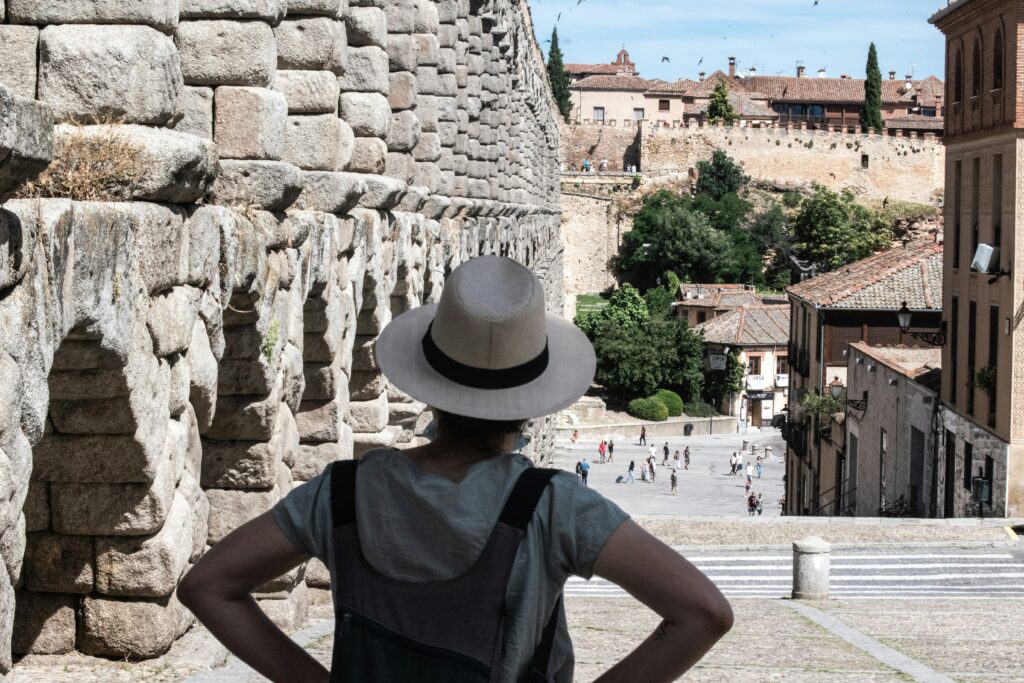
Utilizing the Fundamental Aspects of Tourism Marketing for Effective Campaigns
Understanding the 4 A’s of tourism marketing—Accessibility, Accommodation, Attractions, and Amenities —is vital for shaping successful campaigns.
- Accessibility : How easily can tourists access the destination?
- Accommodation: Are there adequate facilities for different budgets and preferences?
- Attractions: What are the unique, must-see places or events?
- Amenities : Are the necessary services available to enhance the visitor experience?
Incorporating these elements ensures each aspect of a visitor’s experience is considered.
Success Stories in Tourism Marketing
One standout example is the “Share a Coke” campaign by Coca-Cola which, although not exclusively a tourism strategy, inspired destination marketing with its personalized approach. You can see how personalization creates a connection with audiences globally, inviting them to be part of the experience.
Key Steps for Crafting a Tourism Marketing Plan
For crafting a well-rounded tourism marketing plan, pivotal steps include:
- Market Research: Understand your audience and competition.
- Establish Objectives: Set clear, measurable goals.
- Budgeting: Allocate your financial resources efficiently.
- Strategic Development: Choose the appropriate marketing channels and tactics.
- Implementation: Deploy the strategy with precision.
- Monitoring: Track progress against objectives regularly.
Adapting Marketing Tactics to Current Tourism Trends
Modern marketing strategies stay aligned with the current trends by being flexible and responsive. Whether it is the rise of eco-conscious travel or the growing emphasis on local experiences, making adaptations to these evolving preferences is fundamental to remain relevant.
Influence of Marketing Mix on Campaign Efficacy
The tourism marketing mix—Product, Price, Place, Promotion—significantly influences the success of a campaign. Balancing these elements ensures that the offering is attractive, communicated effectively, and priced competitively, thereby influencing a traveler’s decision-making process.
Cutting-edge Strategies for Marketing Tourism Destinations
Innovative strategies for this year include leveraging user-generated content, virtual reality experiences, and sustainable travel incentives. Embracing digital transformation has also been key, as seen in destinations using data analytics to understand traveler behavior and personalize marketing efforts.
Engaging with the audience on a personal level and utilizing technology to enhance traditional marketing efforts are at the forefront of successful strategies today.

administrator
David Ciccarelli, is the Founder and CEO of Lake. He is based in Toronto, Canada, and is an expert in management, business administration, strategy, product development, and customer experience. His educational achievements include the Owner President Management Program at Harvard Business School (2019-2022) and the QuantumShift Program at Ivey Business School in 2017, aimed at CEOs of growing businesses.
Related Posts

October 3, 2023
Lake House Rentals: Your Ultimate Getaway Guide for 2023
Lake houses are charming abodes that offer stunning waterfront views and bring a sense of ...

December 7, 2023
Best Time to Visit Lake George: When to Plan Your Trip
When it comes to planning a trip to Lake George, timing can make all the difference. In th...

November 23, 2023
Best Time to Visit Lake Superior: Insider Tips and Seasonal Highlights
Not sure the best time to visit Lake Superior? This comprehensive guide has everything you...
Don't have an account yet? Register
Already have an account? Sign In
Reset Password
Please enter your username or email address, you will receive a link to create a new password via email.
- Digital Display
- Web Development
- Digital Audio
- Search Engine Marketing
- SEO Agency Calgary
- SEO Agency Edmonton
- SEO Agency London
- SEO Agency Montreal
- SEO Agency Ottawa
- SEO Agency Regina
- SEO Agency Saskatoon
- SEO Agency Toronto
- SEO Agency Vancouver
- SEO Agency Windsor
- SEO Agency Winnipeg
- Social Media Advertising
- Social Media Management
- Digital Out Of Home
- Parcel Services
- Partnerships
Travel and Tourism Marketing: The Complete Guide
A travel and tourism marketing plan will help you reach new customers and protect the future of your business, no matter what its size.

Travel is big business in Canada. Tourism spending in the first quarter of 2023 surpassed $20 billion , an increase of 2.6 per cent over the previous quarter.
While these numbers are good news, travel and tourism companies still have to work hard to stand out and capture their market share. There’s more to running a successful travel company than guest experiences.
To keep travel and tourism companies thriving, marketers must stay on top of trends, reach new customers and engage audiences in new ways.
Travel industry marketing trends
Online consumer behaviour can drive changes in any industry, travel included. Your potential customers are changing how they plan, research and book their trips.
Consumer priorities will continue to shift in 2023, according to Deloitte . Travellers are likely to be budget conscious due to rising inflation. They may want to explore working remotely from attractive destinations or book trips that include sustainability initiatives.
They likely research travel options online before contacting tourism agencies or hospitality operators. They may follow social media accounts for travel inspiration or check online reviews before making decisions. These behaviours will change how you attract, reach and engage potential customers with your marketing.
Common challenges faced by travel and tourism operators
There are multiple challenges for marketers in the travel industry, especially as consumer expectations and marketing channels shift from year to year.
- Standing out in a competitive industry
The travel industry is highly competitive, and any tourism company will need strong branding and marketing messages to differentiate itself from competitors.
- Balancing seasonal fluctuations
Travel and tourism companies navigate significant business swings over a calendar year and may need to explore off-season income sources to stay profitable.
- Building consumer loyalty
In a time when potential customers can research your company online and read reviews from past clients, building trust and managing your online reputation is critical.
- Reaching new audiences
Growing your business means adding new customers to replace those you lose each year through attrition. Without proactive marketing, your potential customer base could shrink every year.
- Adopting digital processes
Digitalization of business practices will affect nearly every area of your business. Exploring updated approaches can help you stay ahead of others in your industry.
- Customer attrition
Most people you sell to will eventually leave your business, creating a steady loss of revenue over time for any company not proactively marketing to new customers.
7 tips for creating a travel and tourism marketing plan
To stay ahead of others in your industry, you’ll want to create a targeted travel and tourism marketing plan to get your brand in front of more people.
With a concrete plan, you can deliver targeted messaging that resonates with your audiences and compels people to book their next travel adventures with your company.
1. Define your goals
The first step in any plan is to be clear about your objectives. Ensure the goals you’re trying to achieve align with those of all the stakeholders in your company. This effort will ensure you create a plan within an approved budget and drive tangible progress toward business outcomes that will strengthen your business over time.
Your marketing goals could include a plan for measuring success as well as the overarching brand story and messages you want to communicate to future guests.
2. Update your research
Many marketers are working with outdated or lacklustre marketing plans. If you plan your marketing and spend your budget based on old information, you could target the wrong people or miss out on new markets emerging from recent travel trends.
Take the time to research the latest industry trends, local markets and other shifts in how people spend money on travel in your area. You can brainstorm new income sources or off-season ideas that will meet the evolving needs of your customers.
3. Learn about your audience
Your marketing should target specific groups of people who are likely to become customers. Demographic or lifestyle factors may drive them toward what you sell, or they may have been customers in the past. Their online habits will also enlighten you.
Researching your potential customers to create target audiences is a valuable step in marketing. The information you glean can help you understand your customer’s needs and develop marketing messages crafted to address those needs.
4. Plan and develop marketing content
These fresh insights about your target audience let you create marketing campaigns that position your company as the best choice.
The messaging, visuals and channels you choose will be affected by who you’re targeting. For example, consider the differences between a marketing campaign aimed at young couples planning a destination weddings and one aimed at solo travellers in their fifties who want to experience local culture and volunteer while visiting a destination.
Most of your customers will search online, so you’ll need a helpful and robust content suite on your website. Some may use Instagram to discover new destinations, while others may read trending articles on LinkedIn about remote work.
5. Leverage multiple platforms
Creating meaningful marketing content is essential, but it won’t help you if nobody sees it. Your travel marketing plan should include a content distribution calendar that outlines where and when you’ll share your marketing content.
Your marketing plan may include posting content on your website, distributing it through your social channels and leveraging your email list to get as many people to see your content as possible.
Imagine your target customers see your marketing content regularly, and you’ve refined the messaging to speak directly to them. In that case, there is a good chance they will follow your desired call-to-action, whether it’s visiting your website, contacting your service team or booking their trip.
6. Optimize your marketing
It can be tempting to choose a few topics and quickly post a blog or social media post to share your ideas. These actions are often where smaller companies start with their marketing, but there’s much more to marketing than simply telling your customers you’re offering something appealing.
For example, you may publish blog content that would attract more website visitors if you optimized it for SEO, included links to other content and had a call to action. Your social media posts should drive traffic to your website, engage your customers with replies and responses, and include hashtags to increase visibility.
Optimizing each marketing channel will ensure every piece of content you distribute works to build the return on your marketing investment. Every area of marketing requires expertise to drive results. Don’t be afraid to enlist outside help.
7. Track and adjust over time
As you implement your marketing plan, you may realize some channels drive better results than others. You may notice a new trend that could affect your target audience. Your company may develop a new avenue of attracting customers with an off-season event or new amenities.
A plan helps guide your actions but should remain flexible and fluid so you don’t miss out on new opportunities. Ensure you can access analytics and data to help you assess your plan’s most effective components and adjust accordingly. With the right insights, you can increase coverage of topics that perform well or invest more resources in content for an audience that is most responsive.
Reaching new customers is vital to your business growth, and we’re here to help you be successful. Download our Travel Report to learn more.

Share This Story, Choose Your Platform!
Related posts.

The Works by Content Works: April 2024

How To Discover Optimal SEO Keywords that Successfully Attract Customers
Want to get started with postmedia.

4 Digital Marketing Strategies for B2B Companies
How to write a marketing plan in 9 steps, 5 marketing strategies for events, 4 keys to using instagram for businesses , 5 keys to master sms marketing.

- Acquisition
Tourism Marketing: 4 Strategies to Attract More Tourists
[covid-19] to help mitigate covid’s impact on tourism businesses , kolau is waiving the cost of creating a forbes award-winning website with e-commerce enabled., create your website quickly and easily clicking here – offer available for a limited time only..
?blog_origin=blog-
If you are in the tourism and hospitality industry and are looking to boost your business and increase your bottom line, a better marketing strategy can help. Whether you own a hotel, restaurant, travel agency, or a transport company there are things you can do to help gain visibility, attract customers, and build a loyal following. These four tourism marketing strategies can help you figure out the best way to enhance your business and stay present in the industry.
The travel and tourism industry is one of the largest in the world and has experienced stable growth over the last five years. It’s also a very fragmented industry. According to a report by IBISWorld , it’s estimated that the four main companies in this industry represent less than 10 percent of the total market share.
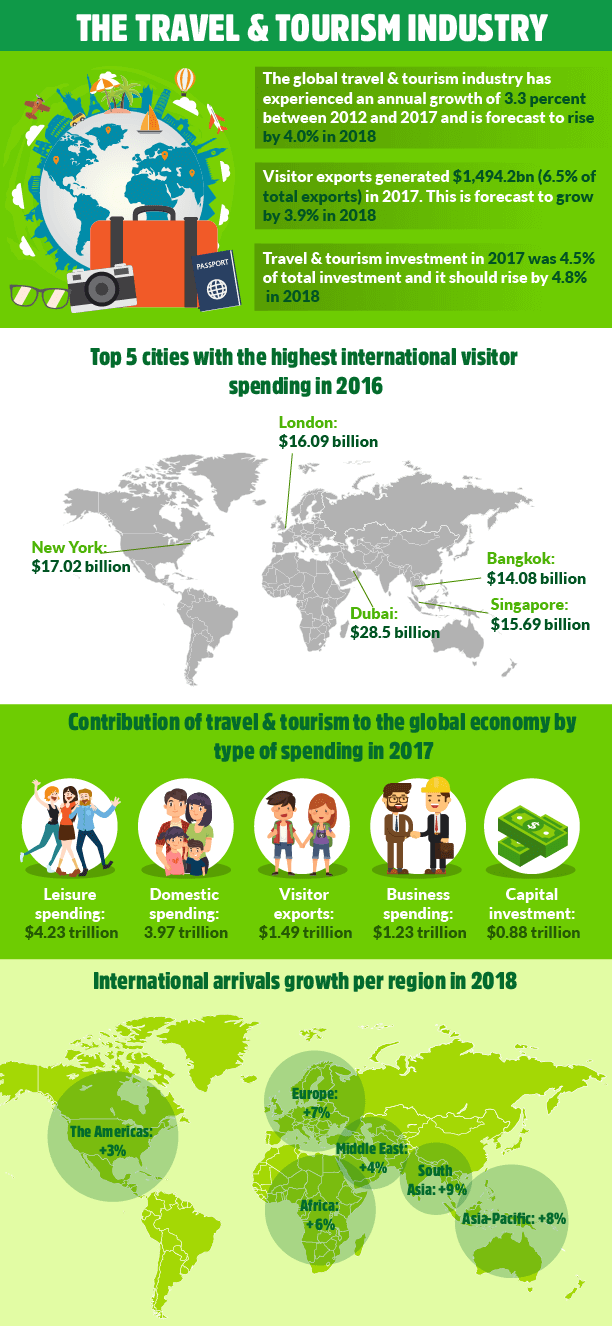
Many segments of the industry are dominated by small businesses and this facilitates access to all those who wish to build their own business. Given this opportunity, implementing the right tourism marketing strategies is crucial to stand out from the competition and to establish yourself as an authority in the industry.
With all the available opportunities for growth and development, creating a solid marketing plan with the four following strategies can be your key to success and the difference between breaking even and making a profit.
#1 Apply storytelling on your social media posts
According to HubSpot , consumers today (among them, tourists) process more than 100,500 digital words a day. Every time they want to know something they ask Google and they can compare prices instantly in three clicks. It’s not that everyone wants to ignore your marketing messages, but given a large amount of information they are exposed to, it’s inevitable that your efforts can get lost in the shuffle. Therefore, it’s necessary to find new ways to communicate to get their attention and get them to interact with your brand .
In a TED Talk , Simon Sinek, founder of Start With Why, said:
People don’t buy what you sell, they buy why you sell it.
When designing your marketing messages on social media it’s not effective to only describe the characteristics of the products or services you offer.
To effectively capture the attention of your target audience and generate more engagement, tell them why your service is made for them while also explaining what they will experience if they decide to buy your product or use your service.
In this sense, stories have enormous power. They generate empathy, transmit confidence, are easy to remember and, most importantly, are easy to share. Storytelling is a technique that allows you to link your product or service with a concrete, symbolic and emotional experience through a story and take advantage of its full potential.
When coming up with stories about your business, try to link them to your product or to the daily activities of your business in subtle ways and put them in your company’s social media posts.
Here are some examples of tourist establishments that use this technique in their Instagram, Facebook and Twitter posts:

If your content on social media doesn’t get “likes” or isn’t shared on Facebook or similar platforms, another proven resource that can help you is creating a mascot or character associated with your brand that acts as the protagonist of your stories.
For example, the travel company Travelocity has associated a traveling gnome with their brand. He appears as the protagonist in several of their publications. In addition, this travel company has created additional social profiles for the character including a fan page on Facebook, a Twitter account and an Instagram account through which they offer exclusive discounts to their followers.
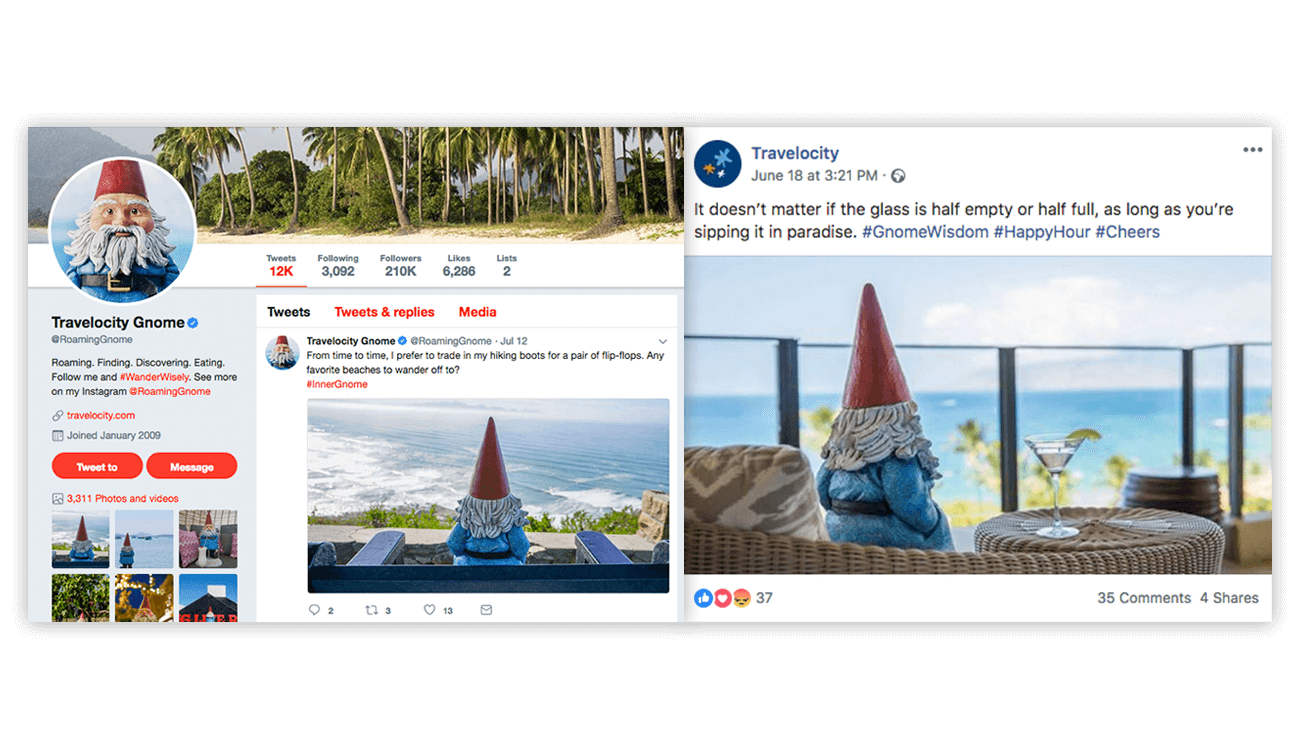
In this way, they manage to promote their trips in an entertaining way that captures the attention of the users, generates engagement and manages to create a community of fans around their character and, therefore, around their brand. On Twitter alone, they’ve got more than 210,000 followers.
#2 Use augmented reality to offer memorable experiences
Within the tourism sector, offering an incredible experience is essential to get customers to remember you, recommend your brand or use your service again. Using new technologies such as augmented reality in your marketing strategy can help you create innovative and memorable experiences for your visitors and, at the same time, differentiate yourself from your competitors.
If you’re not familiar with the term augmented reality, TechTerms provides a very simple definition:
Augmented reality, commonly abbreviated as “AR,” is computer-generated content overlaid on a real-world environment.
Surely you’ve heard of Pokémon Go , a mobile augmented reality game whose launch in 2016 was a massive success. This game uses the GPS of your mobile to locate, capture and engage in battles with virtual creatures (Pokémon). By activating the camera, players can see these creatures through the screen as if they were in a real location. This is augmented reality.
The potential of this technology in the tourism industry is enormous and many tourist establishments are already using it to offer different experiences to tourists. According to a Zenith analysis , in 2018 the pervasiveness of smartphones will reach 66 percent, which means that more than half of the world uses a smartphone.
Hotels were one of the first industries to apply this technology to their marketing actions. For example, the Casa Madrona Hotel in New York used this technology to show tourists walking the street the impressive balcony views of one of its 360-degree suites, as you can see in the following video:
Augmented reality also offers great possibilities for the transportation industry . With a travel app with augmented reality, you could point the camera to a transport vehicle and discover your route, the next stop and places of interest you pass through, something very useful if you are a foreigner.
For example, the transport company, Tunnel Vision , created an app that transforms the New York subway map into an interactive guide in different languages, as you can see in the following video:
According to an analysis of augmented reality published in Harvard Business Review , the three elements that allow the massive adoption of augmented reality apps are:
- Relevant content
- A realistic and compelling interaction of the virtual with the physical environment
- A unique value that goes beyond what other technologies offer
To design a successful augmented reality app that offers a memorable experience, you must make sure it has these three elements.
#3 Create valuable content and optimize your website for SEO
According to a study by Aberdeen , conversion rates are six times higher for those who adopt content marketing than for those who don’t.
Since content marketing is incredibly important, to ensure you get the best results, consider hiring an SEO specialist to help you design a tailored strategy for your business is recommended. That being said, there are things you can do on your own. Here are a few basic tips to help you create a content and SEO strategy for your tourism marketing plan.
- Include a blog on your website and publish content that provides valuable information for your target audience: According to Ascend2, 72 percent of marketers say that creating relevant content was the most effective SEO tactic . Constructing high-quality content that provides valuable information about topics related to your tourism business (such as travel tips or interesting places to visit) can help you increase the authority of your website and, therefore, improve your positioning on Google.
If you manage to publish really interesting posts, they’re more likely to be shared or linked by other sites. This way you will get high-quality inbound links that Google will look at when positioning your website. For example, Jerry’s Motel in Los Angeles incorporates a blog in its website that publishes posts with useful and practical tips for traveling to the city.

- Choose long keywords (more than three terms) that have a high search volume and a low level of competition: According to WordStream, 50 percent of Internet searches have four or more words. You must make sure that the keywords you insert in your content are long and describe your business, products, services or—if it’s a blog post—the subject you are dealing with. Look at the number of times users search for them. This should be a significant figure relative to your pages’ click rates.
Similarly, there will be more chances of getting a good position on Google if the level of competition for your keywords is low. You have tools at your fingertips that help you discover this type of data such as the Keyword planner through Google AdWords, SEMrush or Moz .
- Take care of SEO on your website: There are several factors that influence to a greater or lesser extent the positioning of a website on search engines like Google. SEO experts agree that for Google to position your page or your post for the keyword you have chosen, you must add it in the beginning of the title of the page, in the subtitles , in the first paragraph of the content, repeat it several times throughout the content, in the URL , in the “Alt” tags of the images and in the meta tags (the summaries that appear in the Google’s results pages).
On the other hand, you must also create internal links that allow users to navigate between the different pages of your website. You should also aim to get external links (those that appear on third-party websites and direct visitors to your website). Make sure that your website has a fast loading speed and that it adapts to mobile device screens (responsive design) as Google started penalizing non-responsive websites in 2015.
- Create long and interesting content: Content marketing has changed a lot since Google no longer recognizes short articles with superfluous content. Instead, it gives the first positions to websites that publish pages with long and substantiated content that provides interesting information about a topic. Several studies agree that longer pages or posts tend to get a better position on Google which translates into more traffic. For example, HubSpot discovered that the posts that got more organic visits were those that contained between 2,250 and 2,500 words.
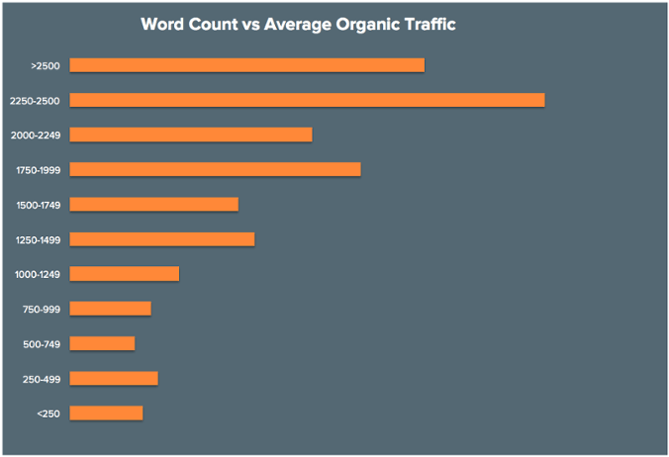
Source: HubSpot
- Create localized content: The tourism sector is a local industry so you can take advantage of this feature to create localized content which will allow you to reduce competition and attract only your potential customers. If your tourism business is located in London, try to create content that deals with topics related to travel and tourism applied to London making sure to include the term “London” in your keywords. For example, a tourist guide agency in London can create a post about “hidden places in London that you have never visited.”
#4 Manage your reviews on TripAdvisor
TripAdvisor is the largest travel review platform in the world and has more than 450 million users and more than 570 million reviews. If you are the owner of a hotel, a restaurant, a theme park or a provider of tourist activities you should know that reviews play an important role in the tourist’s decision. A survey carried out by PhoCusWright reported that 70 percent of travelers read TripAdvisor reviews before choosing a hotel and that 53 percent do not decide to make any reservations before having read reviews .
While it’s true that reviews can be as beneficial as they are harmful to your business, if you manage them well you can avoid having your image seriously affected by a bad review. Responding to negative comments in an assertive and polite manner is the best way to do this. The PhoCusWright survey also revealed that 87 percent of users believe that an appropriate response to a negative review improves their impression of the establishment .
However, you have to be very careful not to create the opposite effect. In order to respond successfully to a negative review you should :
- Respond as quickly as possible
- Do it politely
- Thank the user for sharing his opinion
- Apologize, if necessary
- Demonstrate that your company takes user comments seriously
- Demonstrate that your team will be fully involved to improve the service
- Try to offer a solution whenever possible
Here’s how the Gray Line San Francisco tour company responded cautiously to a negative review on TripAdvisor, following these recommendations:
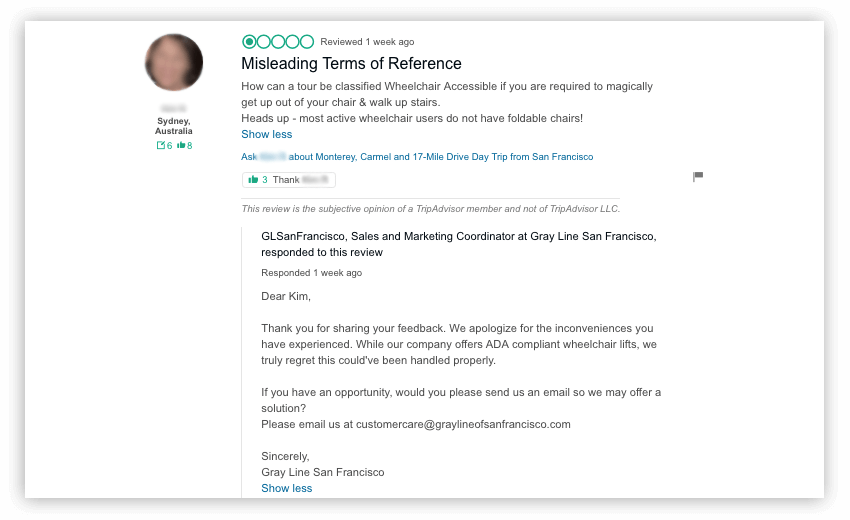
Even so, you shouldn’t see criticism as a threat since the opinions of your customers can provide you with valuable information to implement improvements in your business and thus offer a better experience to future visitors. You should also know that, according to the PhoCusWright survey, 66 percent of users tend to ignore extreme comments when they read reviews, so while positive reviews predominate, you shouldn’t worry too much about the destructive ones.
Taking into account that the reviews are, many times, a key factor in a tourist’s decision when booking a table in a restaurant, a room in a hotel, a tour or when buying tickets for a theme park, not having a full profile on TripAdvisor means closing doors to a community of more than 450 million users willing to discover new sites and miss a great opportunity to promote your company and generate more sales.
There are also other review platforms that are gaining popularity, such as Yelp , which currently receives about 130 million unique visits and has more than 70 million reviews.
Unlike TripAdvisor, Yelp is not intended exclusively for the tourism and travel industry (there are reviews on all types of businesses), but it has an important base of reviews on restaurants, hotels and other companies operating within the tourism sector. If you want to discover how to incorporate this platform into your marketing plan, read How to increase reviews on Yelp .
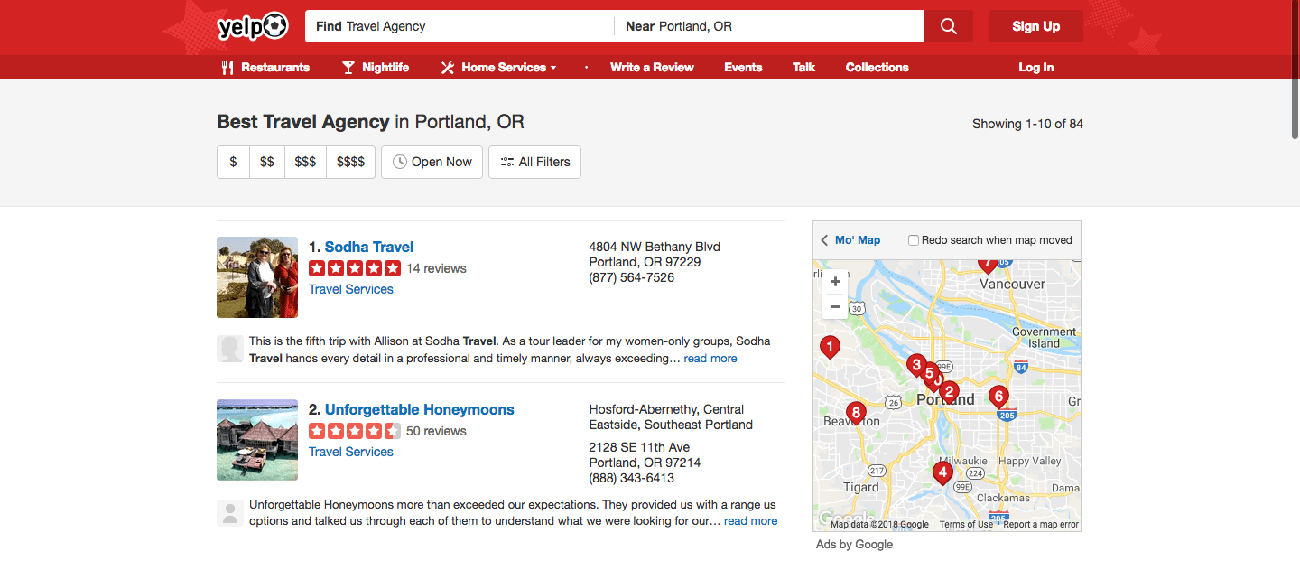
The implementation of these four tourism marketing strategies will help you increase the visibility of your business, attract your target audience and get a better return on your marketing investment. Although these techniques can be applied in most cases within the tourism scope, take into account the needs of your business and choose those that best suit it.
RELATED ARTICLES MORE FROM AUTHOR
Interview with nuh gluten – msme digitalization plan in jamaica, how to increase visibility on google, what is google adsense and how to monetize your hobbies , guide to youtube ads for ecommerce, 4 best practices for local magazine advertising, marketing automation for beginners, marketing para peluquerías: 5 ideas, marketing for clothing store: 5 strategies to better “dress” your business, 3 jewelry marketing ideas to attract more customers, marketing para clínicas veterinarias: 5 estrategias, editor picks, interview with develop digitally limited – msme digitalization plan in jamaica, interview with camaria school – msme digitalization plan in jamaica, interview with health and wellness consultant to travelers – msme digitalization..., popular posts, popular category.
- Strategy 14
- Acquisition 10
- Food Services 5
- Real Estate 4
- Minority-Owned Business 2
- Massage Therapy 2
- Email Marketing 2
← Back to Articles
Apr 12, 2019
11 Digital Marketing Campaign Tips for the Tourism Sector (Part I)
- Digital Strategy
The global travel market is huge, and marketing for tourism is constantly changing, especially in the post-Covid world .
With such a large audience and a massive potential gain, the tourism and travel sector is fiercely competitive. As such, brands must use innovative digital marketing strategies to stand out.
In the first part of this article, we’ll explore 5 key tips and strategies for success at the intersection of travel and digital marketing.
1) Keep The Target Audience Front And Centre
This might sound like a lesson from Marketing 101, but it’s one that is often forgotten. It’s impossible to create a successful campaign without knowing who it’s designed to serve.
This is just as true for companies in the travel and tourism space as it is for any other industry. Particularly as the industry itself is so focused on user experience as a measure of success, marketing campaigns need to be tailored to the right audience or they won’t succeed!
Identify Your Target Customer

The first step is to identify your target customer.
Think about the travel products you sell; are they geared towards families, young couples, solo adventurers, senior travelers, or a mix of multiple demographics? From there, you can begin to pull out characteristics that form your brand’s buyer persona.
Be Specific
Let’s say, for example, that the bulk of your products cater best to young couples. Knowing this information, there are some customer characteristics you can immediately begin to target.
This might include people under 35, those without children, and couples who are recently married. The honeymoon market may be a good fit for what you’re offering, and so it would make sense to focus some of your marketing strategy on that specific niche.
It can also be helpful to put yourself in the place of your target persona.
For example, imagine yourself as a mother or father planning a trip for your family. Which destinations would provide the best mix of activities, entertainment, and good value? And where would they find out about your products? As well as the standard Google search, parents might check reviews on Facebook or gather ideas from a discussion forum.
Before you undertake any other marketing activities, it’s critically important to have a profile of your target customer pinned down. This persona informs every other marketing process.
2) Utilize All Aspects of Social Media
We don’t need to tell you how profound an impact social media has had on digital marketing.
In the travel sector, platforms such as Facebook, Instagram, and Pinterest help travelers find inspiration for their holiday destinations, choose the perfect hotel, and discover exciting activities and attractions.

Meaningful Engagement Throughout
Prospective customers are already using social media, so it’s important to be where they are. Travel/tourism brands must have a purposeful social presence.
It’s not enough to simply set up an account and regurgitate content that’s posted elsewhere. Businesses should be prepared to engage meaningfully with their audience by starting discussions, replying to comments, answering questions, and offering exceptional customer service.
All of these activities are facets of a wider digital marketing campaign, taken in the context of how they help a brand achieve its goals.
For example, responding constructively to comments on a Facebook video might not seem like a crucial marketing task, but it’s an activity that enhances the appearance of a business and demonstrates an ability to engage constructively with its audience. Put yourself in the place of a traveler agonizing over which of two hotels to book.
The decision could come down to something as seemingly innocuous as witnessing a positive social media interaction. Every exchange might be the motivating factor that turns a visitor into a customer. In that context, it’s a supremely important facet of marketing.
Leverage Visual Media
Social media is rife with competition, particularly in the travel and tourism industry, but there are creative ways to use this to your advantage and stand out.
Travel has the unique selling point that it can play on the wanderlust of others so pictures and video can work wonders.
Travel Alberta are a great example of how leveraging video can increase your reach! Their YouTube channel proves that by showcasing the experience and atmosphere you can experience.
Another excellent example of this is @VisitCalifornia on Instagram who regularly shares images of the ‘Californian lifestyle’. They also have dedicated hashtags to showcase the best travel photos for that extra push of social proof.
Paid Ad Campaigns
Obviously, brands can also advertise directly on platforms like Facebook, Instagram, and Twitter.
Setting up an account on each platform is simple, and running a campaign is relatively straightforward. You’ll also have access to engagement data and insights that are useful for finessing your content and strategy, both now and in the future.
Although a specific brand’s cost per click varies according to several factors, the average CPC for the travel and hospitality sector on Facebook is $0.63 , one of the least expensive across all sectors. It’s also cheaper than Google, at around $1.5 per click. .
The combination of cost-effectiveness and customer relationship-nurturing properties make social selling pretty bankable.
3) Identify Key Moments on the Booking Journey
Travel isn’t generally an impulse buy. Whilst many of us know someone who has suddenly decided to book a ticket, pack a bag, and escape on an adventure, it’s certainly not the norm.
In fact, the process of arranging travel – from initial interest through to thorough research, price comparison, and booking – has a tendency to be prolonged and thorough.
Understanding the travel customer journey is incredibly useful for marketing professionals in the travel/tourism sector. Google breaks it down into four stages:
During the initial phase, prospective travelers are open to all possibilities. They haven’t made a firm decision about where to go and what to do, and they’re looking for ideas.
At this stage, travelers have pinned down a destination, but they’re still flexible about dates, hotels, and activities.
Dates, flight times, and accommodation preferences are all confirmed. It’s time for travelers to make reservations!
Experiencing
Travelers are on their trip and sharing their adventures online. At this stage, they may still be searching for ad-hoc activities and experiences while in-destination.
Think about the ways in which you can target potential customers at each stage. For example, if your products are city tours, you’ll have the ability to influence visitors into choosing one of your destinations, advise them which times of year are best to visit, highlight how easy your booking process is, and offer the chance to purchase tickets flexibly while they’re in-destination.
Airbnb has done a great job of providing a resource that naturally feeds into their product. In collaboration with local hosts, they’ve put together Airbnb Guidebooks , which are packed with insider knowledge from major destinations.

When a visitor finds an attraction, activity, or dining spot they’re interested in, they simply click ‘Add to your plans’ and it’s put into a virtual scrapbook. And of course, towards the end of each page is a section with nearby Airbnb properties for travelers to choose from. It is an ingenious mix of Lonely Planet, TripAdvisor, and their own booking site.
Every part of the process holds the potential to guide travelers into your sales funnel. Again, utilize your buyer persona to create digital content that targets the right people on the right platforms at the right time.
4) Know Which Devices They Use – and When!

The multi-stage travel booking process can often take place on more than one device. With researching, comparing, reserving, and purchasing travel products it’s unlikely to all happen at once.
For example, an initial search for destinations – at the dreaming phase – might take place on a mobile device during a dreary morning commute. Comparing hotels may be undertaken on a tablet, while a customer might prefer to make their final booking on a laptop.
Optimize your content, its design, and its placement for every stage of the traveler’s buying journey. Turning again to the example above, content that’s designed to appeal to visitors at the dreaming and planning stages may be most effective if tailored to mobile devices, while special offers for the booking phase might be better optimized for desktop.
And during the final stage, when customers are looking for things to do in-destination, your best bet is to return focus to mobile, as this is what your prospective customers are most likely to use .
Although, as always, this depends on the preferences and behaviors of your target customer.
5) Welcome ‘Social Proof’

Travelers are routinely using review sites such as TripAdvisor, Google, and Yelp to guide their buying decisions.
Be proactive by providing review sites with high-quality images and videos that show off your brand and its products. This helps you to direct – to an extent – the impression of your business.
Of course, with impartial review sites, the bulk of content available is outside of your control. That doesn’t mean you’re excluded from the narrative. Respond to all reviews your brand receives, good or bad.
Address The Negative
If you receive constructive criticism, provide a courteous response that addresses each point made by the reviewer. Demonstrate that you have the ability to take advice on board, and if you are able to demonstrate remedial work already undertaken, share it.
Not only will this help to counterbalance the impression of the reviewer, but it’s a clear sign to prospective customers that you listen and take prompt action. Remember, a seemingly small action can make the world of difference in a buying decision.
Positive reviews are more of a pleasure to receive! Respond to each of these, and acknowledge aspects of your service that really impressed each reviewer.
Incentivize Reviews
Reviews and social proof form the influential part of your marketing campaigns. Nothing sells like the good recommendations of others!
So, let people do the marketing for you by offering incentives to those who give feedback or testimonials.
These first set of digital marketing tips for the travel and tourism sector should help get you thinking about the campaigns you are currently running and new ones to promote products or services.
Keep tuned for the remaning 6 tips to follow next week....
Related Free Video Lessons
- Social Customer Service Social Customer Service Metrics
- Social Customer Service Improving Social Customer Service
- Digital Communications Digital Communications Planning
- Strategy Formulation Plan SWOT Analysis
Related Content
Toolkits: digital marketing strategy action plan template, toolkits: one-year gantt calendar template 2024, toolkits: digital marketing project brief template, articles: what are the top digital marketing trends for 2023, articles: universities & colleges: 5 ways to boost student employability in 2024, articles: data management systems and tools.
- Categories:
Recommended For You
Toolkits: seasonal checklist & calendar template, toolkits: market expansion tool, ebooks: ebook: the key social media platforms - a complete marketing guide, articles: how to choose the most qualified digital marketing agency, articles: what is emotional intelligence & how can you improve yours, cpd points available.
This content is eligible for CPD points. Please sign in if you wish to track this in your account.
CPD Points Available
This content is eligible for CPD points. Please login if you wish to track this in your account.
- View Courses
- Change Password
Get the latest digital marketing data, insights and toolkits from DMI
Marketing91
What is Tourism Marketing? 15 Strategies in 2023
March 22, 2023 | By Hitesh Bhasin | Filed Under: Marketing
From hotels and other types of accommodation to car rental services, airlines , restaurants, entertainment spots, and travel agents – tourism marketing encompasses a wide range of advertising and marketing strategies often used by companies in the tourism and travel industry themselves. All these various marketing efforts are put together under one collective name – Tourism Marketing!
Tourism marketing is an essential tool for a business to ensure they are standing apart from its competitors, garnering customers, and creating brand recognition. Nowadays, various digital marketing platforms such as websites, online ads, email marketing campaigns , and social media marketing outlets have become vital components of modern tourism marketing initiatives for businesses.
Table of Contents
What is Tourism Marketing?
Tourism marketing is a type of marketing used by businesses operating in the travel and tourism industry to attract tourists to a business name or particular location which can be a state, a city, a particular heritage site or tourist destination spot, a hotel, or a convention center anything.
Achieving success in the travel and tourism industry requires thoughtful Tourism Marketing campaigns that are designed to generate brand awareness , create both, reach the most target audience or potential customers, drive traffic, foster loyalty among existing clients, and create a captivating customer experience . By utilizing these strategies, businesses can effectively engage with travelers while generating more sales opportunities.
Tourism Marketing has been profoundly impacted in recent years by digital development, as well as changes in consumer attitudes and desires. Crafting successful Tourism marketing messages today entails taking advantage of social media platforms, featuring user generated content, leveraging online reviews and search engines to your benefit, collaborating with influencers to drive traffic and expand reach, and experimenting with various channels for targeted messaging to attract travelers and optimize their customer journey in a way to convert them into loyal customers.
Why is Tourism Marketing Important?
To make a tourism business thrive, savvy marketing is an absolute must. By staying up-to-date with current trends and launching impactful campaigns, businesses can boost the recognition of their brand, gain customer loyalty and attract travellers. Moreover, tourism marketing holds promise for contributing to the economic growth of the region by driving tourists towards local enterprises.
The tourism industry is one of the biggest in the world and therefore highly competitive. To succeed, businesses must differentiate themselves from their competitors by promoting and advertising what makes them unique, showcasing why they’re the best option for tourists, and advertising and highlighting any special features that set them apart.
To allow businesses to gain a competitive advantage , marketing is essential. Many of the top tourism marketing approaches concentrate on highlighting a business’ unique selling point and broadcasting it effectively. Moreover, marketers must keep abreast with current trends to generate an effective promotional mix and deploy the most viable methods for disseminating their message across all channels.
Understanding the concept of Tourism Marketing
Tourism marketing is associated with most businesses, with marketing strategies in the field of tourism. Today there are many countries in the world, where the tourism industry plays a major role in economic development , enhancing their GDP.
In such cases, tourism and digital marketing become important things. Many of the places are generally the hotspot for tourists like the Taj Mahal in India. Now places like these are considered the perfect areas where one can boost tourism through digital marketing.
The places which are more likely to be the major spots for attracting tourists are the places where tourism marketing flourishes the most. Now tourism marketing is all about applying several marketing techniques and strategies to create and boost the tourism industry of that place.
For successful tourism marketing to take place, the thing that is required the most is that the brands should speak for themselves in such a way that makes sense that their voices can be heard in the targeted markets. This way they will be able to generate the cleanest successfully. Also, they need to be really careful in providing services to clients.
This is because if the customers are happy with the services chances they will spread the word and this may bring them more customers. In the case of tourism marketing, it becomes easy to find the right audiences and create content to draw the attention of the targeted customers to the website by providing encouraging content. Thus strategic planning , content marketing, and branding is the key to effective tourism marketing.
With it being carried out by keeping these two points in mind, chances are that the company that is involved in tourism marketing will be able to gain the advantage over their existing customers in no time and become a monopoly in the tourism industry.
What are the different ways in which Tourism Marketing Can Be Done in 2023?
Now various methods are applied for tourism marketing to flourish. Below are some of the important ways in which the tourism marking of any place is given a boost.
1) Location marketing
In this type of marketing strategy , the main focus of tourism marketing is one bringing people’s attention to a specific location. In this strategy , no recommendations are made with respect to a particular site or any accommodation. Now some locations are already so popular all over the world that tourism marketers don’t have to make many efforts to attract their attention to such places.
All they need to do to attract customers is remind them of such locations and chances are that the consumer can easily get convinced to spend money and visit any such place. For example, Las Vegas is popular for its undying charm and full of life kind of prospects.
Now there s also a popular slogan related to Las Vegas which is ‘What happens in Vegas, stays in Vegas’. This slogan has gained worldwide popularity and almost everyone wants to visit Las Vegas at least once.
So here the tourism marketers have to simply remind people of how amazing this city is and what are the different ways in which they can have the time of their lives here. Another example that can be taken in Florida.
They use a more ‘benefit-oriented’ approach. Their slogan and website are ‘The Sunshine State’. This way they are presenting their state with a joyous and charming climate and as a perfect place for beach and football lovers. Also with their slogan and website, they are successfully able to present their state as an ideal ‘summer vacation’ destination and are definitely a dream for many to visit this place.
Thus location marketing is one of the simplest forms of tourism marketing in which without even putting much effort, with the brand value and the popularity of some specific location, the customers can be attracted.
2) Activity marketing
Now, this type of tourism is carried out keeping in mind both the location and the activities that are performed in such places. This type of tourism marketing strategy usually keeps in mind travelers who are adventure lovers or activity freaks.
There are many other sites and locations all over the world that are famous for some specific activities. Like Alaska is famous for snowboarding, Yellowstone national park is famous for thrilling activities like hiking, and camping and is a perfect place for all nature lovers, similarly, there is ‘Colonial Williamsburg’ which attracts all history lovers.
Thus depending on the target audience and the type of activity that a particular place is famous for, tourism marketing can be carried out. Some people may be adventure lovers, some people may be looking for art and culture some people love hunting, depending upon their area of expertise and interest, the tourism markers can segment the groups of potential visitors and customers and approach them.
Thus activity marketing is a form of tourism making and social media marketing that emphasizes the booking process and bringing the attention of a customer to particular places on the basis of the activities that are performed there.
3) Corporate marketing
This is quite an interesting approach to tourism marketing. Now it has been found that a large number of people working in corporate sectors have to travel to different places to attend a conference or a meeting.
Then according to research, it was found these locations were ideal for tourists, and a number of people came to attend those places. Also, they brought their families and their loved ones as well. Now considering these scenarios’ latest trends in mind, corporate influencer marketing can contribute a lot to tourism marketing as it has significant potential.
Here the tourism marketers take advantage of the fact that by planning the business meeting in touristy places, people come in large numbers thus they can make a lot of profit out of it.
What are the four basic pillars of Tourism Marketing?
The foundation of tourism marketing stands firmly on four of its important pillars which are the product , the price, the place, email marketing, and the promotion.
Let us understand each of these separately as to how they contribute to tourism marketing!
Marketing Mix of Tourism
1) product in tourism marketing.
One of the most important aspects of the tourism marketing strategy is to determine the effect of the selling benefits and the other types of benefits that are re-obtained by competing with their rivals in the same market .
Tourism marketers need to focus more on such destinations that provide both business advantages to travel brands and pleasure to their customers. These pleasures depend on several factors like the ease of traveling, facilities of the sites and the hotels, the nightlife of that place, activities offered, and the overall culture of that place.
Thus by considering these factors, tourism marketers will understand the areas that have to focus more on, so that marketing can be done effectively.
2) Price in Tourism Marketing
The price point is yet another important aspect of tourism marketing. Now many people avoid traveling due to money-related issues. And this is where tourism marketing comes in to save the day. Today so many mobile apps have been developed, on which if a person books a hotel r a transport like a flight or a train, they get discounts. This attracts a lot of customers.
Along with the free referral marketing, they also try to give value-added services to their customers. Some hotels also offer free shuttle services to their visitors. Also depending on whether it is a high season or an offseason, the prices are altered.
3) Place in Tourism Marketing
Now for tourism marketing to earn a profit, deciding the location where they want to perform the marketing can play a key role in how far they can go. The place refers to the area where the products and services can be distributed.
Now in tourism and destination marketing, the location and the destination marketers offer their products and services to their customers through travel agents, tour operators, inside sales teas, etc. The distribution of their products and services to visitors can be done through catalogs, online, sites, mobile devices, websites, stores, etc.
4) Promotion
In this numerous different strategies and technologies are used for the promotion of any specific area or tourist destination. In fact, trade magazines and meeting planners are also efficient ways for promotion purposes.
These often come with many other forms of discount coupons, brochures, etc. also they try their target customers to come across the ads that pop up on the website to make them aware of the various tourist places.
15 Tourism Marketing Strategies in 2023
1. prioritising hygiene and safety via marketing communication.
Tourism marketers must now prioritize safety and hygiene to give their customers peace of mind when they travel. By highlighting the protocols that are being taken, tourists can rest assured knowing they will be protected while visiting.
2. Developing Loyalty Programmes
Loyalty programs are the ideal way to demonstrate your appreciation for existing customers and stimulate repeated patronage. Tourism marketers should construct loyalty programs that will not only retain existing customers but also appeal to fresh audiences.
3. Capitalising on Voice Search
In the age of voice search, it is essential for tourism marketers to create content that can be quickly found and accessed. Optimizing your site and content for this new technology will bolster your site for visibility and success in the long term.
4. Facilitating User-Generated Content
User-generated content, such as ratings and reviews on social media, is critical in helping customers make informed decisions. User-generated social media content is one of the key tourism marketing trends.
5. Deploying Artificial Intelligence:
AI technology is a valuable asset for Tourism marketers, allowing them to track customer behavior and create personalized brand experiences tailored to each individual. This can help customers find the brand information they need quicker and more easily than ever before.
6. Not Neglect Review Marketing
Reviews and ratings are a critical resource for Tourism companies, making them an invaluable asset in swaying potential customer decisions. Any Tourism marketer must recognize the importance of reviews if they wish to stay competitive.
7. Enhancing the Guest Experience & Satisfaction Through Chatbots
Chatbots can be a vital tool in creating an effortless, tailored experience for all customers. Chatbot technology should be a top priority for the hospitality and tourism industry to provide quick customer service and support, as well as respond promptly to any inquiries.
8. Investing in Remarketing Efforts
Maximizing your Tourism business’ potential by tapping into already engaged customers is a surefire way of increasing sales. Leverage the power of remarketing to maximize your potential and gain more qualified leads.
9. Utilising Augmented Reality Technology
Augmented reality provides the ideal platform for tourism businesses to build mesmerizing and unforgettable experiences for their customers.
10. Prioritising Personalisation
Customization is a crucial element of this form of marketing. By personalizing content and messages to the target audience’s wants and needs, Tourism marketers can engineer and create an experience that will ensure positive word-of-mouth publicity for their business or brand.
11. Exploring Metaverse
The metaverse is becoming more and more popular with tourism companies, as it allows them to give their customers an unparalleled, immersive experience.
12. Using NFTs
Non-fungible tokens, or NFTs, are quickly becoming a widely recognized trend. Tourism companies can harness this technology to propel their marketing campaigns and draw in more visitors.
13. Promoting Virtual Reality (VR) Tours
Allow your customers to explore new destinations without even having to leave their homes – with VR tours, the possibilities are endless!
14. Focusing on the Customer Experience
Crafting an exceptional customer experience should be the primary focus of any Tourism promotional strategy . Optimizing customer experiences on all marketing channels is crucial.
15. Embracing content and influencer marketing
Content and influencer marketing are essential building blocks of any successful tourism strategy. It helps in optimizing the presence of a travel business in the search engine.
Thus, tourism and travel agency marketing are one of the branches of marketing that deal with the tourism and travel industry only.
It is essential to carry out efficient tourism marketing, as one can make a lot of money through this because there are so many people in this world who love traveling, and this can help the tourism marketing industry to flourish their business.
Liked this post? Check out the complete series on Marketing
Related posts:
- 15 Promotional Strategies to Use in 2023 (Types, Steps & Role in Marketing)
- What is B2B Marketing? A Comprehensive Guide with Strategies, Examples & Trends in 2023
- Database Marketing – Definition, Types, Importance and Strategies
- One-to-one marketing: Definition, Examples and Strategies
- What Is Affinity Marketing? Definition and Strategies for Success (Updated 2024)
- What is Consumer Marketing? Definition, Strategies & Example
- What is Offline Marketing? Strategies and Advantages
- Trade Marketing: Definition, Strategies, Advantages, Disadvantages
- Luxury Brand Marketing – Concept and Strategies
- Healthcare Marketing – Definition, Strategies and Challenges
About Hitesh Bhasin
Hitesh Bhasin is the CEO of Marketing91 and has over a decade of experience in the marketing field. He is an accomplished author of thousands of insightful articles, including in-depth analyses of brands and companies. Holding an MBA in Marketing, Hitesh manages several offline ventures, where he applies all the concepts of Marketing that he writes about.
All Knowledge Banks (Hub Pages)
- Marketing Hub
- Management Hub
- Marketing Strategy
- Advertising Hub
- Branding Hub
- Market Research
- Small Business Marketing
- Sales and Selling
- Marketing Careers
- Internet Marketing
- Business Model of Brands
- Marketing Mix of Brands
- Brand Competitors
- Strategy of Brands
- SWOT of Brands
- Customer Management
- Top 10 Lists
This was a great article! Now I’m interested in a career in tourism marketing. How do I start? I already write travel content/copywriting blogs for an agency. Where would I go from there?
this article really helped me in conducting research on tourism. Thank you very much
This article helped me alot on my academic research
Hello,the article is highly assisting and I am seriously having interest in studying Tourism Marketing.
This information was very helpful
hey! This is a good and interesting article about tourism marketing. I am a second degree student in tourism business administration,the program is all about tourism as a business perspective.if you can possible,please post such relevant articles via email address that i have attached below the space provided.
Leave a Reply Cancel reply
Your email address will not be published. Required fields are marked *
- About Marketing91
- Marketing91 Team
- Privacy Policy
- Cookie Policy
- Terms of Use
- Editorial Policy
WE WRITE ON
- Digital Marketing
- Human Resources
- Operations Management
- Marketing News
- Marketing mix's
- Competitors
See how Cvent can solve your biggest event challenges. Watch a 30-minute demo.

Destination Marketing Strategies that Attract Attention
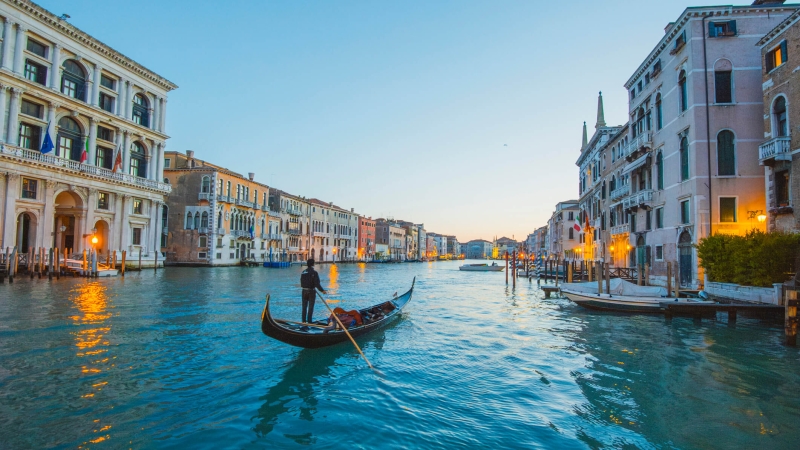
Marketing is integral to any business strategy, but targeted advertising is essential in hospitality and tourism. Although repeat guests and loyal customers provide critical revenue streams for local economies, locations must continually expand their audience reach to remain competitive and capture the attention of new visitors. The right destination marketing strategies can generate more interest in travel to your region, driving valuable tourism dollars into the local economy and the businesses in it.
Discover the value of location-based marketing and how every town, regardless of landscape or population size, can profit from strategically promoting its destination. Whether you’re by the beach, in the city, or just off the highway in a small town, we’ll show you how locations everywhere can use destination marketing strategies to boost business.
Destination marketing strategies that drive tourism dollars
What is a destination marketing strategy.
Destination marketing is a form of advertising designed to attract customers to a particular place. Instead of focusing on a distinct product or service, it centers around the unique atmosphere and experiences a specific location provides visitors.
From vacation hot spots to remote getaway locations, destination marketing strategies captivate consumers and promote travel to desirable places.
Who benefits from destination marketing?
Many businesses benefit from the revenue and tourist traffic destination marketing generates. Various hospitality and service-based companies use location-based advertising to attract the attention of potential travelers, including:
- Destination management organizations and convention and visitors bureaus
- Travel agencies
- Transportation services (e.g., airlines, car companies, bus tours)
- Entertainment and event venues (e.g., concert halls, wedding venues)
- Attractions (e.g., amusement parks, museums, recreational facilities)
- Service-based businesses (e.g., restaurants and retailers)
- Lodging partners (e.g., hotels, resorts, convention centers)
- Local and state governments (e.g., parks or historical sites)
Why do destination marketing strategies matter?
Destination marketing showcases what sets your destination apart from other enticing locations. It creates an immersive experience for consumers that enables them to imagine what it’s like to actually be in a particular place—to see the sights and smell the scents.
From corporate flyers and digital nomads to vacationers and off-the-grid adventure seekers, travelers turn to destination marketing to get an idea of what to expect from a particular location. Your marketing strategy helps lay the foundation of consumer expectations. For example, if your destination marketing focuses on luxurious tropical getaways, that’s what guests will expect.
The true power of destination tourism lies in its ability to impact every part of a local economy, attracting businesses, tourists, and other travelers to the region. By implementing various destination marketing strategies for distinct target audiences, you can measure which types of hotel guests or recreational groups are attracted to your market. The more you know about your ideal consumers, the better equipped you will be to advertise activities, amenities, and attractions that appeal to them.
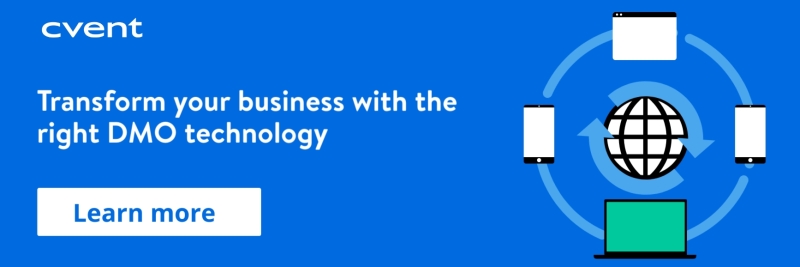
How is destination marketing different from other regional marketing?
Destination marketing organizations (DMOs) are responsible for promoting their destination to tourists, travel planners, corporations, and other consumers that drive valuable revenue to the local economy. DMOs and similar organizations, like Convention and Visitors Bureaus (CVBs), employ various marketing strategies to attract visitors. They may turn to social media to advertise the opening of a new park or engage in data-driven email marketing to get the word out about upcoming events. However, destination marketing is a specific advertising strategy that builds consumers’ desire to visit your location by advertising the attractions that set it apart.
Destination marketing lets consumers know what they can expect from a visit to your region. It captures the atmosphere, energy, and essence of your locale. Does your destination offer plentiful recreational opportunities or headlining entertainment? Is your destination a peaceful, remote location offering travelers an escape or a trendy tech hub in the middle of a bustling city?
Unlike other regional marketing campaigns , destination-focused advertising promotes the overall appeal of a location instead of a particular business or attraction. It pinpoints what makes your destination unique and why others should experience it.
Destinations that nailed their marketing campaigns
To better understand what destination marketing looks like in action, let’s review some of the most powerful location-based tourism campaigns from the last decade. These four destinations understood the power of destination marketing and used it to launch wildly successful campaigns.
1. Inspired by Iceland
In 2010, a volcanic eruption led to a downturn in Iceland’s tourism, with many travelers holding misconceptions about its safety. To reinstate the country’s place as a renowned tourist destination, the Icelandic government partnered with the City of Reykjavik, Promote Iceland, and other tourism companies to launch “Inspired by Iceland” in 2020.
In addition to strengthening Iceland’s image in the global tourism market, the Inspired by Iceland tourism initiative was part of a long-term destination marketing strategy designed to increase the production of Icelandic exports through government and industry cooperation. Many Icelandic industries have benefited from the campaign , including the creative, green energy, and seafood sectors.
2. Travel Oregon
Oregon, one of America's most scenic and awe-inspiring locations, is split into seven separate tourism regions . Each locale has a Regional Destination Tourism Management Organization (RMDO) that acts as the tourism liaison for that region. Working together, the RMDOs launched Travel Oregon to drive leisure and business travel to their area.
The Travel Oregon campaign put the state on the map as a premier travel destination. It appealed to customers by combining multiple marketing strategies, including captivating videos, sponsored posts, social media content, banner ads, and print ads. The engaging approach had something for everyone, with its fish-shaped robot tour guide and satirical content quickly garnering travelers’ attention. Travel Oregon maintains a formidable reputation for its memorable, humorous messaging.
3. Doors of Thrones
If you’re familiar with Game of Thrones, you might know that many scenes from the HBO hit show were filmed in Northern Ireland. In 2014, Northern Ireland’s destination marketing organization, Tourism Ireland , took advantage of the show's popularity and formed the first Thrones-based marketing partnership with HBO to launch Doors of Thrones.
The Doors of Thrones campaign centered around ten intricately carved doors. The wood for each door came from the Dark Hedges and was sculpted to represent a different episode from the show’s sixth season. They were placed at various locations (primarily pubs) nationwide and promoted on social media. Travelers flocked from around the world to see the intricately carved pieces and explore famous sites from the show.
Tourism Ireland used the show's incredible popularity to attract travelers and superfans. ITV News, MTV, Cosmopolitan, and other major media outlets raved about the creative pub crawl, further expanding the campaign’s already broad reach. Ultimately, the massively successful campaign reached 126 million people . It also drove tourism, traffic, and revenue to Northern Ireland and its businesses, generating £17 million ($22 million) in 2016 . Overall, the destination marketing strategy resulted in a record year-over-year tourism increase of 8%.
4. Explore Georgia
Explore Georgia was a fun and easily accessible destination marketing campaign launched in 2016 . The Instagram-based photo competition excited a variety of traveler types spanning all walks of life. Participants were encouraged to post photos of Fido, the #ExporeGeorgiaPup , adventuring through the state.
From domestic tourists to overseas travelers, Fido’s family-friendly appeal helped grow Georgia's presence in online tourism spaces by promoting the state as a pet-friendly travel destination. The inexpensive social campaign reached 1.1 million Facebook impressions and drove 14,000 Instagram users to the website of Parker Whidby, Explore Georgia’s destination marketing manager.
Industry-leading destination marketing strategies
You know how destination management organizations promote their destination, but how do individual businesses do it? From video advertising to social media marketing, there are so many content options to choose from. Here are four innovative and industry-leading destination marketing strategies from hospitality brands.
Check out 2023's top destinations
1. Feel the Beat of the City | Four Seasons Hotels
In 2022, the Four Seasons Hotel New Orleans launched an engaging new campaign: Feel the Beat of the City. The marketing campaign consisted of advertisements celebrating New Orleans’ one-of-a-kind atmosphere. In vibrant video advertisements featuring big brass bands , The Four Seasons Hotel New Orleans appealed to consumers by capturing the spirit of The Big Easy.
The campaign invited consumers to experience the city’s culture, cuisine, and music in an exciting new way—and it worked. Due to the campaign's success, Four Seasons expanded the Feel the Beat campaign to promote multiple destinations worldwide , including Austin (TX) and Dubai.
2. 30 Stays, 300 Days | Marriott Bonvoy
30 Stays, 300 Stays was a spectacularly successful social media campaign from Marriott Hotels. The TikTok branded hashtag challenge promoted the Marriott brand all over social media while attracting travelers’ attention to ten of the chain’s most stunning hotels . Participants were instructed to create an engaging video explaining why they should be chosen to become one of three official 2022 TikTok Correspondents for Marriott.
To win, contestants had to follow Marriott Bonvoy’s TikTok account and post their video with the branded hashtag #30stays300days. Thanks to the viral challenge, the brand’s account exploded— growing from 6K followers to more than 70K. In addition to driving traffic to their TikTok account, the marketing campaign introduced a whole new audience to Marriott, particularly the magnificent destination stays included in the prize package.
3. Live Hologram Bar | KLM Royal Dutch Airlines
In 2019, KLM Royal Dutch Airlines shook up destination marketing when they invited travelers to meet, chat, and exchange local tips at the Hologram Bar while waiting for their flights. Pop-up hologram bars were installed at airports in the Netherlands, Norway, and Brazil. The immersive video destination marketing campaign connected tourists and travel enthusiasts in real-time, enabling patrons to project themselves into their destination airport. KLM’s one-of-a-kind, engaging, and informational experience provided consumers with an exciting new way to explore global destinations.
4. Where do you want to go? | Melia Hotels
Melia Hotels spearheaded the industry’s approach to digital display marketing. Featuring a wide range of interactive elements and unique designs, their engaging display ads drove online traffic to specific landing pages through powerful messaging, interactive buttons, and personalized content. By asking travelers, “Where do you want to go,” Melia Hotels International launched its sprawling brand with online destination marketing.
Destination marketing strategies and best practices
Drive travel and tourism to your destination by showing consumers what makes it better than the alternative. Increase awareness about your region and strengthen its reputation with these marketing strategies:
1. Define your destination’s unique selling point (USP). Determine what sets your location apart from everywhere else in the world. What can visitors experience there and only there? What attractions, resources, or hidden gems should tourists know about? Identify what makes your location wholly unique and make it the focus of destination marketing campaigns. Maximize your destination’s USP by partnering with tourism-based businesses in the area to gain more feedback.
2. Know your target audience. Think about what travelers want from a visit to your area, and create destination-focused campaigns highlighting how you’ll give it to them. Campaigns showcasing high-tech coworking spaces, authentic international restaurants, and the town’s nightlife could help attract business travelers, remote workers, or young tourists looking for an exciting weekend away.
3. Use geotargeting. Geotargeting is a powerful form of digital marketing that utilizes location data to target consumers with relevant marketing materials. This location-based advertising strategy uses consumer data points (e.g., IP addresses or GPS coordinates) to identify their location, making it easier for DMOs to ensure their marketing materials reach the right customers at the right time. Incorporate geotargeting into your destination marketing strategy to capture consumers' attention when they’re in the area. Identify what brought them to town to learn more about your destination’s feeder cities.
4. Create experiential marketing campaigns. Engage customers’ senses with interactive marketing they’ll remember. Instead of telling travelers what to expect from your destination, create advertising that allows them to experience it for themselves. Immersive forms of experiential marketing , like augmented or virtual reality, make it easier for customers to imagine what being your destination would actually feel like. Invite prospective guests to take a virtual walk around your best local park or view the cityscape via high-definition drone footage. Sell more than the location; sell destination experiences .
5. Use star power to supercharge marketing campaigns. Partner with influencers, notable industry experts, and other recognizable faces to get the word out about your location. In addition to reaching new audience members through cross-promotion, adding star power to destination marketing can help it appear more credible to customers. With 90% of social media users admitting they’ve been influenced to buy something because of social media marketing, influencer marketing might be just what your destination needs.
6. Keep up with tourism trends. Stay ahead of travel and tourism trends so you know about shifting consumer preferences. Incorporate current trends, like wellness-focused travel and virtual tourism , into campaigns to capture the attention of trendy travelers. Hop on social media trends, like viral challenges or hashtag campaigns, subscribe to travel blogs, and watch how competing destinations connect with consumers.
Use destination marketing to generate more interest in your region
Put your knowledge of destination marketing to good use to create more compelling advertising campaigns. If your local government doesn’t provide destination marketing services, look for similar resources nearby. Keep reading to learn more about CVB marketing and how it can help hotels.

Kim Campbell
Kim is a full-time copy and content writer with many years of experience in the hospitality industry. She entered the hotel world in 2013 as a housekeeping team member and worked her way through various departments before being appointed to Director of Sales. Kim has championed numerous successful sales efforts, revenue strategies, and marketing campaigns — all of which landed her a spot on Hotel Management Magazine’s “Thirty Under 30” list.
Don’t be fooled though; she’s not all business! An avid forest forager, post-apocalyptic fiction fan, and free-sample-fiend, Kim prides herself on being well-rounded.

More Reading
How to market to corporate event planners, what is a hotel business plan, and why you need one, 12 ways to use hotel ai to improve your business.
Subscribe to our newsletter
app.global.browsehappy.title
app.global.browsehappy.content
Google Chrome
Mozilla Firefox
Microsoft Edge
Internet Explorer
How to Create an International Tourism Marketing Strategy

The tourism industry is continuously changing: it grows, evolves, faces new challenges to tackle, and presents new market trends that see marketers having to update to technological changes that transform the way they can reach their target customers. Not only that, every market and audience has unique traits that make it even more imperative to think locally while crafting adapted international marketing strategies .
The bet on one-of-a-kind experiences that a traveler will never be able to repeat is the underlying trend. Still, we can’t stop focusing on new ways of selling that respond to new online consumption habits and have transformed the way users decide between one destination or another.
As we noted in our tourism trends report , an extensive analysis McKinsey and Google study of the European travel industry found that 87% of all travel bookings included the Internet at some point in the customer journey . Travelers are increasingly preferring to plan their vacations online instead of visiting traditional travel agencies.
With the help of technology, brands have a tremendous opportunity to impact their target audience throughout the decision-making process by showing them exactly what they have to offer, using the right message, at the right time.
360º Marketing in the travel industry
In this context, with the number of touchpoints multiplying and a purchasing process that does not follow a linear pattern, we need to consider communicating about a brand from a comprehensive perspective. That’s where 360° Marketing comes in. It’s an approach to marketing that brings together all tactics under coherent, unified messaging across all touchpoints a consumer has with a brand. Therefore, it’s all about having a 360° view over all the resources we have available and that all the separate actions work together.
The idea is to craft a complete experience for users and connect them to every stage of the traveler’s journey. It starts from when they’re searching for inspiration for their next adventure, beginning to plan it, reserving hotels and excursions, living it in real life, and ending when they’re sharing it afterward with their friends and loved ones.
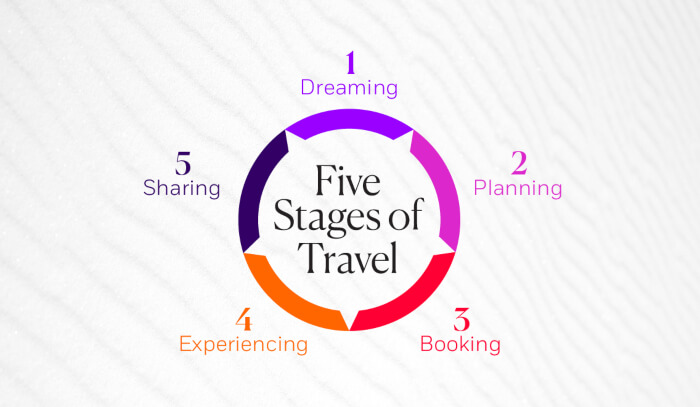
1. Inspiration
The possibilities start from the moment the user begins to explore options or ideas. Understanding what their motivations are will help you find the moment to activate your storytelling to amplify your value proposition. It would be best if you told them who you are, why you’re what they’re looking for you, your unique value proposition, etc. You can express it using SEO, Paid Media, Branded Content, social media, and more. The goal is to achieve brand awareness.
2. Planning
This phase is where the user’s choosing destinations, dates, flights, hotels, etc. They need detailed information that will help them opt for one option over another. They’ll surely be running Google searches, looking at forums on TripAdvisor, reading blogs, and more. You’ll be able to deliver information that meets their needs using the right segmentation. Multichannel workflows are your best ally for this stage.
3. Booking
The traveler’s already researched, and they’re ready to book flights, hotels, excursions, and everything else. In this stage, we need to offer them safety, make things easy, and a wide variety of options. While they may be using tour operators, you shouldn’t lose track of the metrics that will offer you valuable information for the future like average spend, loyalty, and more.
4. Experience
We’ve finally reached the most critical stage for the consumer: enjoying the trip and enjoying the experience. We need to meet their high expectations and even surpass them. This stage gives brands the chance to build a bond with the traveler offering them recommendations, proposals, and content that helps them enjoy their destination. It’s fundamental in this stage, and it provides us with a pivotal opportunity.
In one way or another, we always share our travel experiences with those around us. It used to be that we shared a photo album and now it’s on social media. You can invite users to share their experiences with the brand using brand advocacy programs or actions. This phase nurtures others’ inspiration, so you should always keep an eye on it. You can also run loyalty campaigns so guests come back on a future occasion.
Salesforce: technology at marketing’s service
It would be just about impossible to deploy an international marketing strategy with a 360° vision without having tools that help us segment, automate, and create workflows adapted to every market and audience.
One of our tools of choice is Salesforce Marketing Cloud since it lets you create 360° marketing campaigns using different channels and personalized messaging to guide your target customers towards the moment of purchase gradually. We can also interact with our audience bidirectionally, listen to conversations, and measure and optimize every interaction.
Marketing Cloud also has sub-clouds such as Journey Builder, Email Studio, Datorama, Social Studio, etc. that let us launch campaigns on different channels to reach users during the five stages mentioned above.
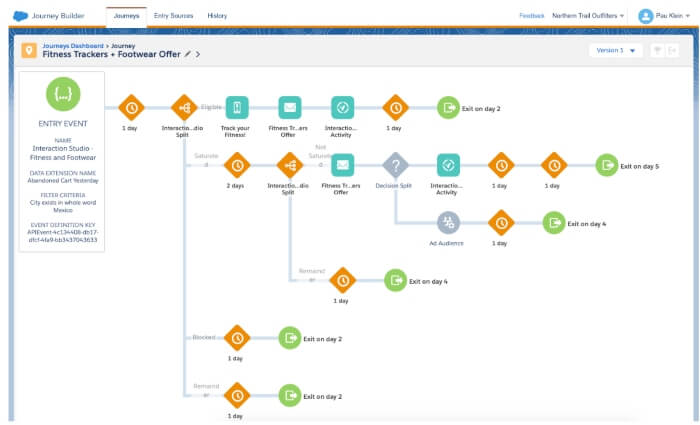
Keys to carrying out an optimal international tourism marketing strategy
Companies in the travel industry need to adapt to an increasingly globalized market with direct, fierce competition. Growing and moving beyond borders is an inherent practice in the industry, but regardless, we need to map out an international marketing strategy that maintains the brand essence, prioritizes the user experience, and preserves a 360° vision.
How can we get there? We’ve seen the theory but now we’ll take a step-by-step look at the points we need to include in your international marketing strategy :
1. Perform a situational analysis for your company
While performing a SWOT analysis is fundamental for any business, it’s never a bad idea to do it to see what are your enterprise’s strengths and weaknesses, as well as looking at the opportunities and threats to it. It’s a pivotal step to draw out this map that shows the market we’re in, what resources we have, what’s our target’s attitude towards our product or service, and more.
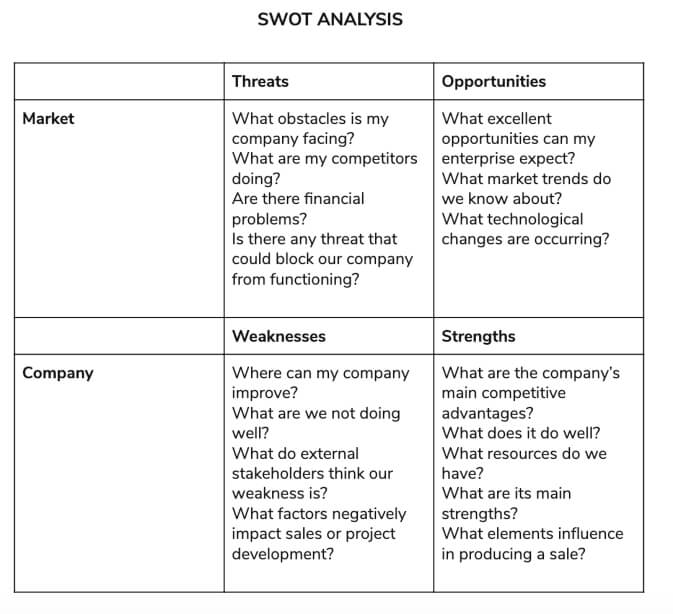
2. Set SMART goals
If you successfully define business goals , you’ll be closer to creating the right actions for your travel company and measure their performance. Follow the SMART method to create specific, measurable, attainable, realistic, and time-based goals for the timeframe you’re looking at, whether it be for the month, quarter, or year.

3. Analyze the markets
When a brand has a presence in multiple markets, it should look at each market separately and treat them as such; The consumption habits, preferences, and interests can vary significantly from one country to another, making it imperative that we know them so we can offer our product or service offering accordingly.
4. Study the different buyer personas
Carefully examine the type of people interested in your company and create your buyer personas . You’ll increase your chances of success in the market and be able to position yourself as a brand of reference if you know who you’re targeting. The Buyer Persona Institute defines 11 Buyer Persona profiles for the travel industry.
A global strategy has to take cultural nuances into considerations, the national or regional deviances, customs, linguistic factors, etc. to ensure the content they’re transmitting in the local language successfully empathizes with their target.
5. A content strategy adapted to the market and buyer persona
Have presence and share one-of-a-kind, compelling content on the platforms that are the most accessible or those where your audience already is. These pieces of content need to provide added value that will attract your customers, and you need to disseminate them in many formats: blog posts, social media posts, photos, videos, newsletters, interviews, and more.
6. Transcreation
When working on content for your global strategy, you need to adapt your content to every market. That means mere translation doesn’t cut it. We have to transcreate to ensure our content contains the necessary sociocultural and sociolinguistic nuances to connect to our target authentically. We’ll need to count on native speaking content writers.
An SEO strategy will give you the keys to boost your positioning on the internet, have g reater visibility , and turn yourself into a formidable industry player. Yet, we need to adapt our keyword research to every market and buyer persona to reap the benefits.
8. Measuring and analyzing the performance
Measuring and analyzing performance results is fundamental for us to find out if our strategy is working, what we need to improve, and what actions we should suspend. You should set your KPIs and track metrics that help you gain a realistic vision of the status of your business .
Every market is different, with its specific needs and preferences, meaning we need to develop an adaptable strategy for every local market (without losing the corporate essence) to position ourselves better. If every traveler’s different, why wouldn’t we do the same with every market, which is the sum of many tourists?
Subscribe to our newsletter and stay up to date with the latest digital trends.
Apr 06, 2022
The Scrum Framework and What it Does
Apr 30, 2021
Virtual Teams & the Agile Methodology and Scrum: The Partnership of the Future
Feb 11, 2021
Strategies to generate effective leads in your company

Tourism Marketing Plan

After the Cold War, the world became more involved in Tourism. The peace of the 21st Century has been the cause of this industry’s explosion. However, since this industry became more apparent in a country’s economy, many businesses sprout left and right to fill in the void. That’s why having a clear marketing plan whilst venturing into this industry is necessary. For that, we have 10+ Tourism Marketing Plan Examples that will surely help you scale up your marketing effort and deliver sizable marketing for your company . We also provided an excellent guide to help you create one. Check them down now.
10+ Tourism Marketing Plan Examples
1. tourism marketing plan template.
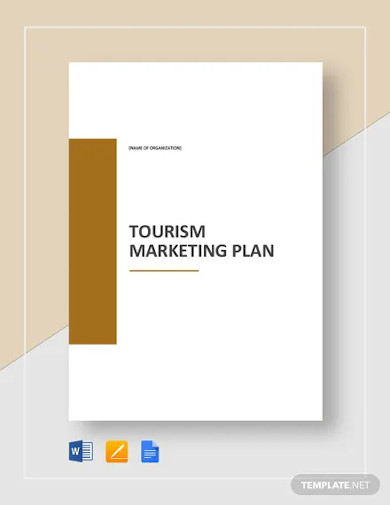
- Google Docs
Size: A4, US
2. Travel Agency Marketing Plan Template
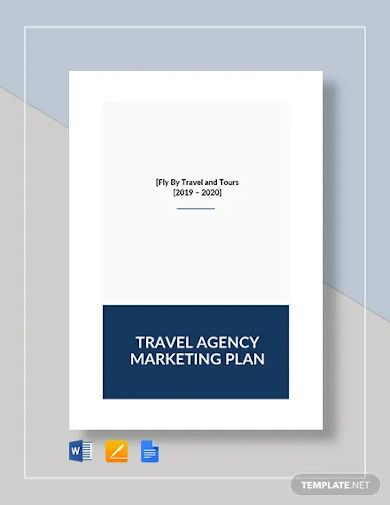
3. Tourism Marketing Plan Example
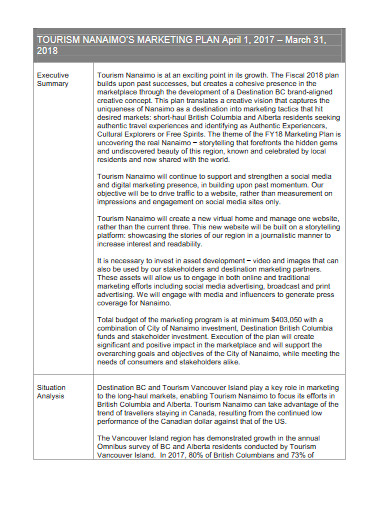
Size: 400 KB
4. Sample Tourism Marketing Plan
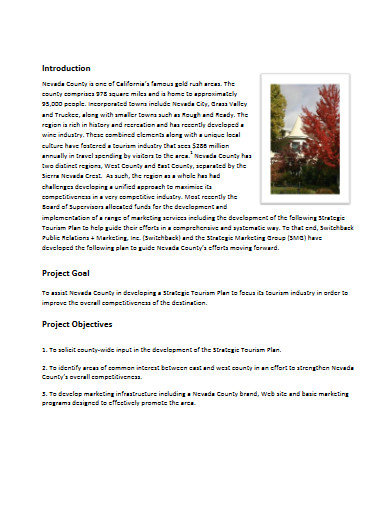
5. Plan for Tourism Marketing
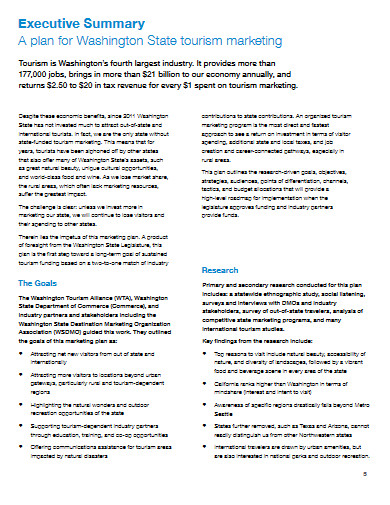
6. Tourism 5-Year Marketing Plan
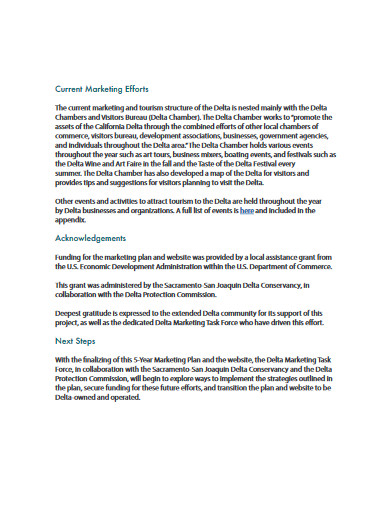
7. Simple Tourism Marketing Plan
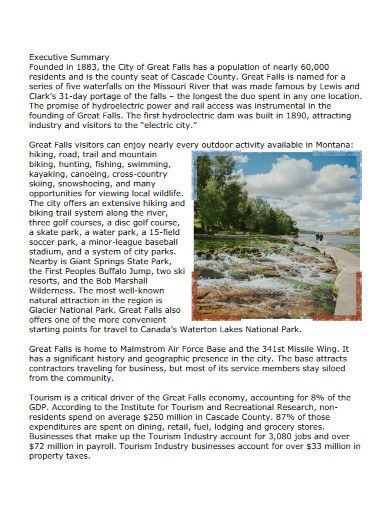
8. Tourism Marketing Plan in PDF
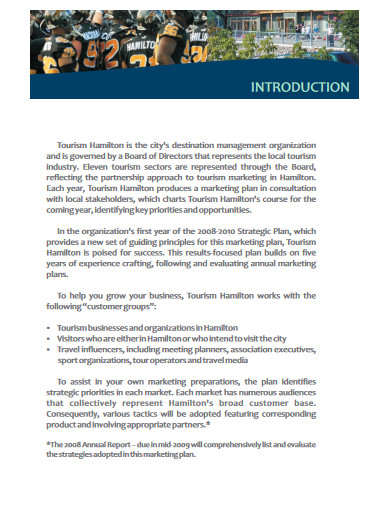
9. Tourism Development and Marketing Plan

Size: 10 MB
10. Tourism Strategic Marketing Plan
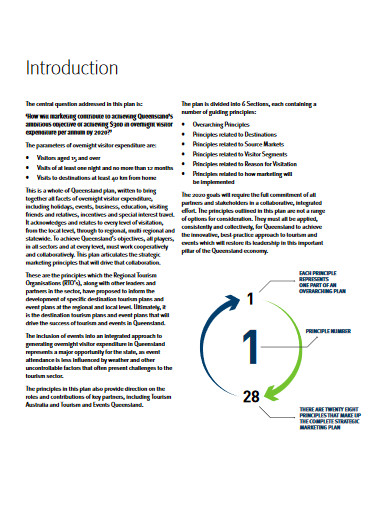
11. Basic Tourism Marketing Plan
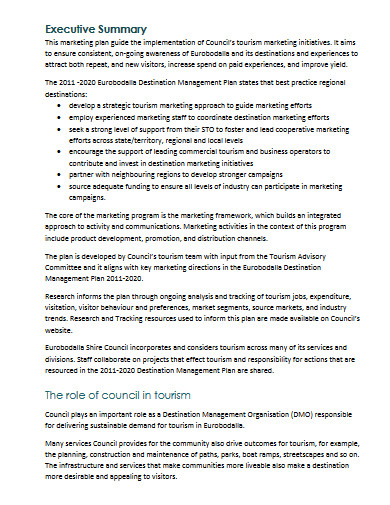
What is a Tourism Marketing Plan?
A Tourism Marketing Plan is a report document that people in the tourism industry uses to scale up or improve their marketing efforts. This document provides strategies and tactics to improve the current marketing efforts of the company. In this way, the company can catch up to the competition’s standards and take more customers.
What are the three types of tourism?
Nowadays, tourists are everywhere. Sometimes, they pop up into your favorite store , while at other times, you see them adorning a landmark you always forget to notice. Nonetheless, for people within the tourism industry, there are at least three basic types of tourism, and these are written below.
Domestic Tourism involves people of the same country traveling within the country either for professional or personal reasons. Depending on the nation you are in, domestic tourism could be your main business facet.
Inbound Tourism is a type of tourism that involves people from other country vising your country for professional or personal reasons. This type of tourism sometimes has a duration; that’s why it is quick most of the time. If the person decides to stay for work, then this will no longer be considered tourism.
Outbound Tourism is the same as inbound but is only the opposite. This type of tourism involves someone from your country, visiting another country for personal or professional reasons.
How to Create a Tourism Marketing Plan
Marketing is one of the most important aspects of business, especially small businesses and social media, because these industries need advertising more, and both are flexible. However, the tourism business is also in need of this if you want your business to stand out. So to help you create one, these steps are provided below.
Step 1: Executive Summary
Executive Summaries is as icing is to the cake. They are there to invite people to read through the topic more. An executive summary is a concise version of the whole plan . It incorporates all of the parts of the marketing plan into a page or two, which shows everyone the rationale behind the whole endeavor and its subsequent produce.
Step 2: Goals
The next thing you need to do is to set business goals for the whole campaign. You should make sure that you have specific metrics or data on why you decided to create such an objective. Ambition is good, and being hopeful is excellent. However, when it comes to business, you needed to balance both heart and mind. That’s why it is necessary for your plans to be SMART (Specific, Measurable, Achievable, Realistic, and Time-bound). Things you need to note are your target market, your competition, and your metrics in knowing how you are faring compared to the main goal.
Step 3: Action Plans
Since you now have a general idea of what the market is like and what you want to do, you should now include an action plan to tell people how you can do it. This is necessary because, without action, any plans and strategy you have will only end up a corporate wish. So make sure you have a proper action plan.
Step 4: Communication Plan
Sometimes people end this whole planning with the action plans, and that’s why they fail. They have a detailed analysis of the key problems, an outline of the tactics, but because there’s no communication plan, the team would find it difficult to progress. Some say write an email, while others want to provide a full report , then other times people send two identical reports that only consumes time. That’s why the point here is that a communication plan is necessary, so you can go on your international travel and not get lost in what’s happening with the project .
What are the seven elements of a marketing plan?
The seven elements of a marketing plan are:
1. Market Research 2. Target Market 3. Metrics 4. Budget 5. Positioning 6. Marketing Strategy 7. Competitive Analysis
What is tourism marketing?
Tourism Marketing is a method of business that creates a sense of cooperation between businesses in the industry. Depending on the level of their business, they may coordinate at the regional, national, and international levels of the business. The key idea of tourism marketing is to ensure that the tourist has the service they require in their travels.
Who is the father of tourism?
Thomas Cook is the father of tourism. He started his first traveling business in 1841 when he planned an excursion for 570 people to a rally in Loughborough. He even made the first holiday brochures.
Any sample or template can help you create a good presentation. However, if you want to venture into this industry, you need grit and a whole lot of it. Starting from scratch is never easy. Nonetheless, with an excellent idea and a detailed action plan, you’ll be like Thomas Cook, planning himself into stardom.
Text prompt
- Instructive
- Professional
Create a study plan for final exams in high school
Develop a project timeline for a middle school science fair.

IMAGES
VIDEO
COMMENTS
Tourism marketing is essential to drive success to a company in the tourism industry. Across different industries, most businesses acknowledge the importance of marketing. Yet, every industry has its challenges and doubts. Marketing strategies need to fit your industry like a glove. So, for those working in the tourism industry, this article will tackle everything related to the best practices ...
How to write a tourism marketing plan. 1. Run a SWOT analysis. A SWOT analysis is a fun exercise that identifies your company's S trengths, W eaknesses, O pportunities, and T hreats. Strengths and Weaknesses are internal factors that you can control, like your team, resources, and location.
The tourism landscape is ever-changing, and so are tourism marketing strategies. We have compiled a list of 14 essential tourism marketing strategies that tour and activity providers can use to fuel their business growth in 2021 and beyond. ... For those unfamiliar with Google My Business (GMB), it is a free tool that enables you to control how ...
A tourism marketing strategy is a well-thought-out plan that outlines how a business in the travel sector will reach and engage its target audience. ... Set clear business goals for your tourism marketing strategy, whether focusing on increasing online bookings, boosting social media engagement, or enhancing customer experiences. ...
Effective tourism marketing begins with a deep understanding of your target audience. To attract and engage potential visitors, it's vital to recognize their preferences and interests. Some are attracted to cultural heritage, while others seek vibrant nightlife or culinary experiences. To understand a range of demographics, conduct thorough ...
Create content and track, test, and tweak the ROI (return on investment) Measure the effectiveness of each marketing campaign. Reach more of your target audience. Boost your customer base. And ultimately, increase sales. Marketing and specifically, having a PLAN for your marketing is crucial to the success of your tourism business. Think of it ...
So make sure you know exactly who that is. 2. Create Clear Goals. Your marketing strategy should have very clear goals. This way, you'll be able to measure whether your marketing is effective or whether you need to reassess your strategy to help reach your goals. Each goal that you come up with should be a SMART goal:
Step one: set company goals. Step two: collect information. Step three: create a plan. Execute, measure, and win. Marketing Planning Should Excite You. Here's Why. Imagine that you're about to build your dream home. You found the perfect lot and location.
Step 3: Know Your Customers. It's imperative to be close to your data when developing a marketing strategy. In order to do this, you need a customer relationship management system (CRM). A CRM will help you accurately track your company's interactions with a current or potential customer.
Outline Your Value Proposition. You need to understand specifically what value your business brings to your customers. If you offer a travel service, you'll want to understand exactly what your clients receive and how this is different from your competitors. You need to make a worthy argument for why a traveler should come to you.
Construct a tourism marketing strategy that takes into account the nuances of your services. This mix should involve a strategic selection of your offerings, ideal booking avenues, pricing mechanisms, and promotional activities. Additionally, weigh in on the personal touch your team brings and the operational plans in place to ensure memorable ...
Craft your tourism marketing strategy. Focusing on these five features gives you a simple plan for your tourism advertising and digital marketing. Set a target date for having each element in place, and soon you'll be introducing your brand to travelers and turning them into loyal customers. Share with your network.
Significance Of Tourism Marketing. In 2023, the online travel market generated more than 2/3rds of the total revenue in the travel and tourism industry.. With over 83% of US adults preferring to make their bookings online, the digital space is THE place you should capitalize on.. There are various reasons why people prefer to plan their trips online, and understanding those reasons should ...
A travel and tourism marketing plan will help you reach new customers and protect the future of your business, no matter what its size. Travel is big business in Canada. Tourism spending in the first quarter of 2023 surpassed $20 billion, an increase of 2.6 per cent over the previous quarter. While these numbers are good news, travel and ...
Tourism marketing refers to the marketing strategies that different components of the tourism industry use to sell their products and services. The businesses include hotels, airlines, car rental companies, restaurants and travel or tour agencies selling flights, holidays, hotel rooms or experiences to customers.
Your travel marketing strategies can span social media, paid marketing, local content, seasonal SEO, content marketing, and beyond. Customer personas are important for effective travel marketing. For example, our survey data shows that 88% of people either try somewhat (45%) or very hard (43%) to save money while traveling.
Here are a few basic tips to help you create a content and SEO strategy for your tourism marketing plan. Include a blog on your website and publish content that provides valuable information for your target audience: According to Ascend2, 72 percent of marketers say that creating relevant content was the most effective SEO tactic.
1) Keep The Target Audience Front And Centre. This might sound like a lesson from Marketing 101, but it's one that is often forgotten. It's impossible to create a successful campaign without knowing who it's designed to serve. This is just as true for companies in the travel and tourism space as it is for any other industry.
Optimizing customer experiences on all marketing channels is crucial. 15. Embracing content and influencer marketing. Content and influencer marketing are essential building blocks of any successful tourism strategy. It helps in optimizing the presence of a travel business in the search engine.
Destination marketing strategies and best practices. Drive travel and tourism to your destination by showing consumers what makes it better than the alternative. Increase awareness about your region and strengthen its reputation with these marketing strategies: 1. Define your destination's unique selling point (USP).
4. Study the different buyer personas. Carefully examine the type of people interested in your company and create your buyer personas. You'll increase your chances of success in the market and be able to position yourself as a brand of reference if you know who you're targeting.
Key Elements of a Marketing Plan. Developing a marketing plan requires you to think in terms of using diverse approaches to communicating about your business (i.e., marketing mix). An effective ecotourism marketing mix includes the four Ps (i.e., product, price, promotion, and place) of business marketing (Perreault and McCarthy 2002) and three ...
A Tourism Marketing Plan is a report document that people in the tourism industry uses to scale up or improve their marketing efforts. This document provides strategies and tactics to improve the current marketing efforts of the company. In this way, the company can catch up to the competition's standards and take more customers.